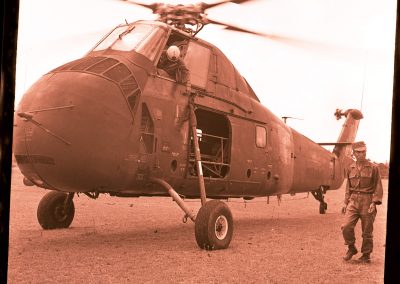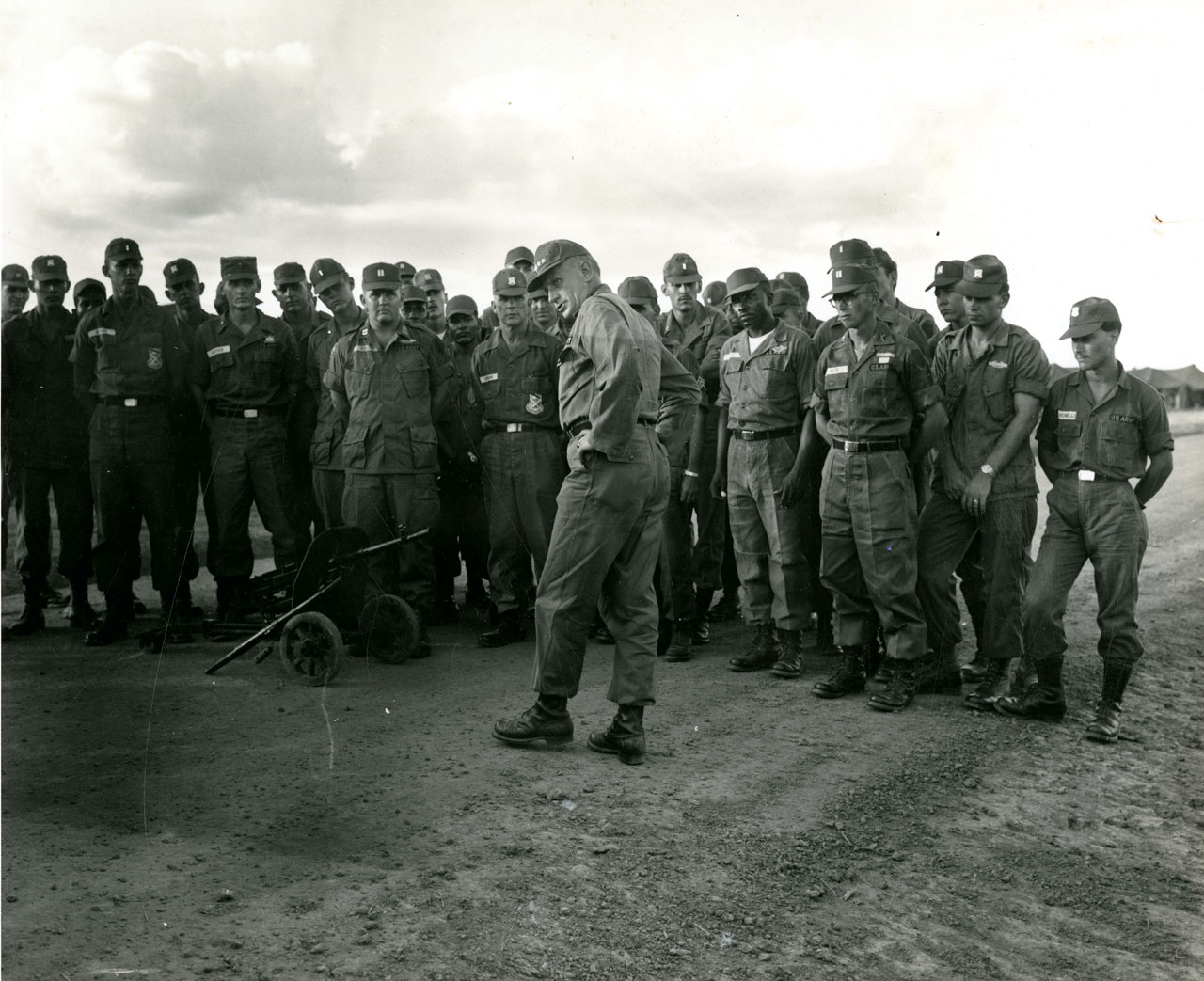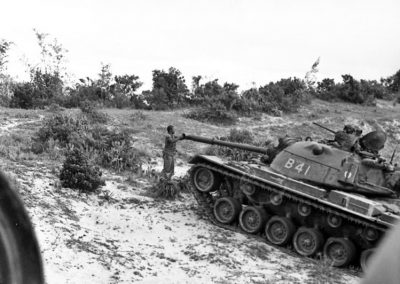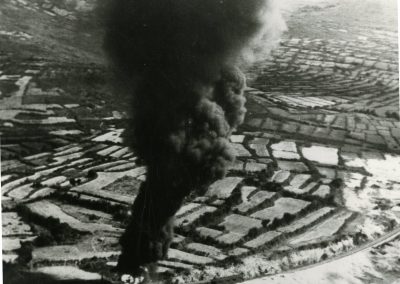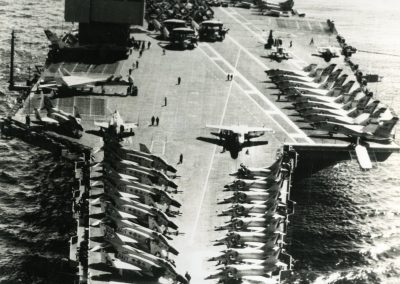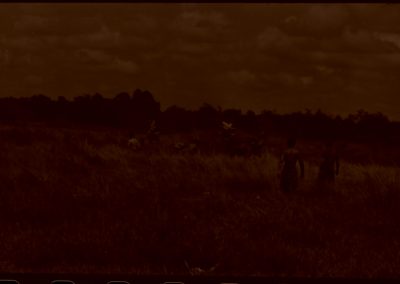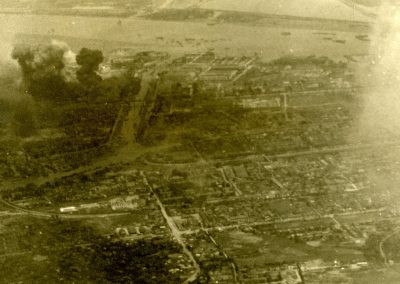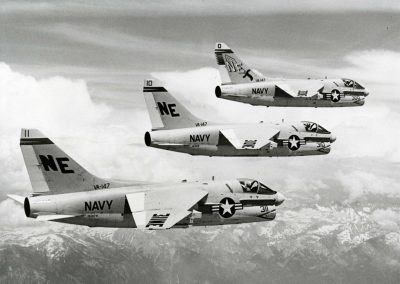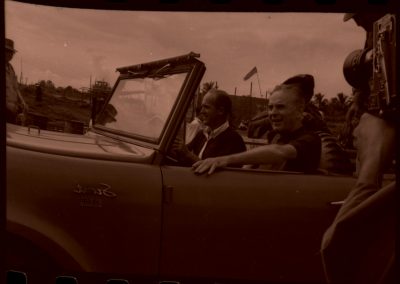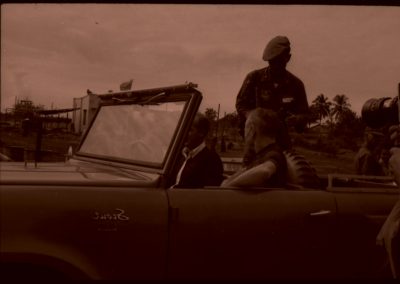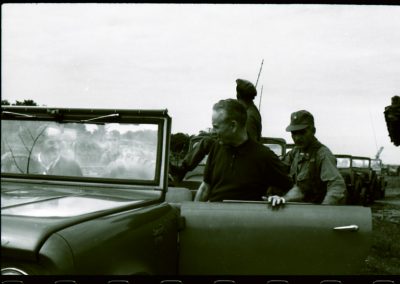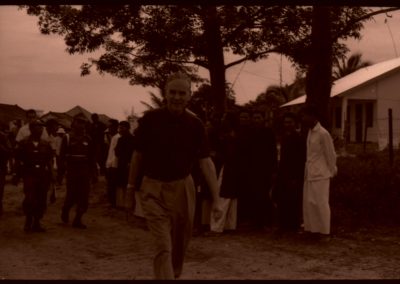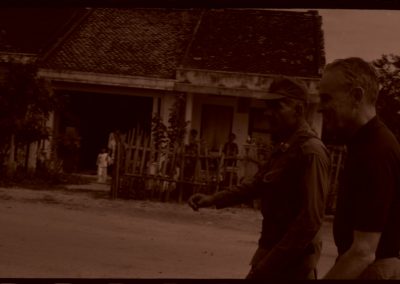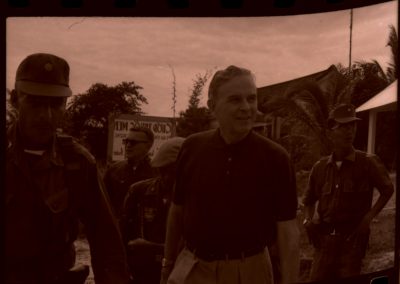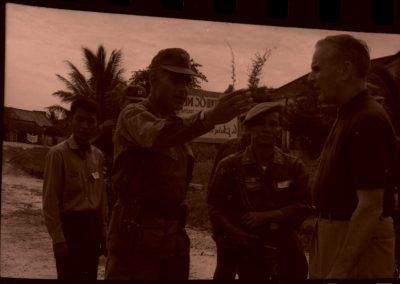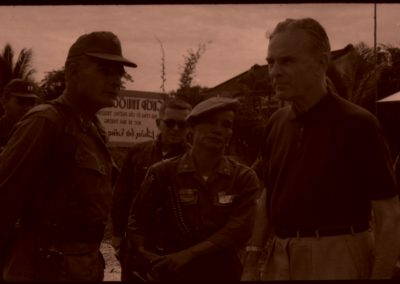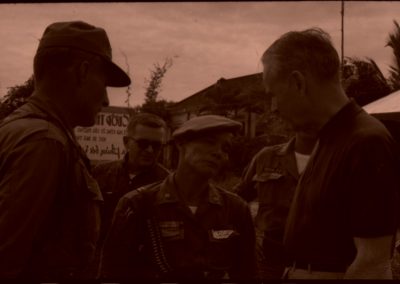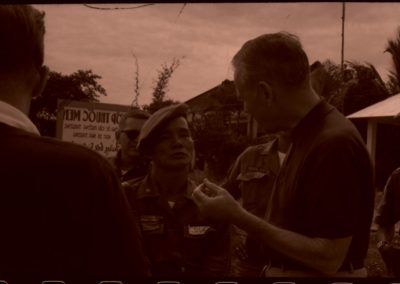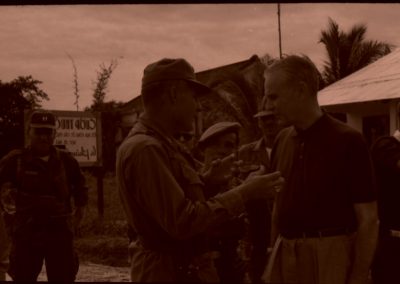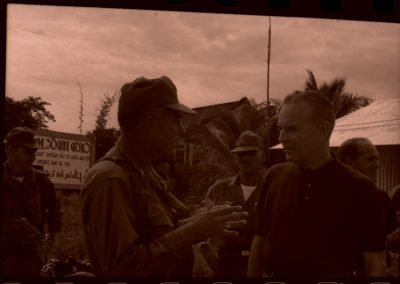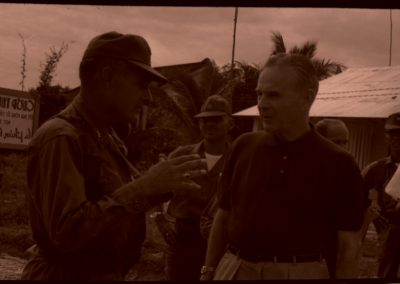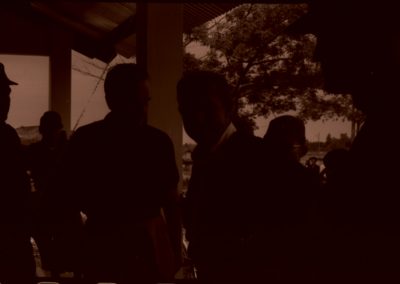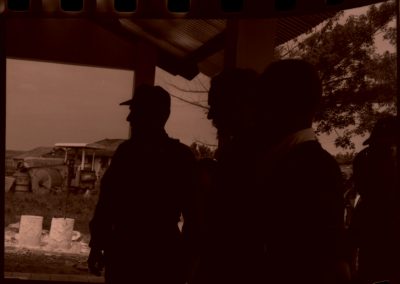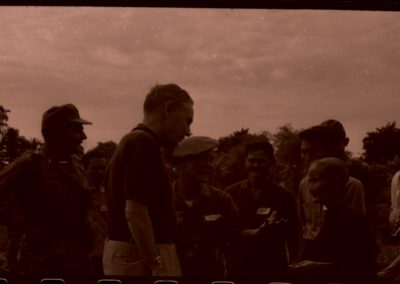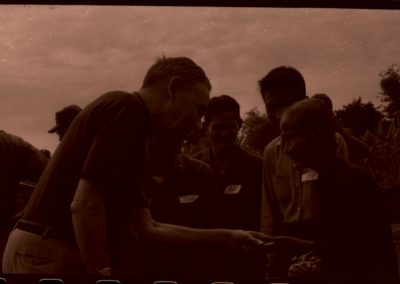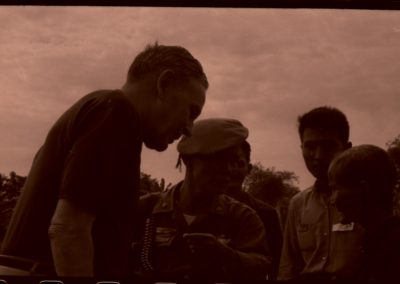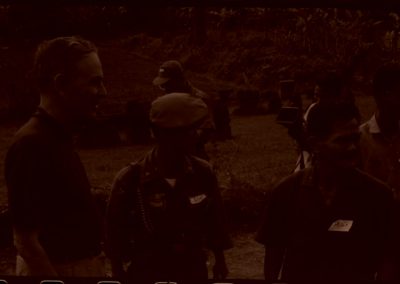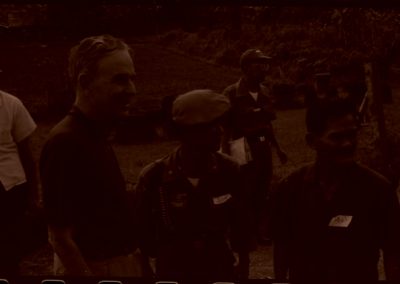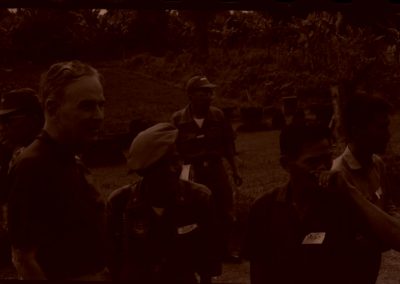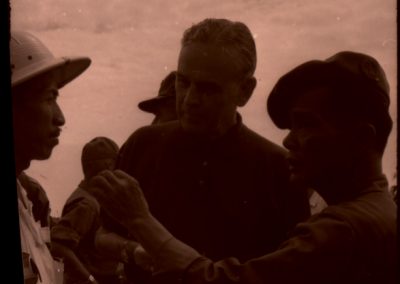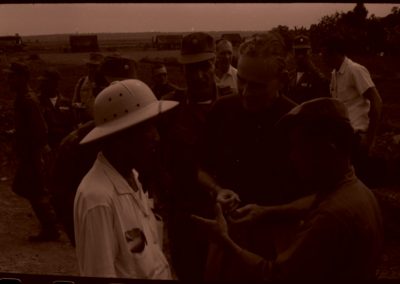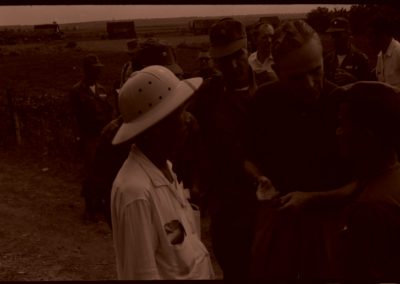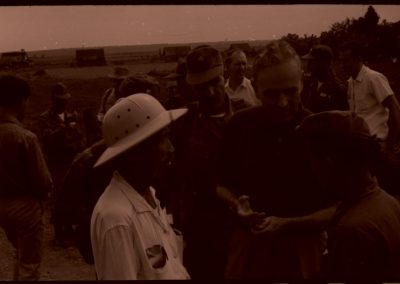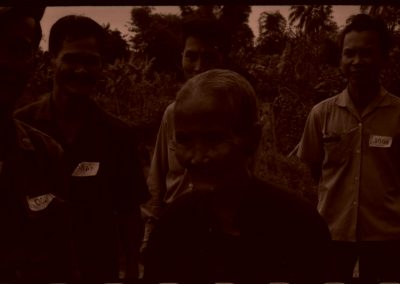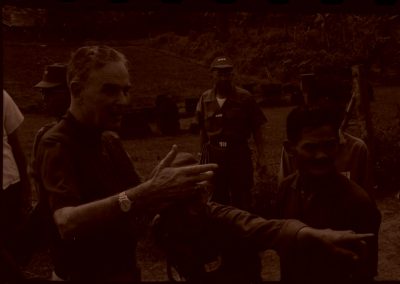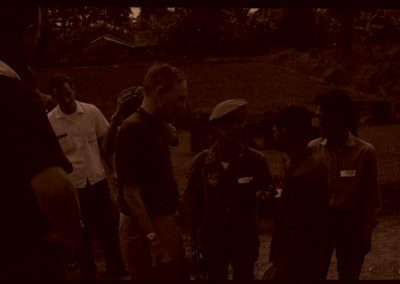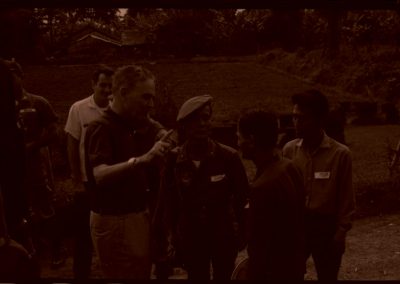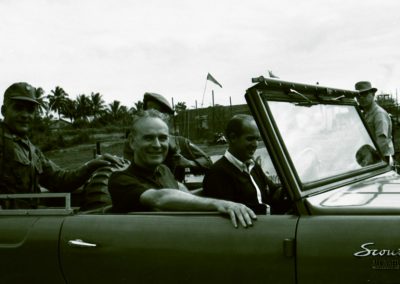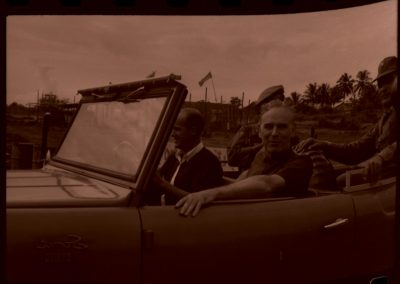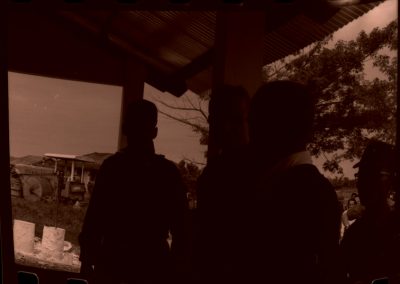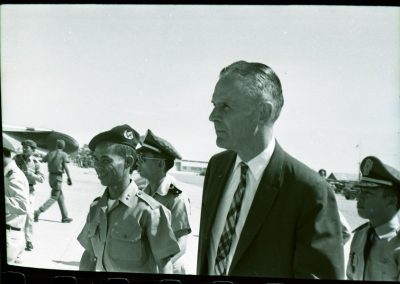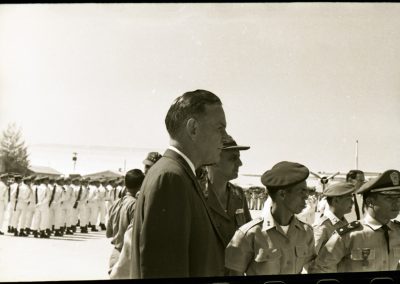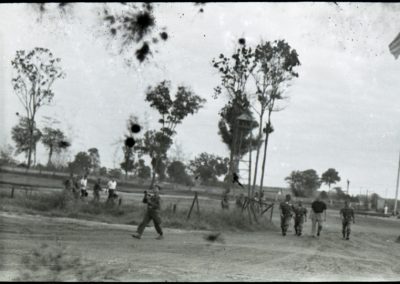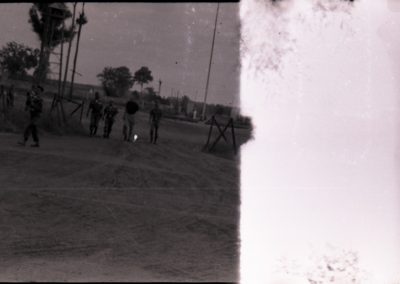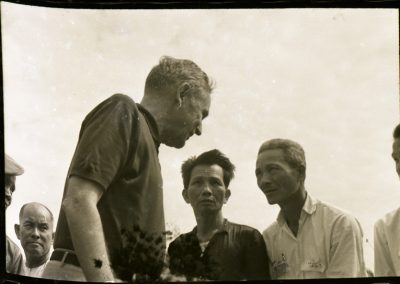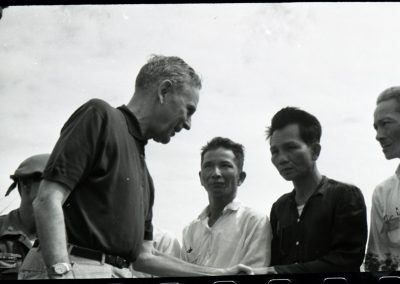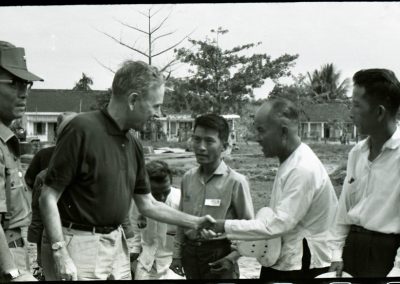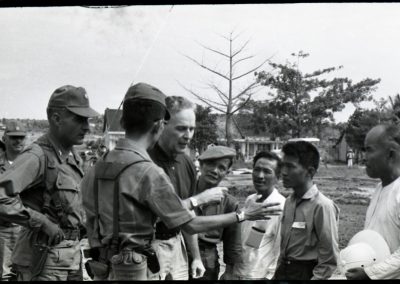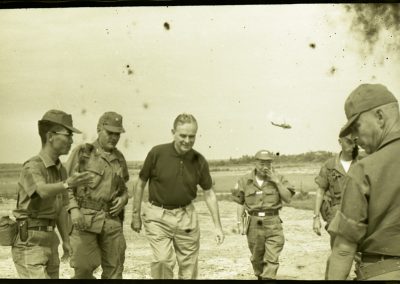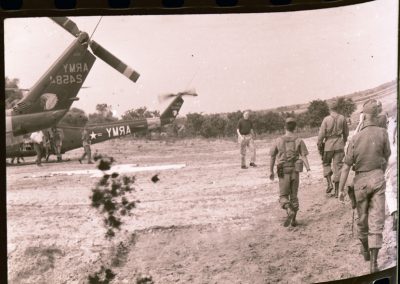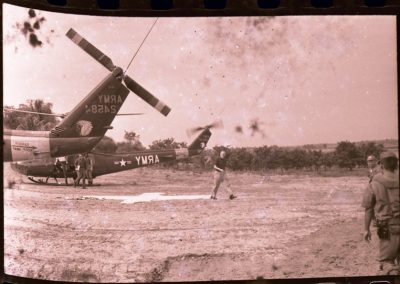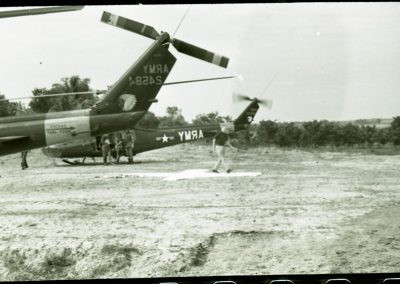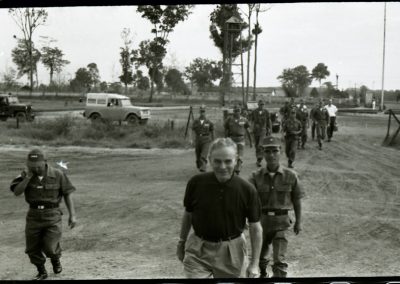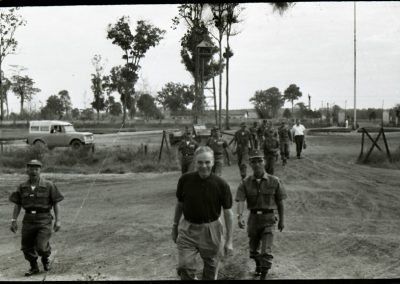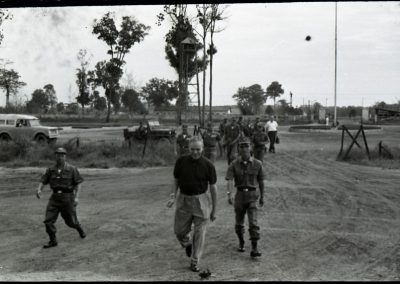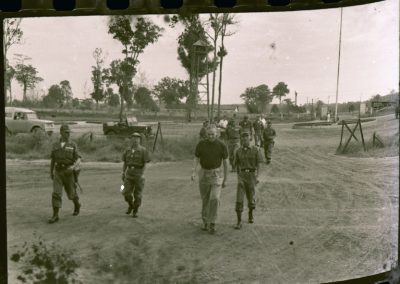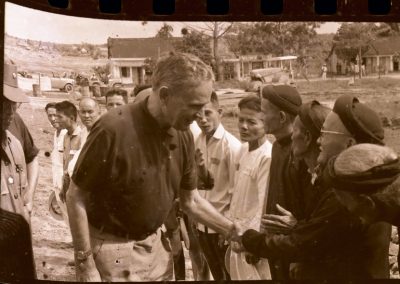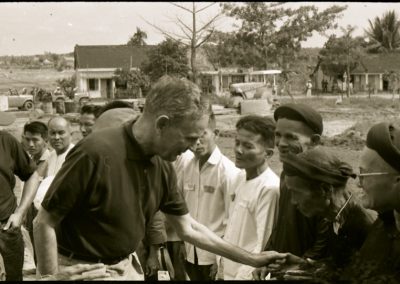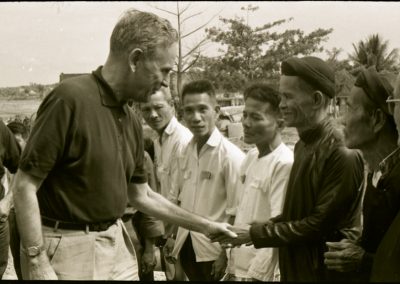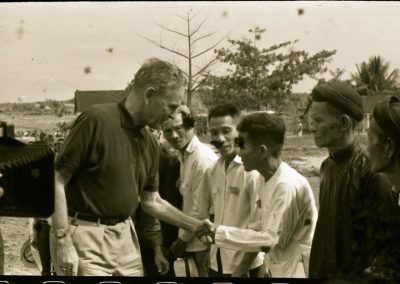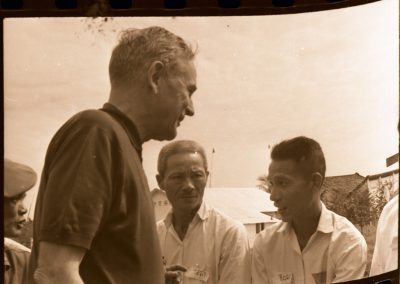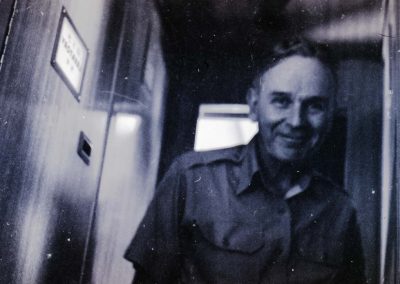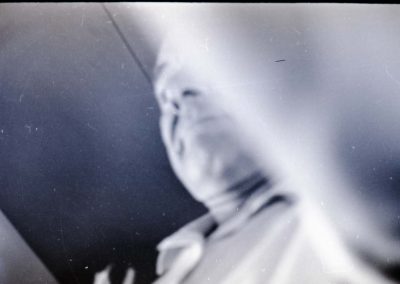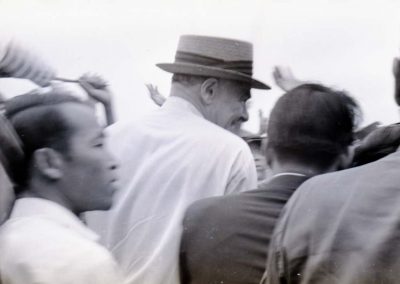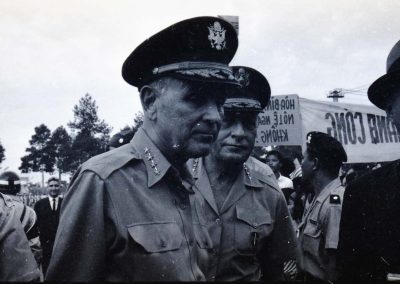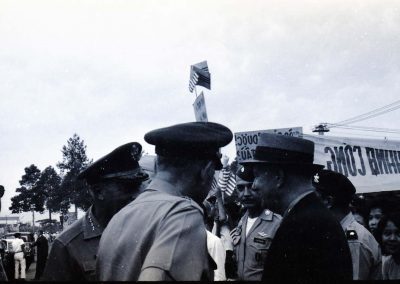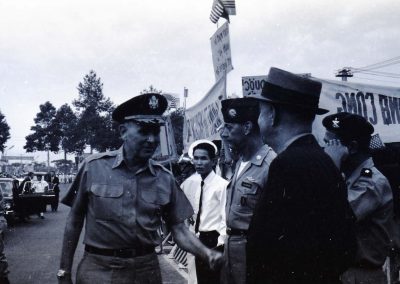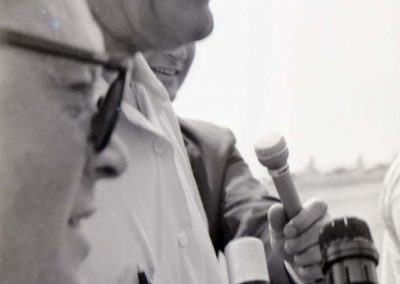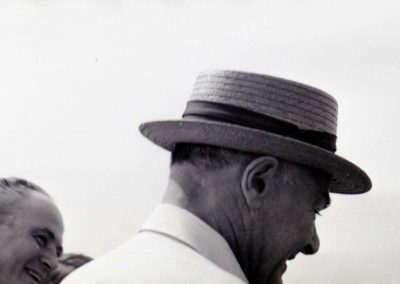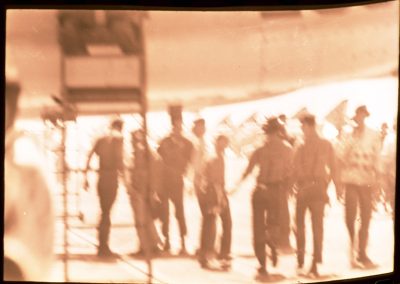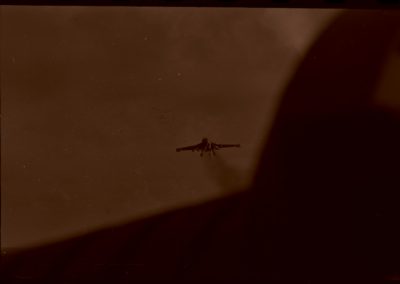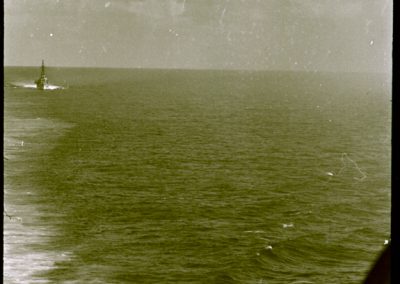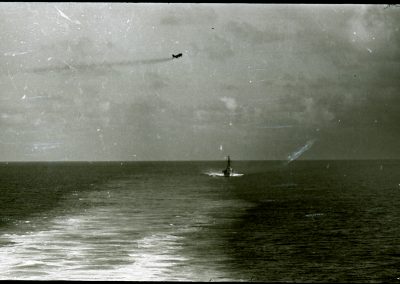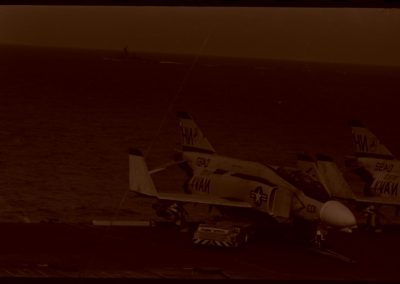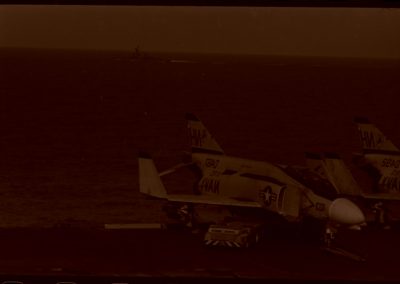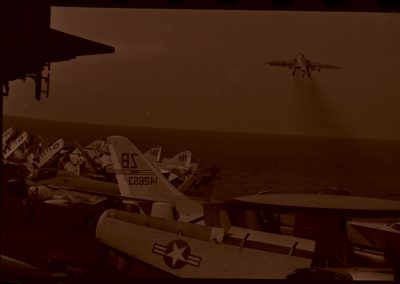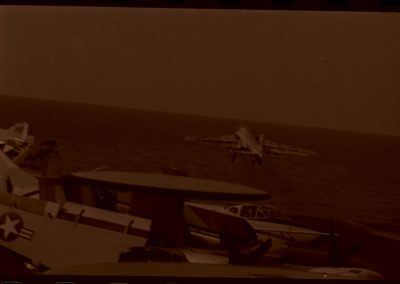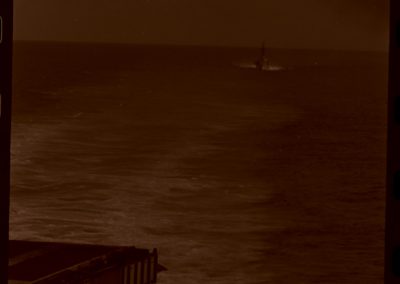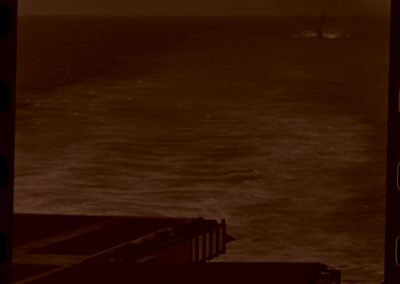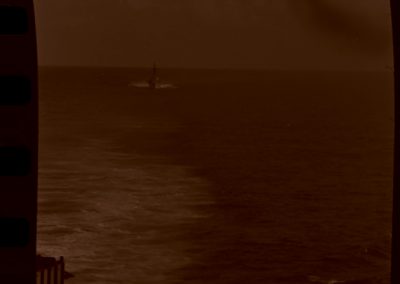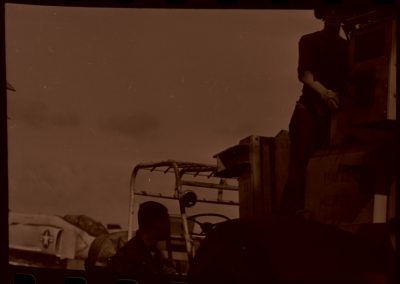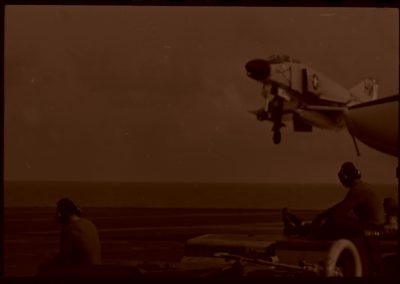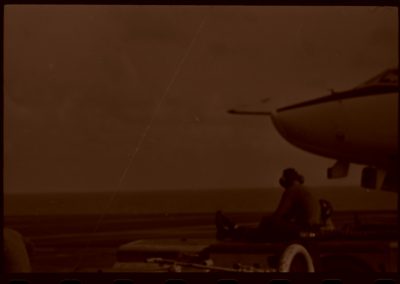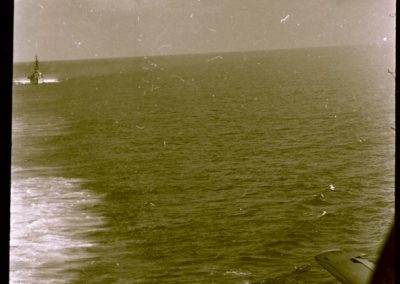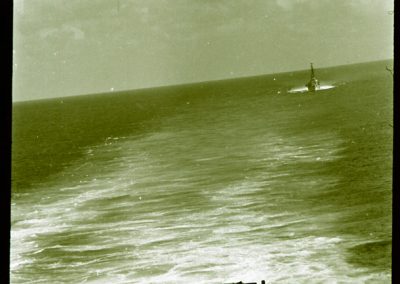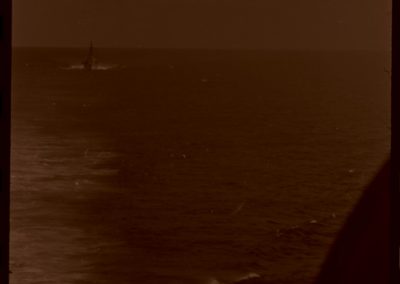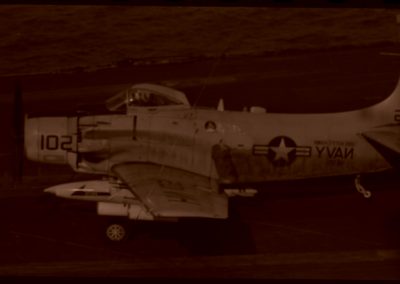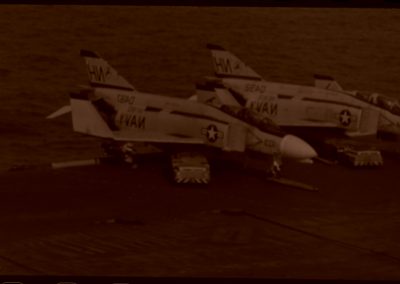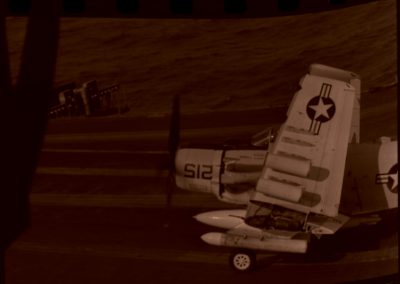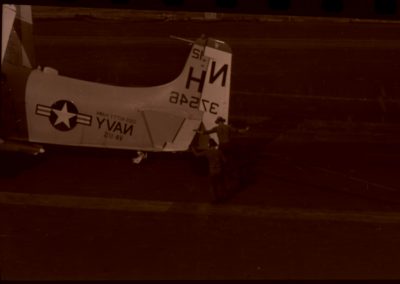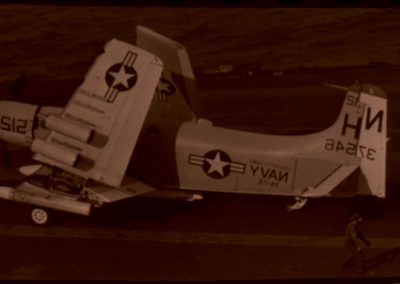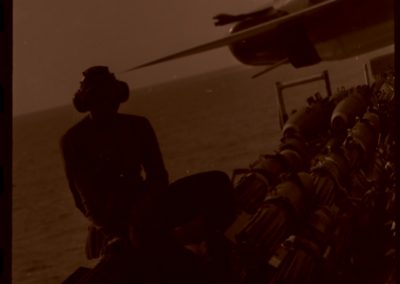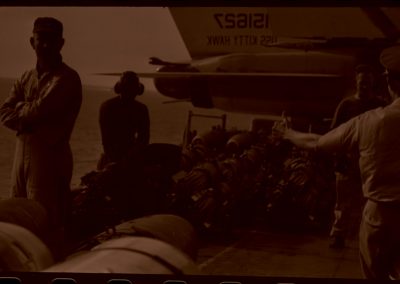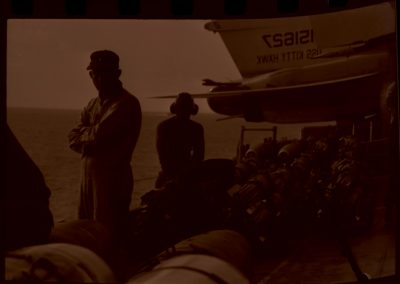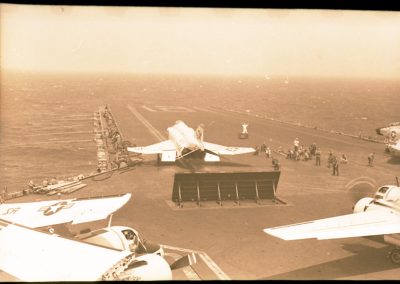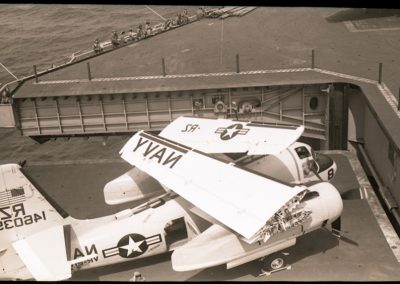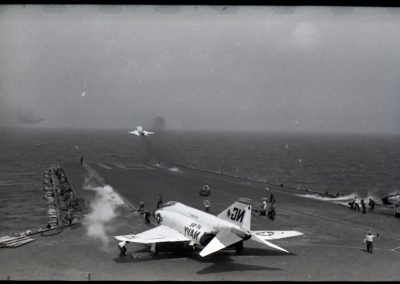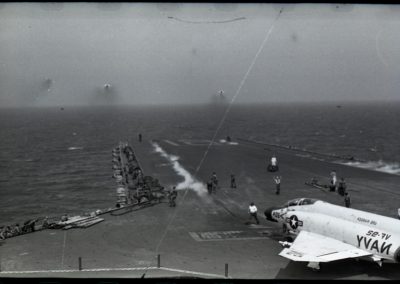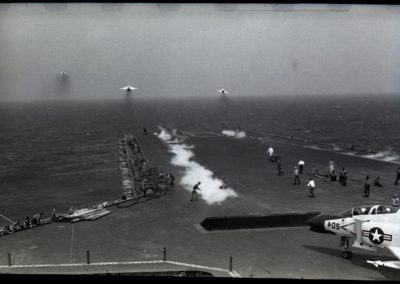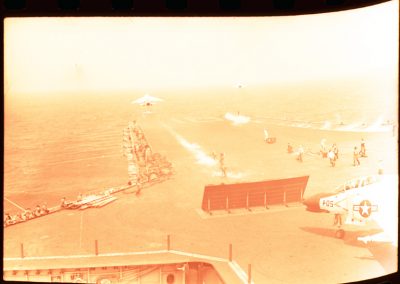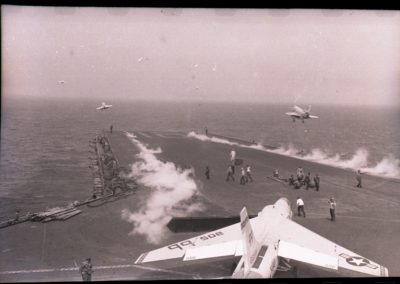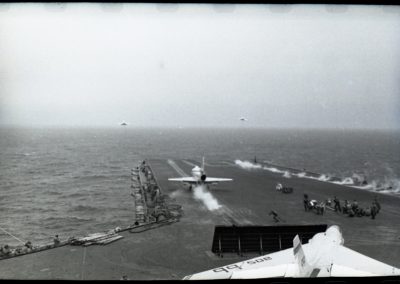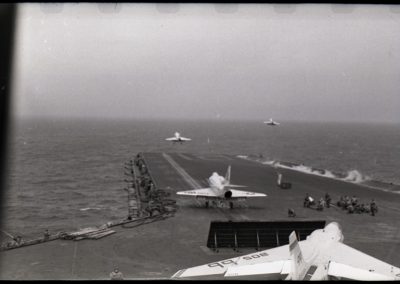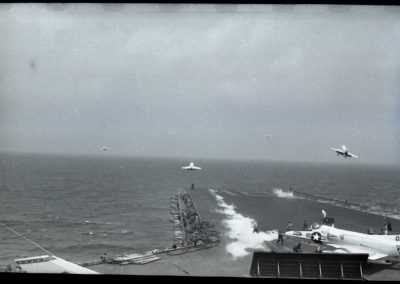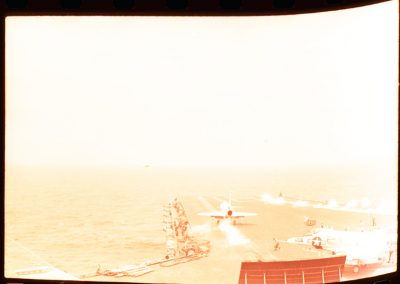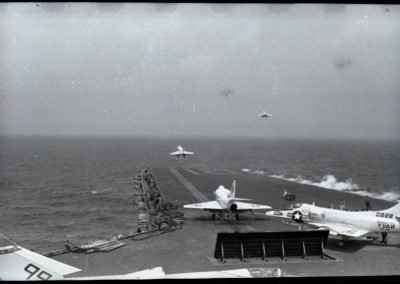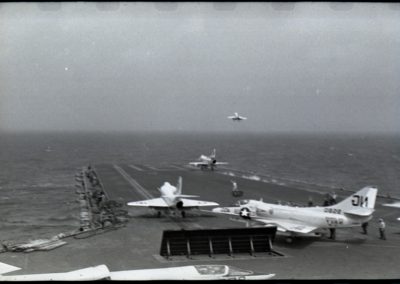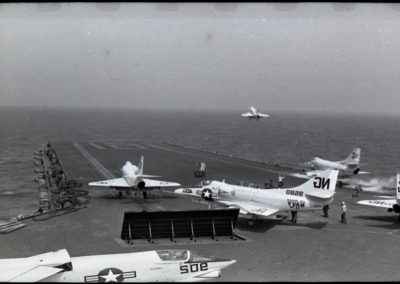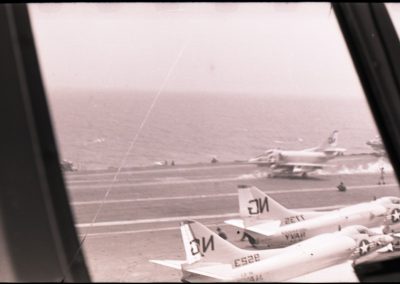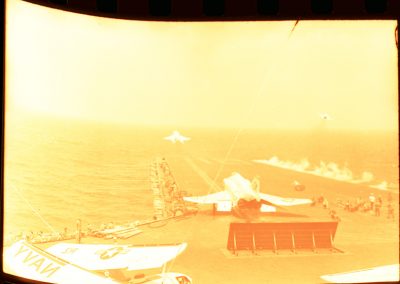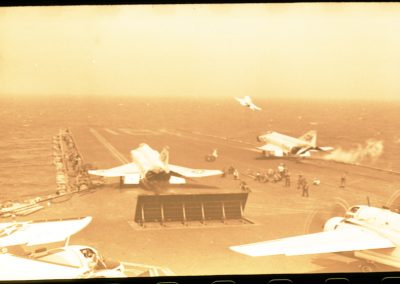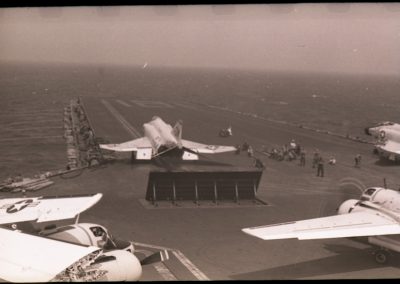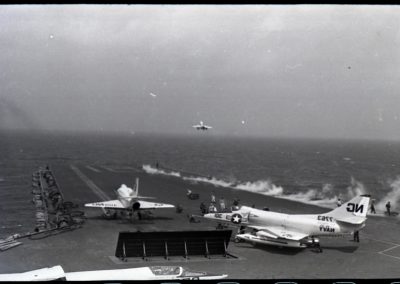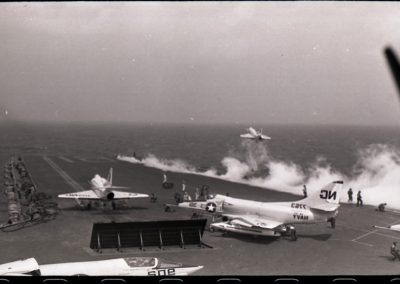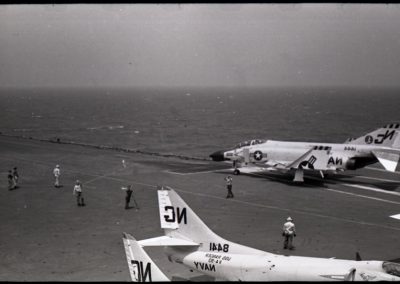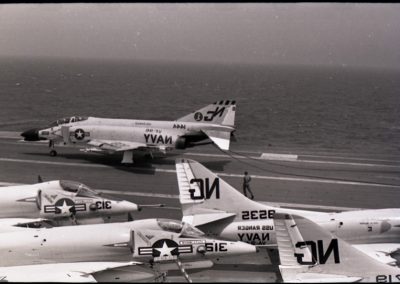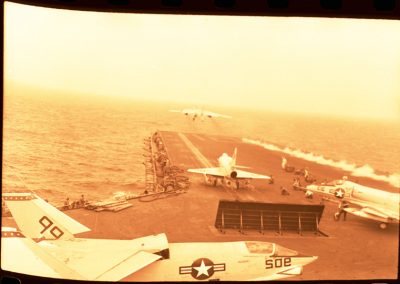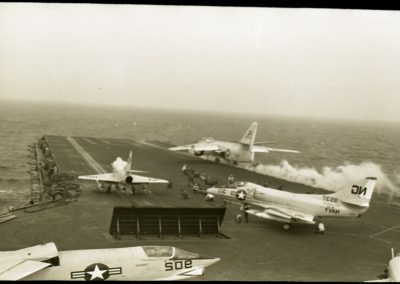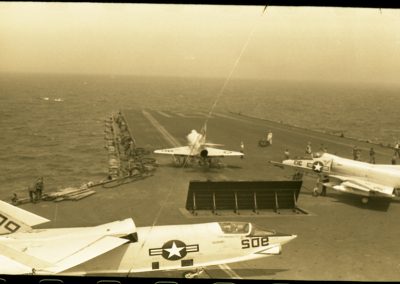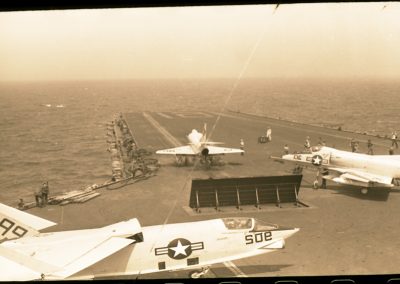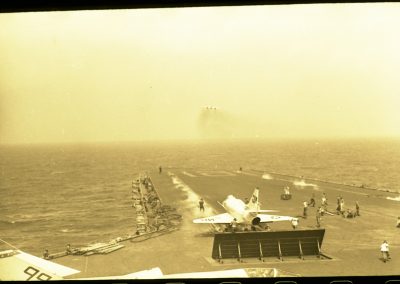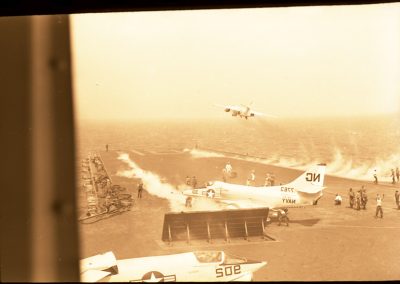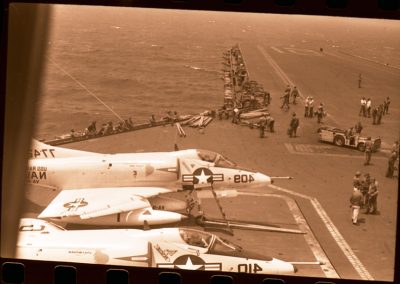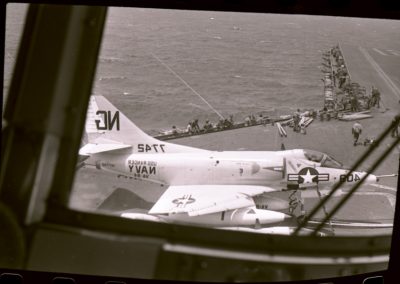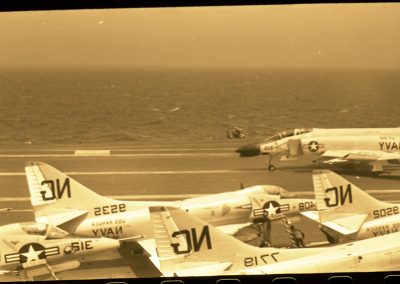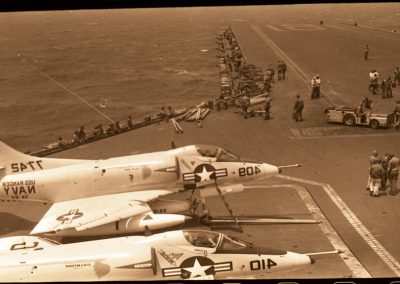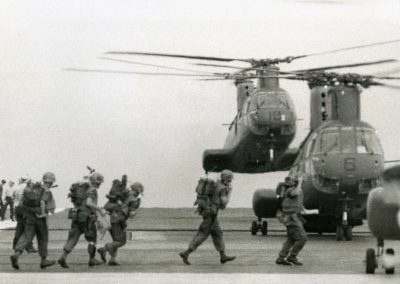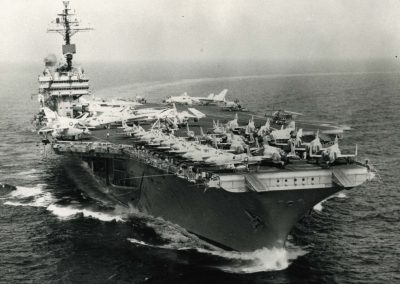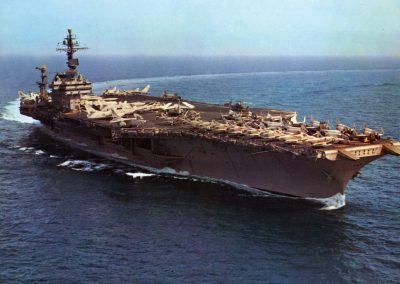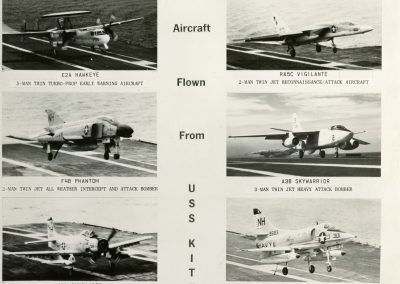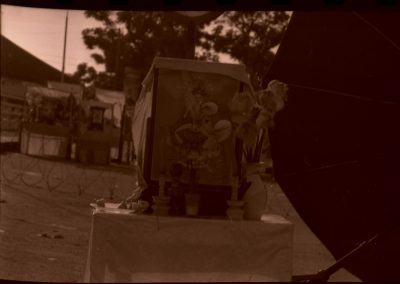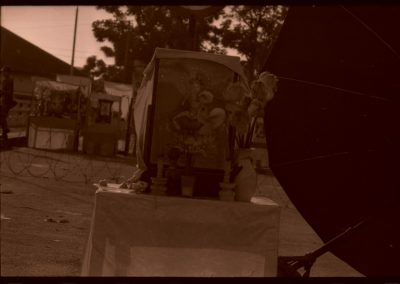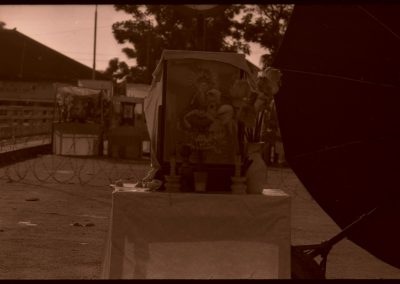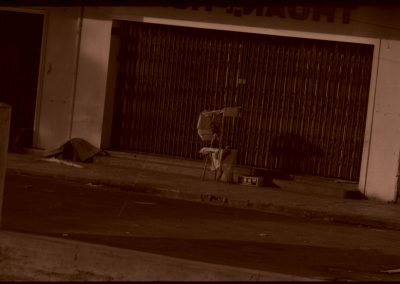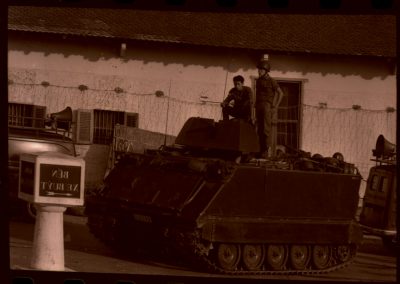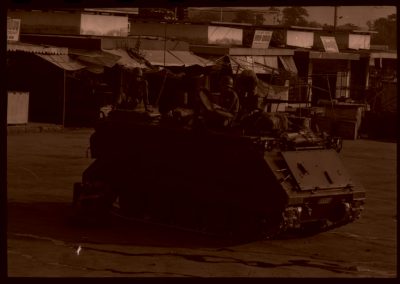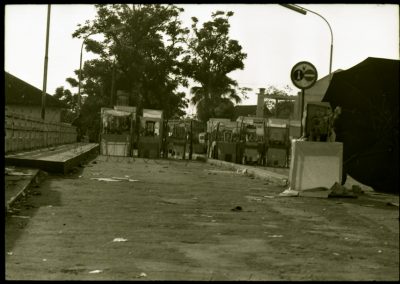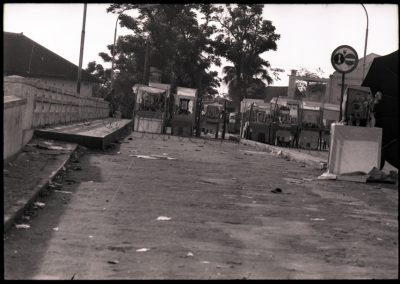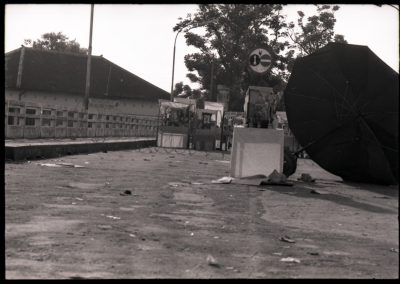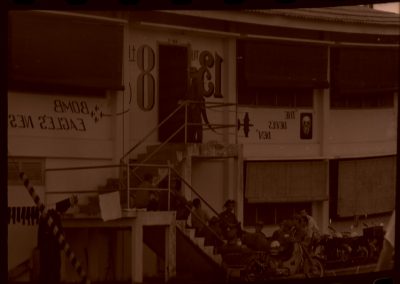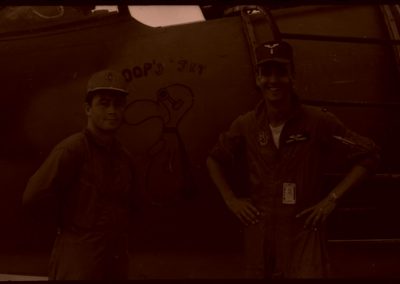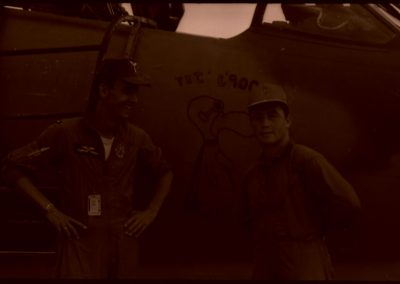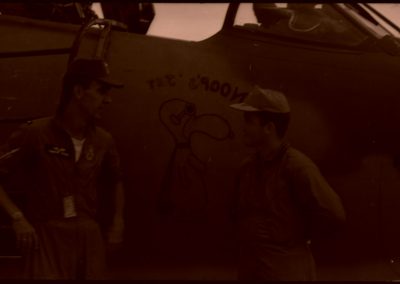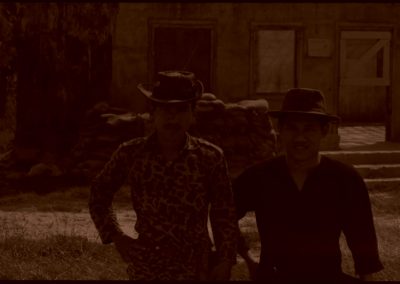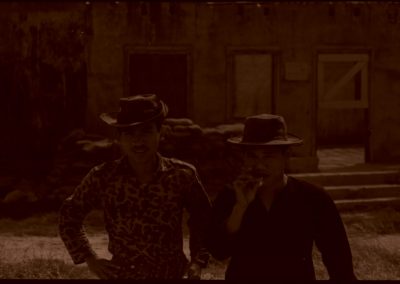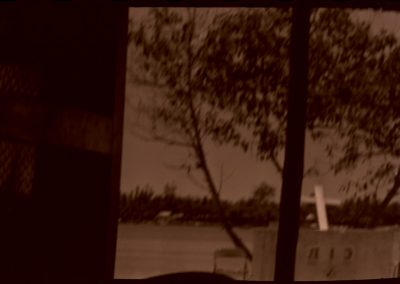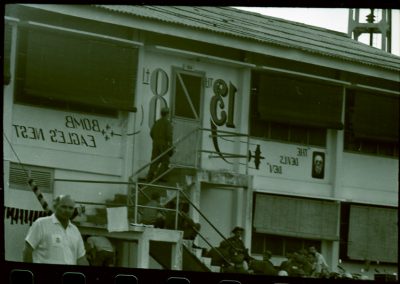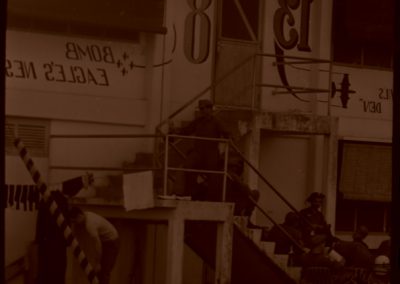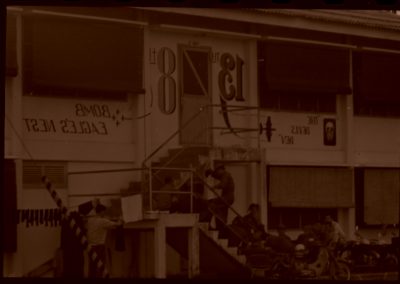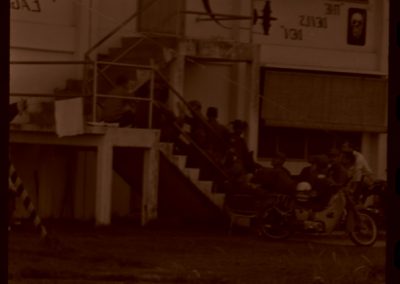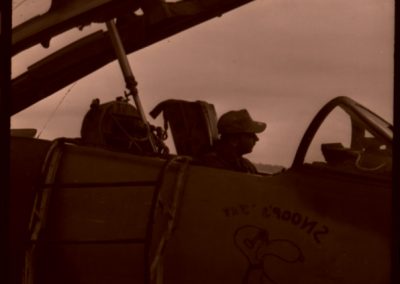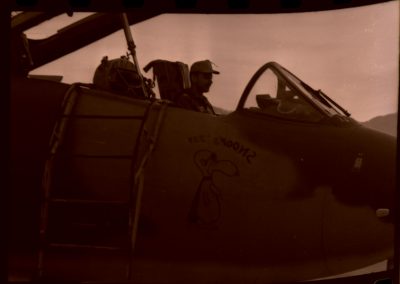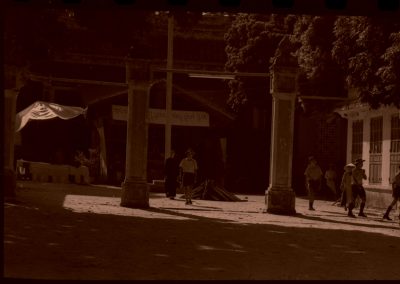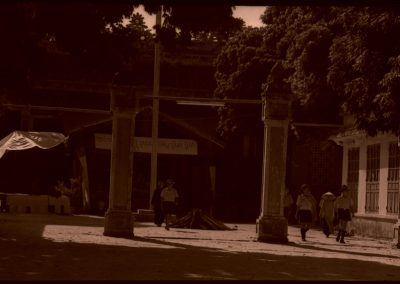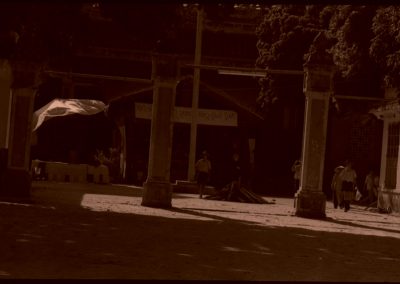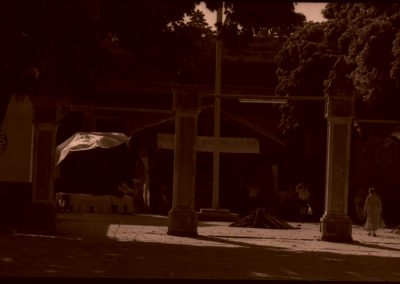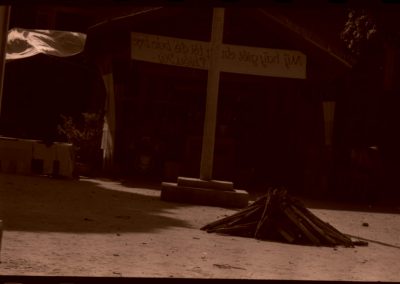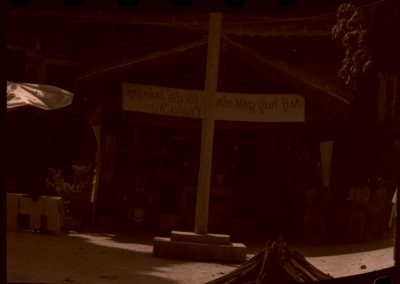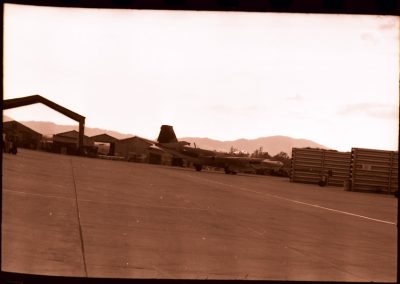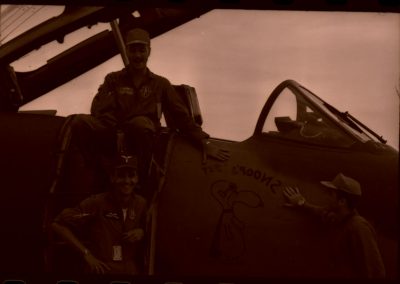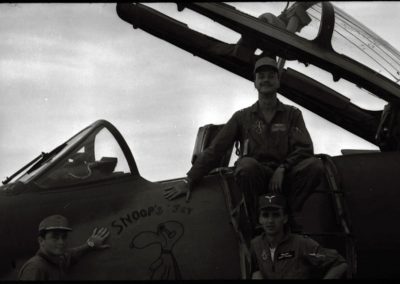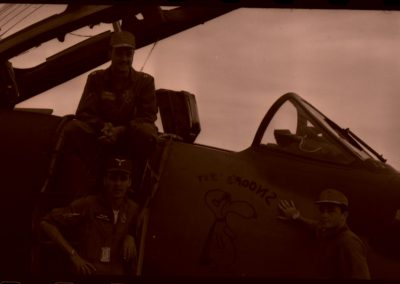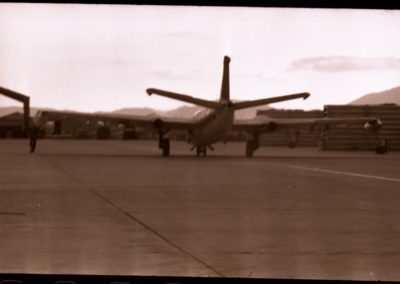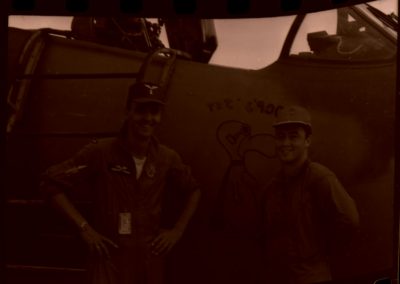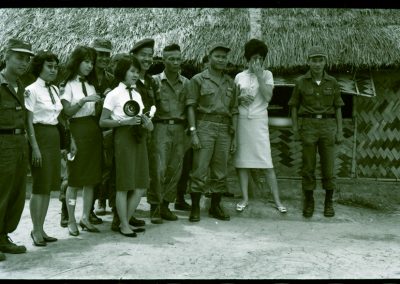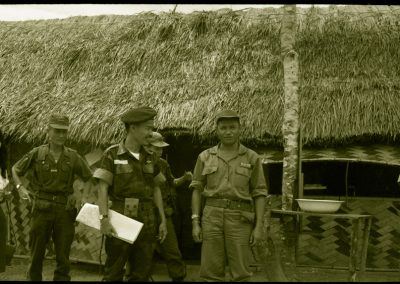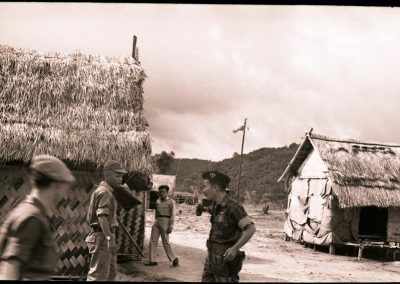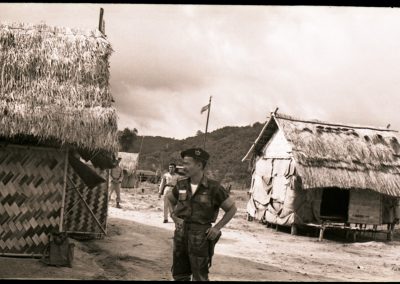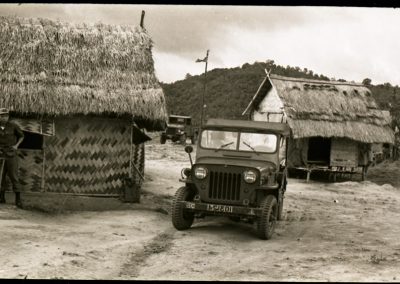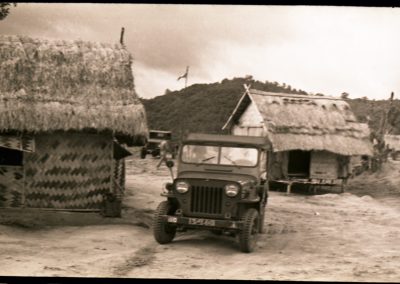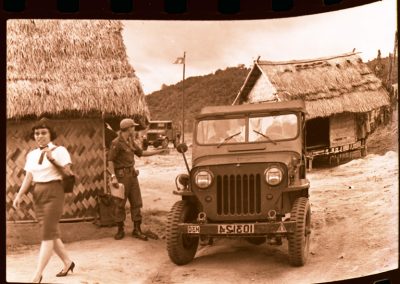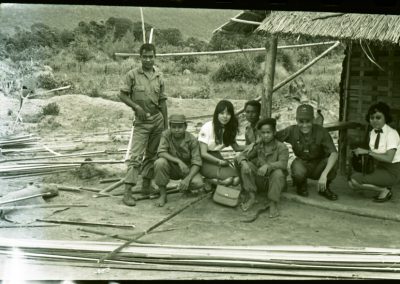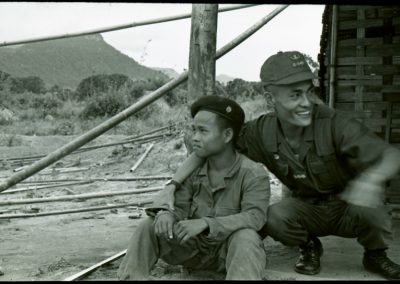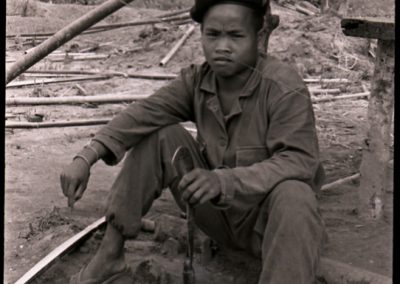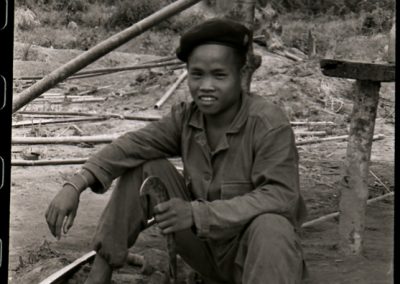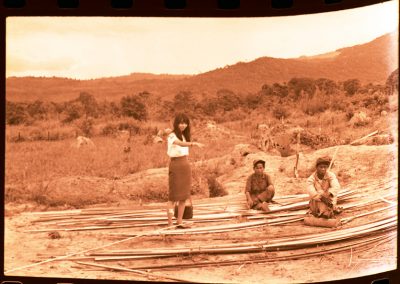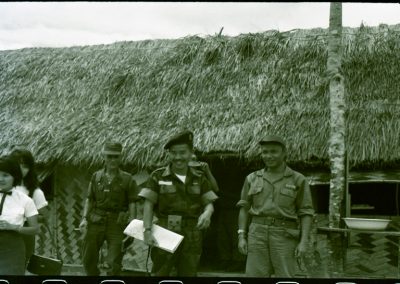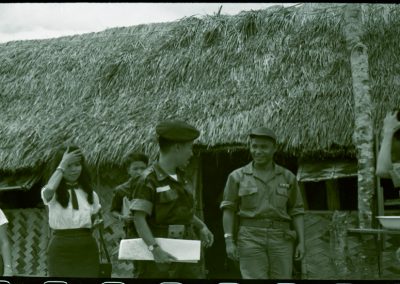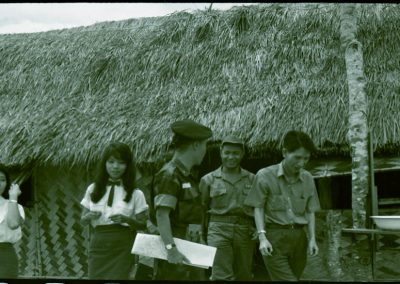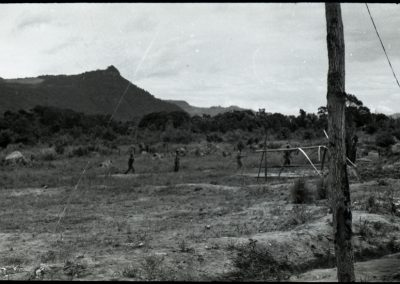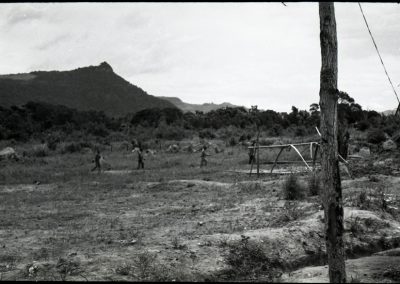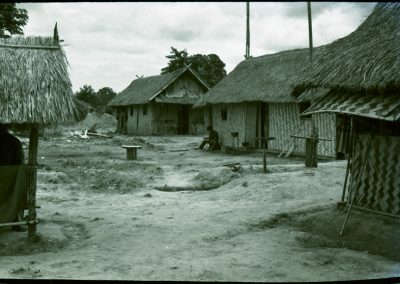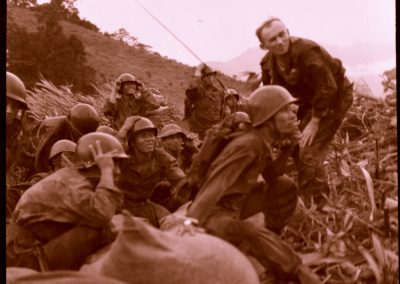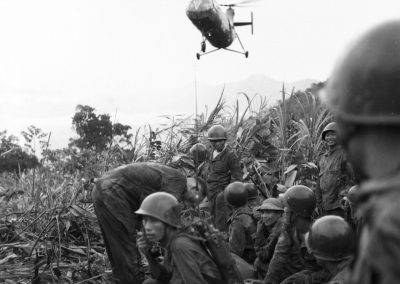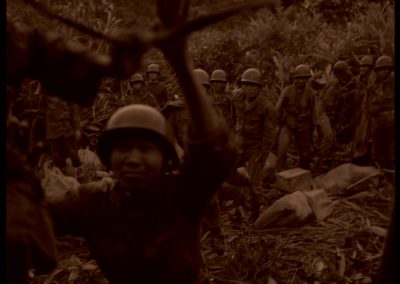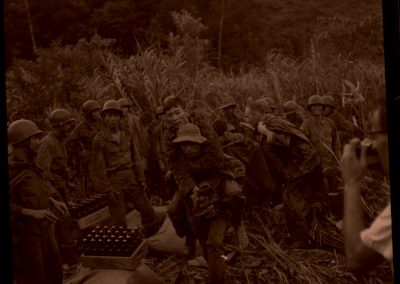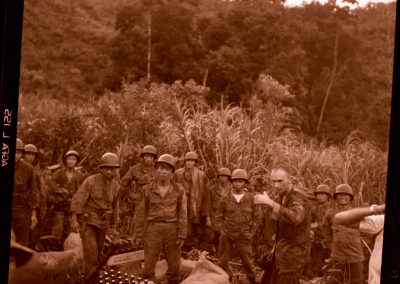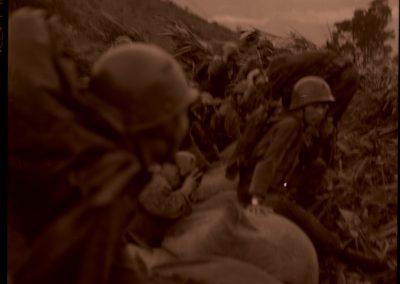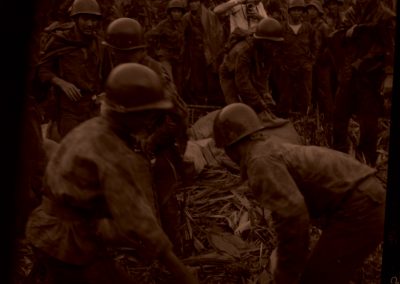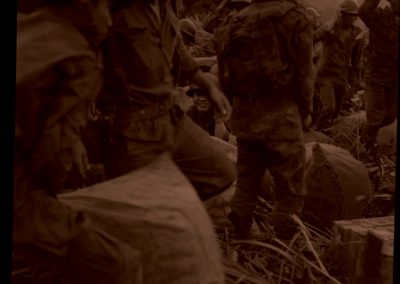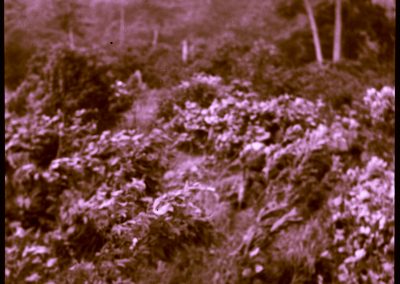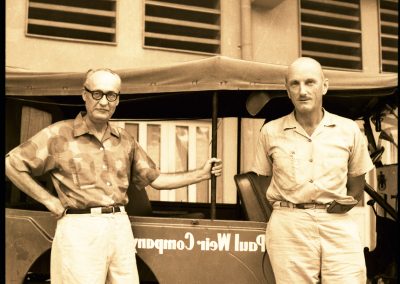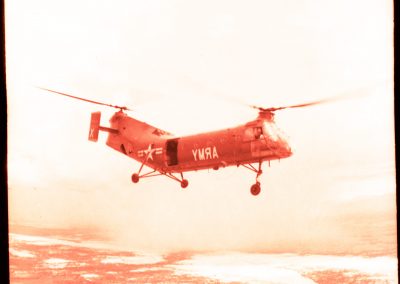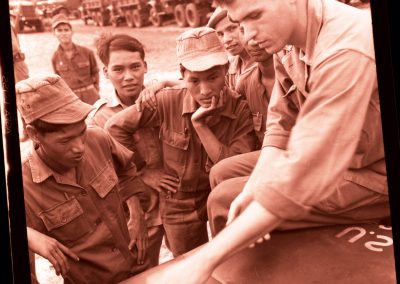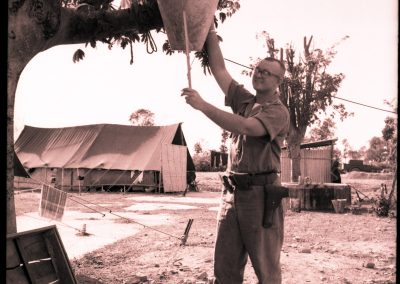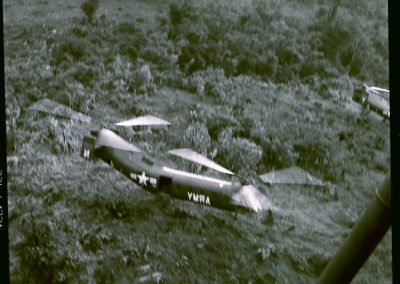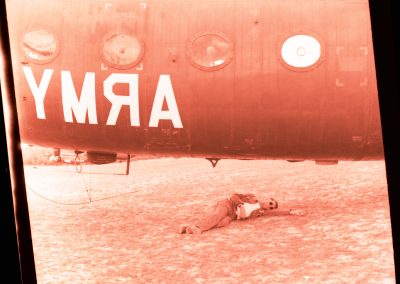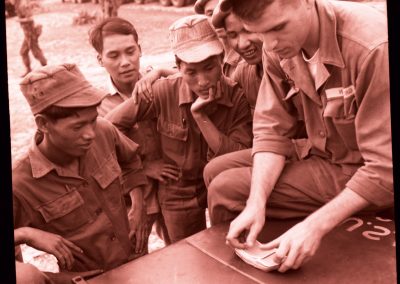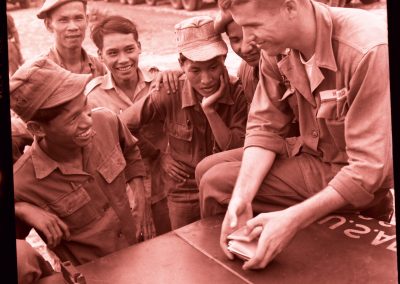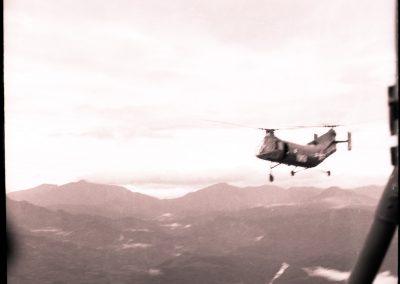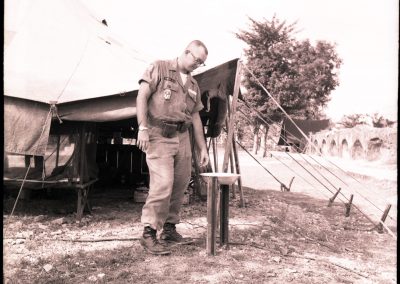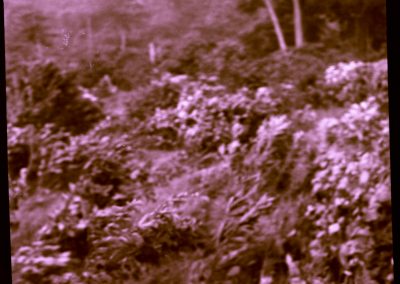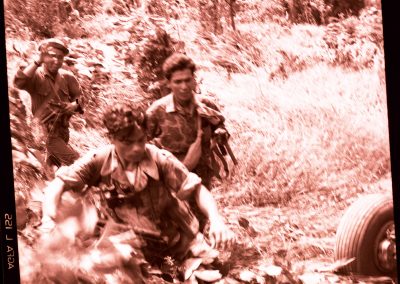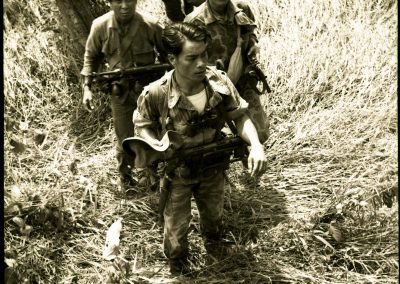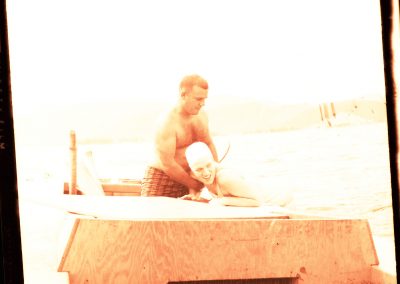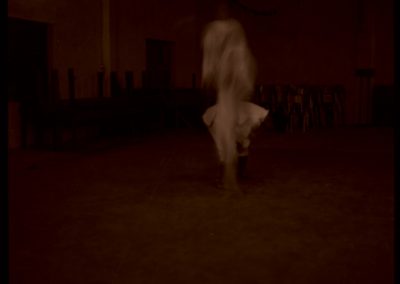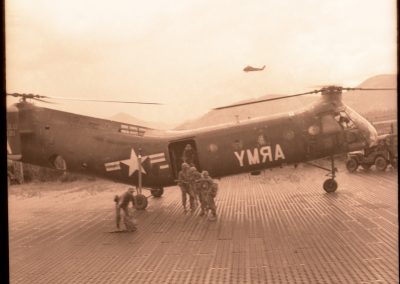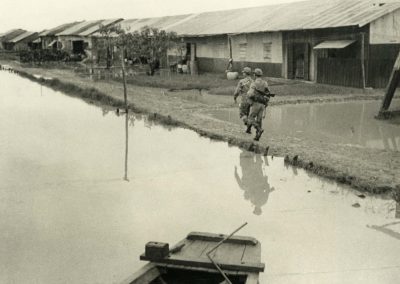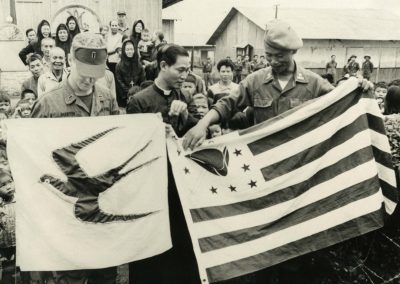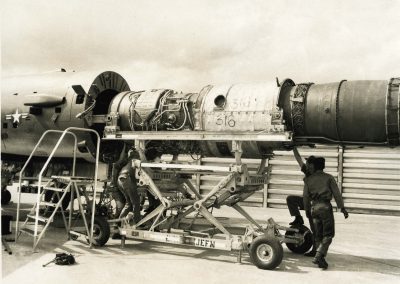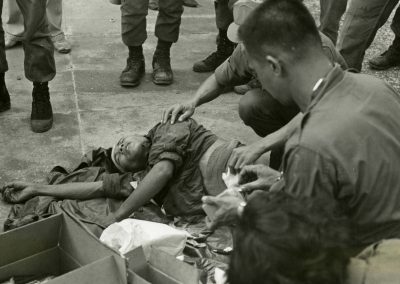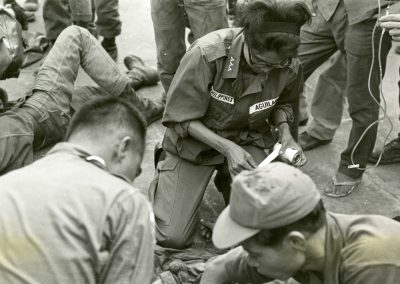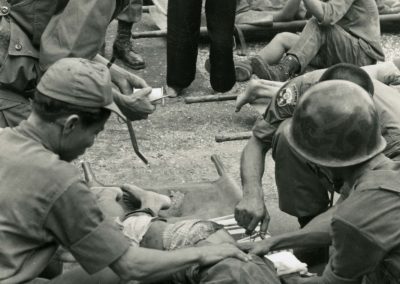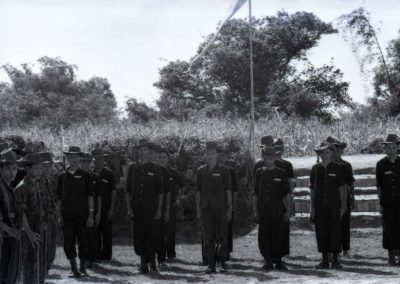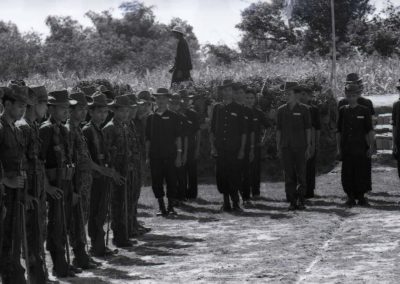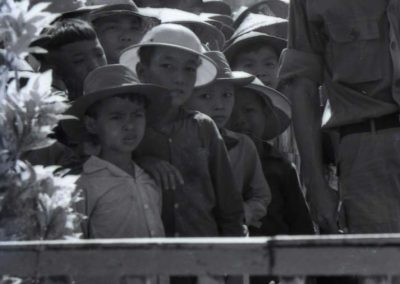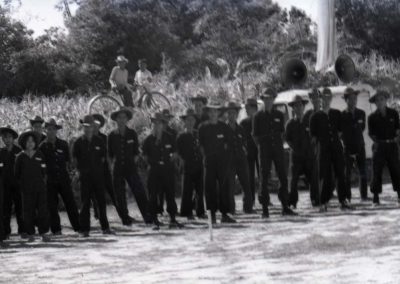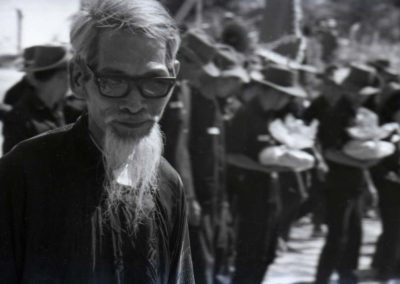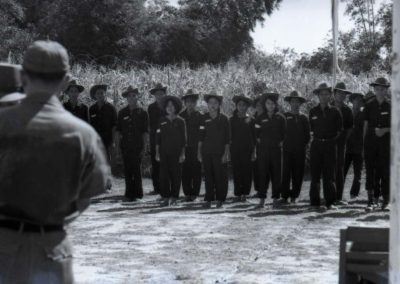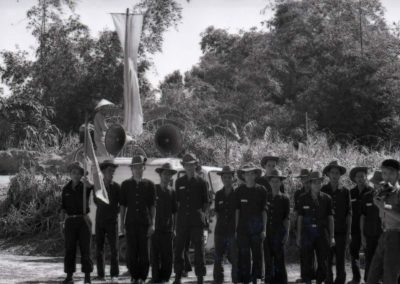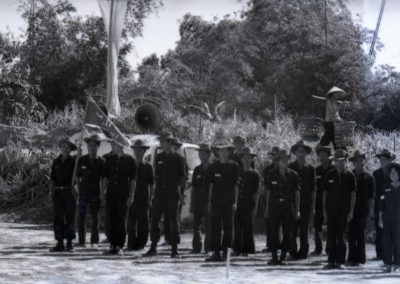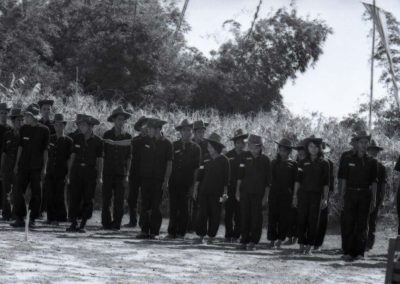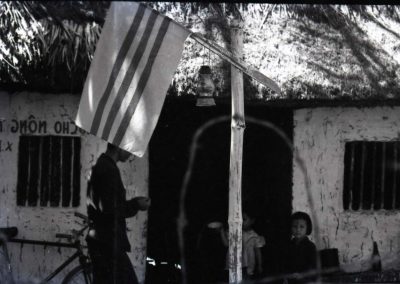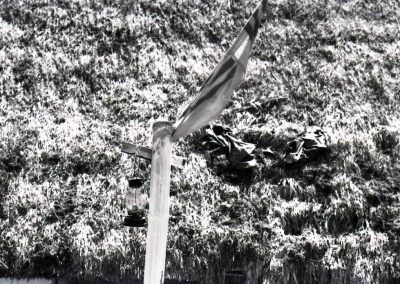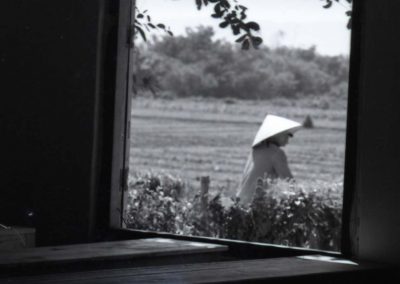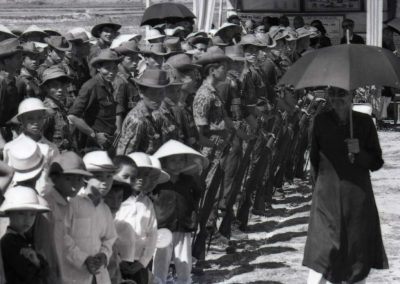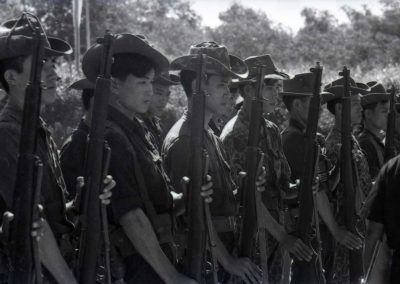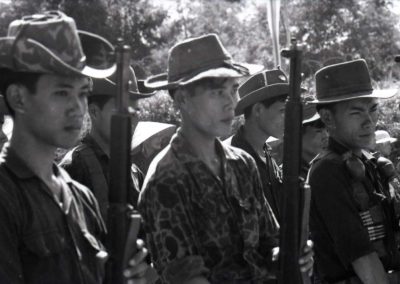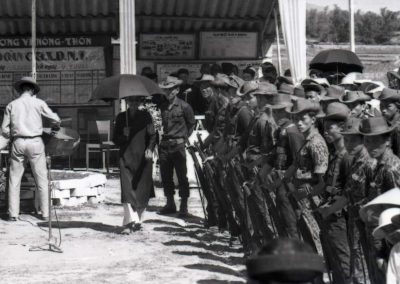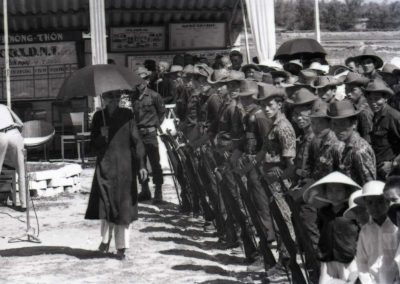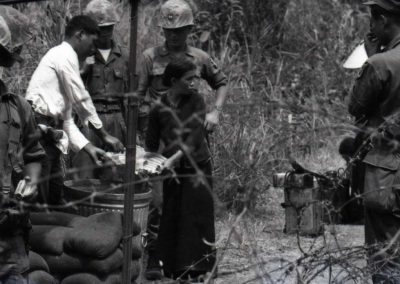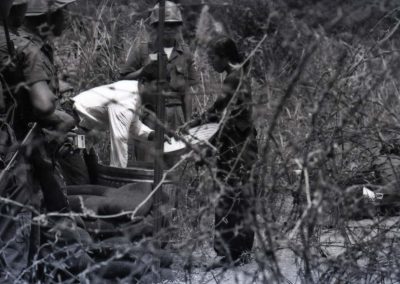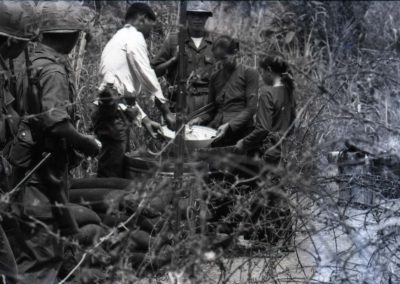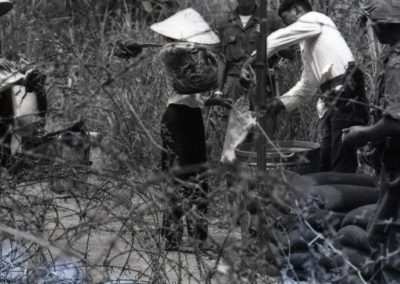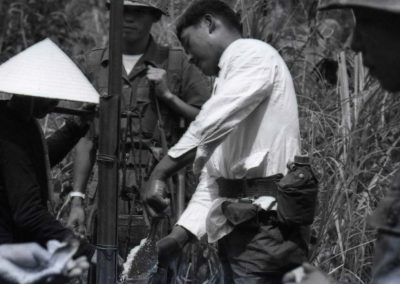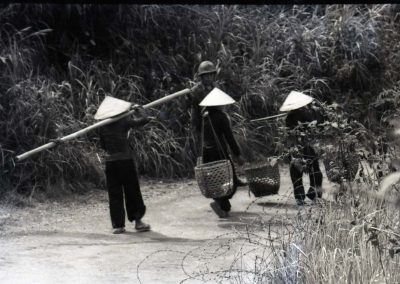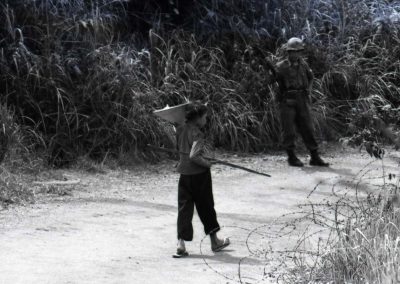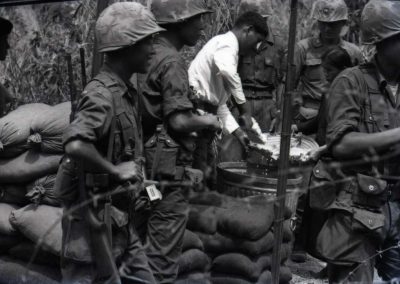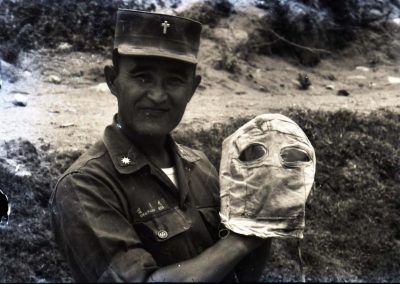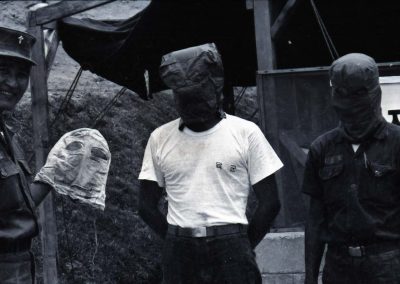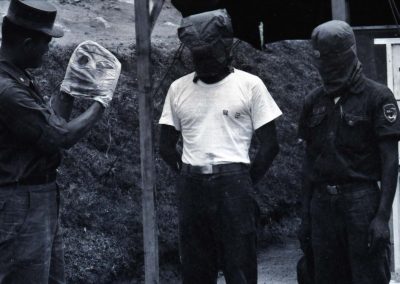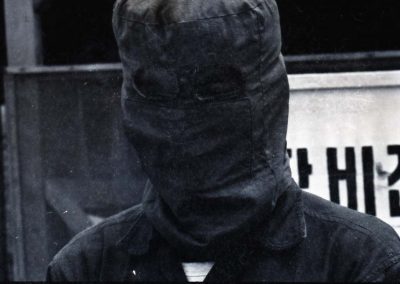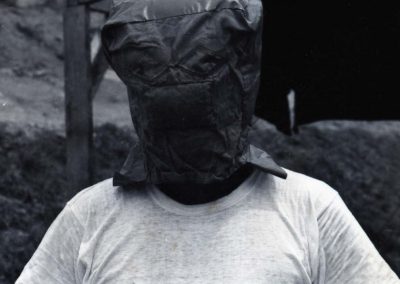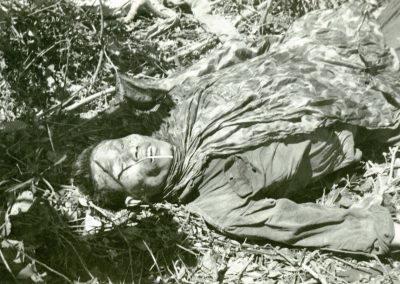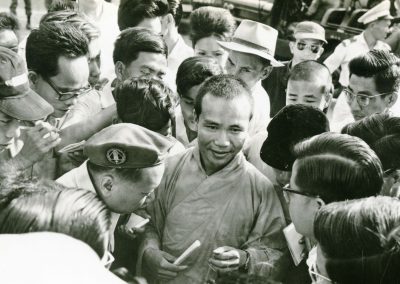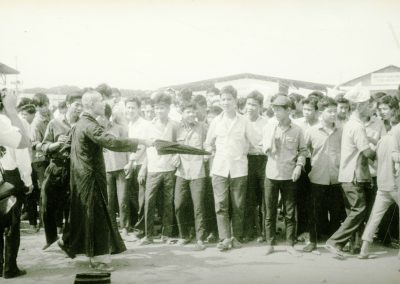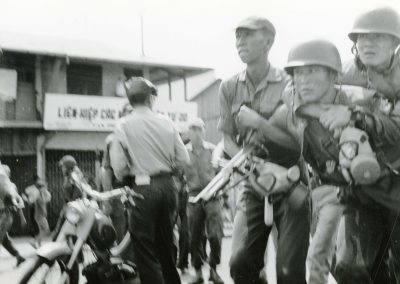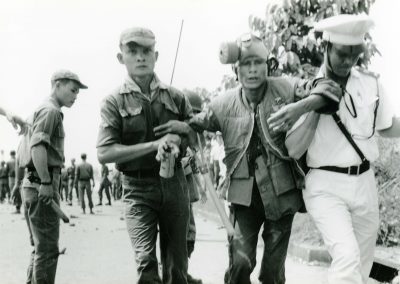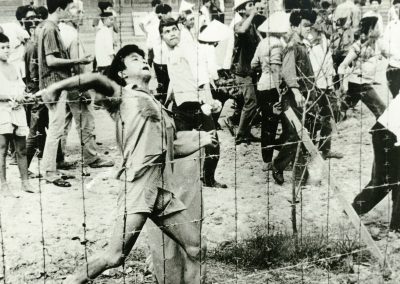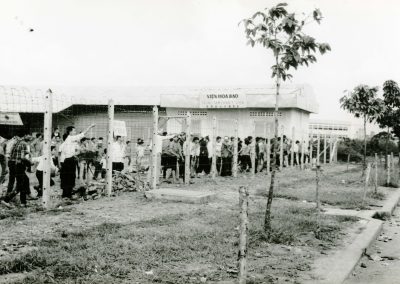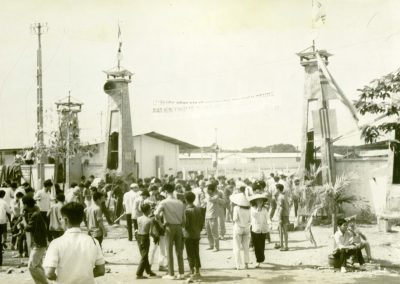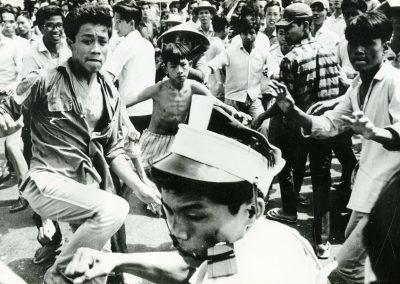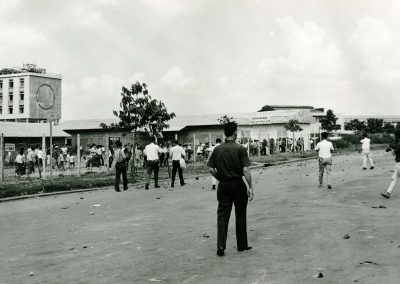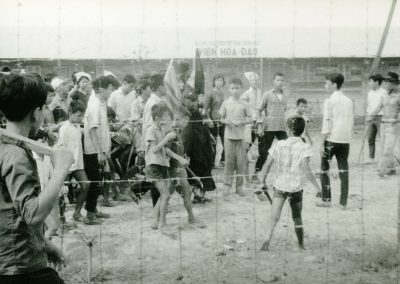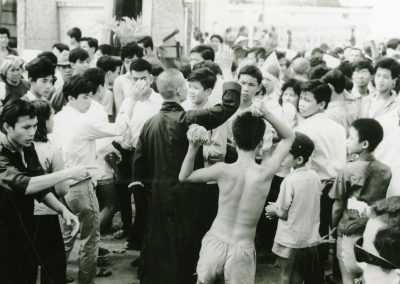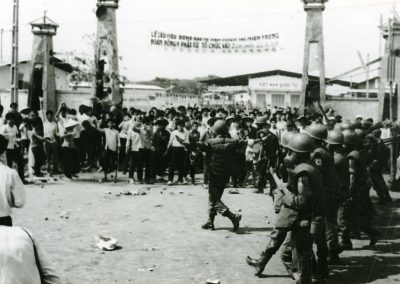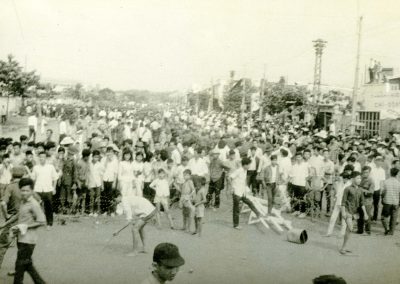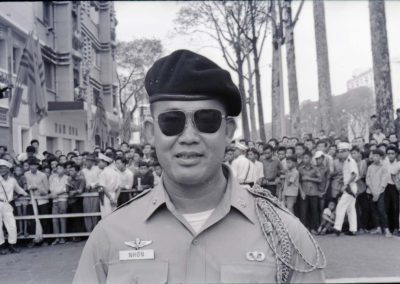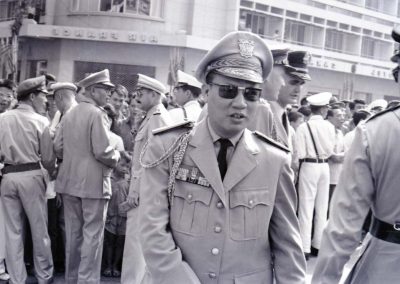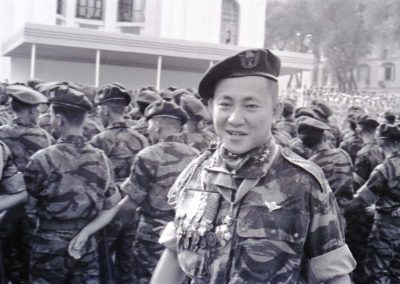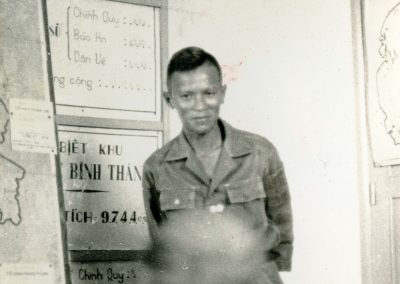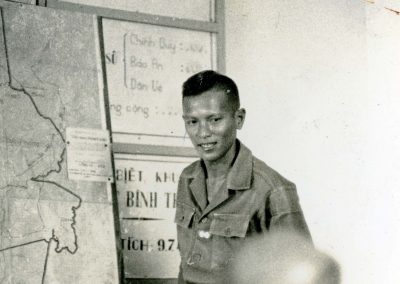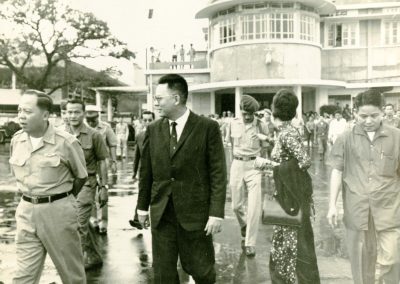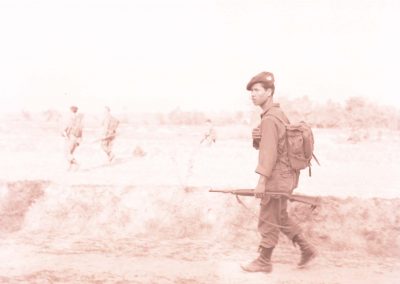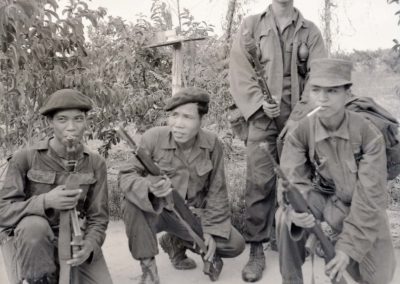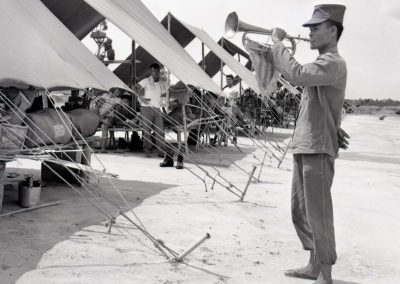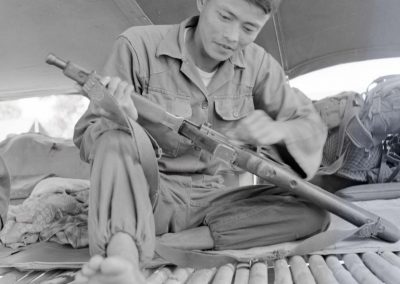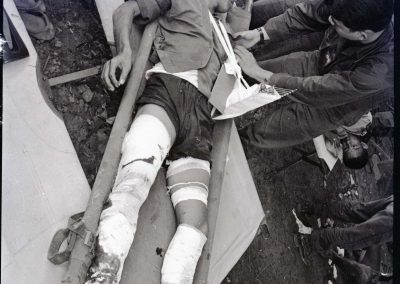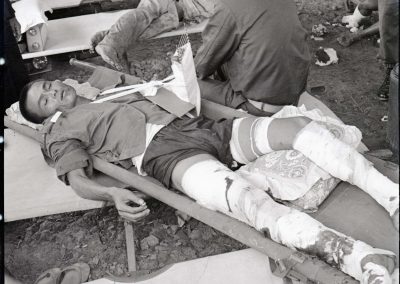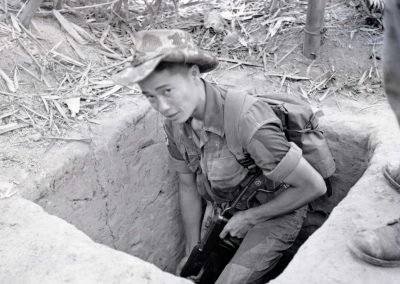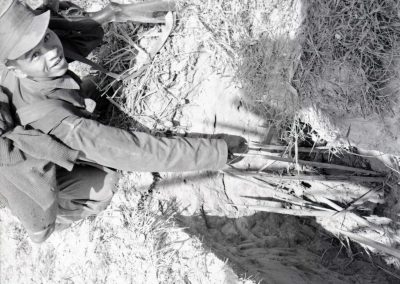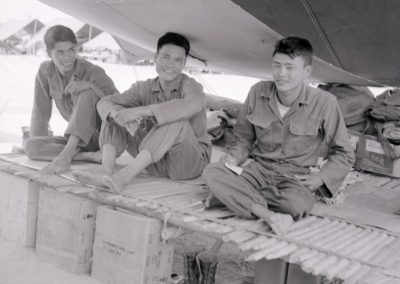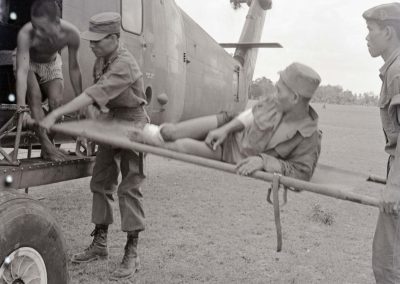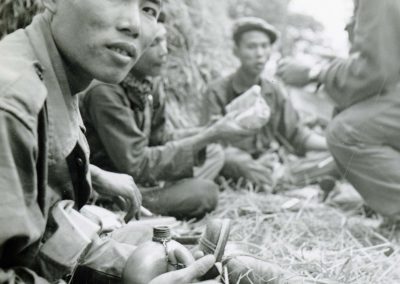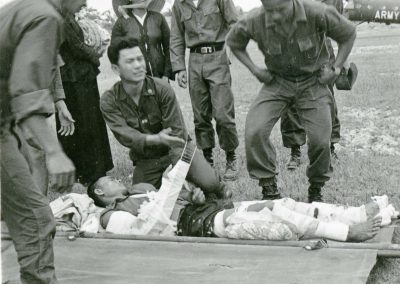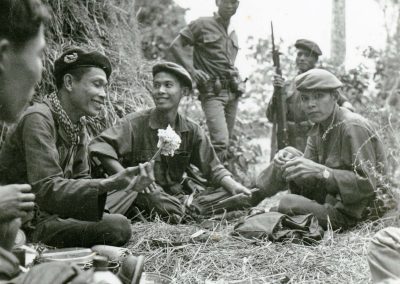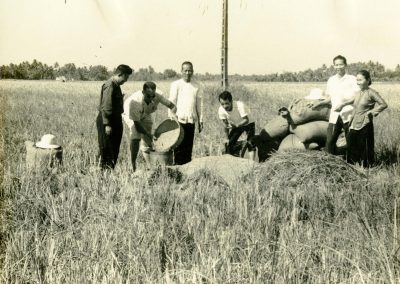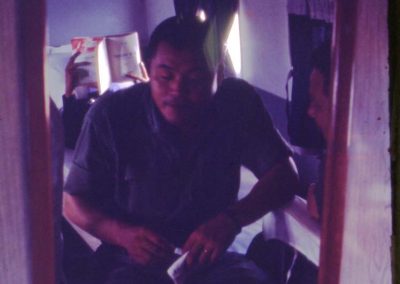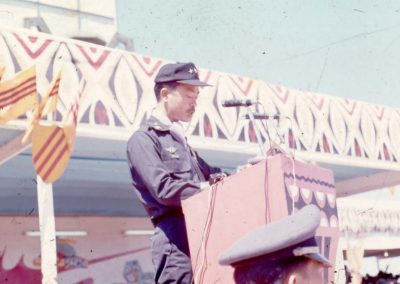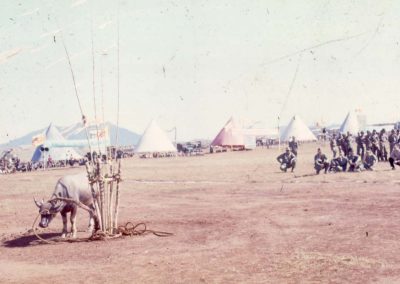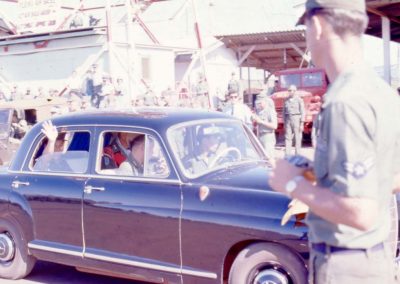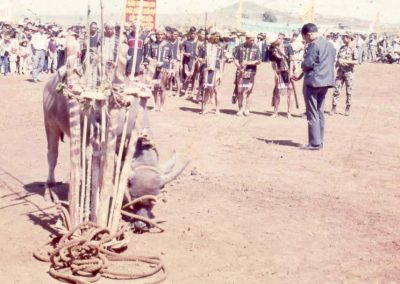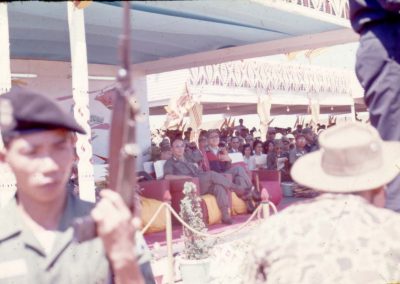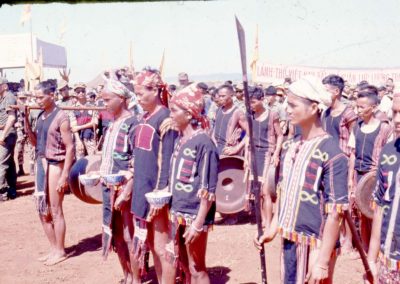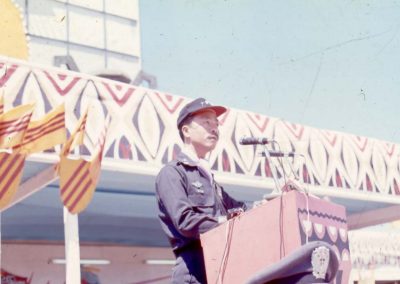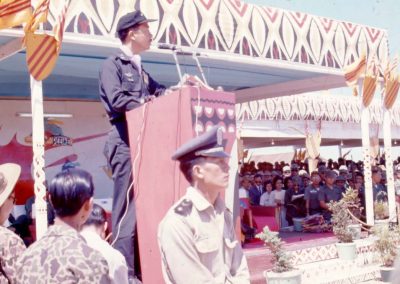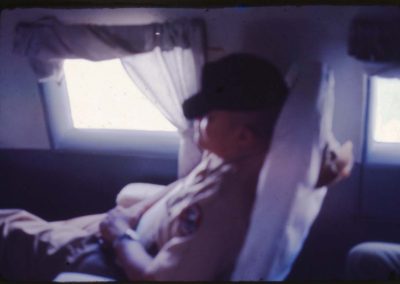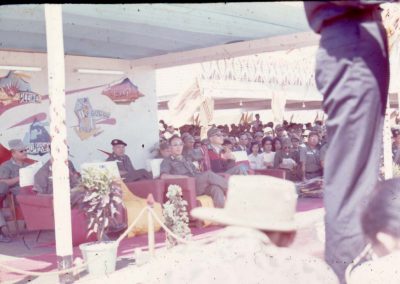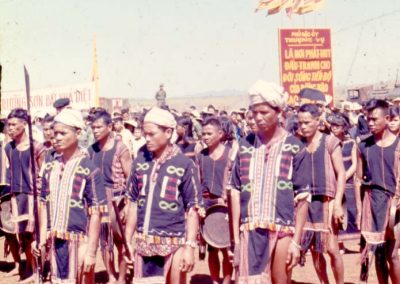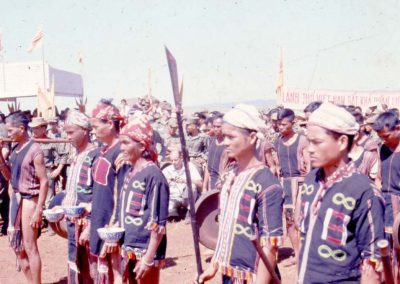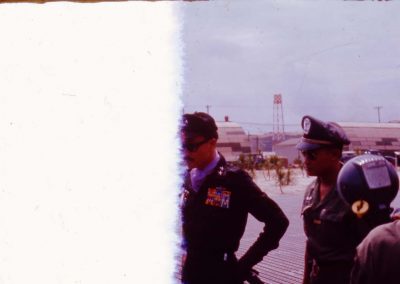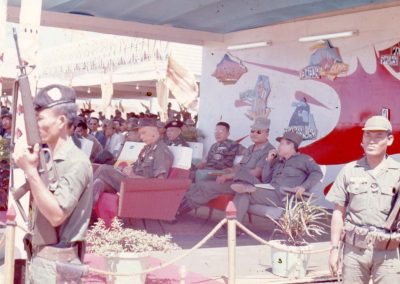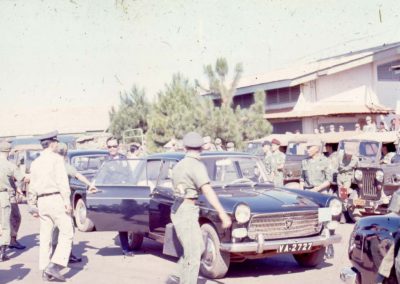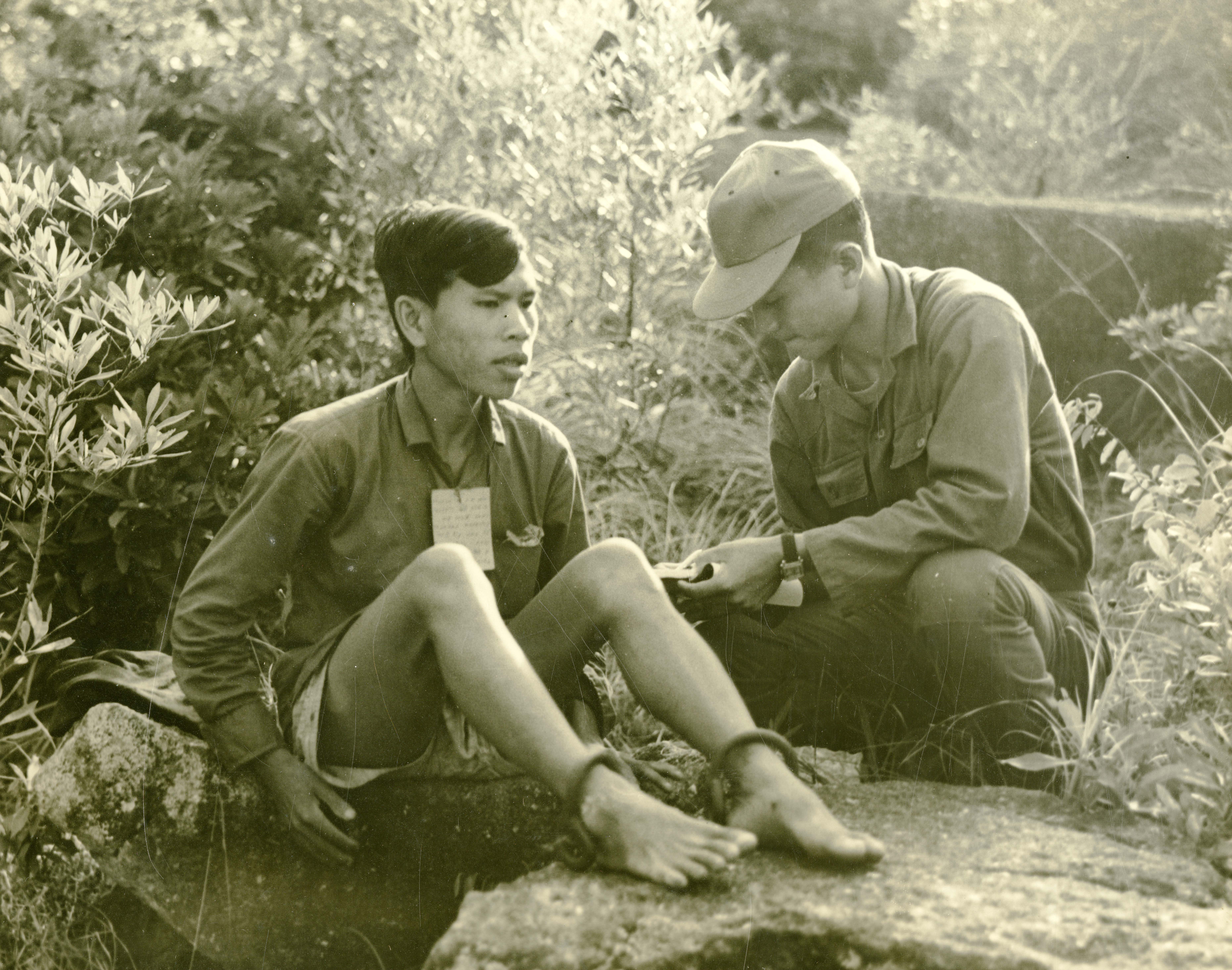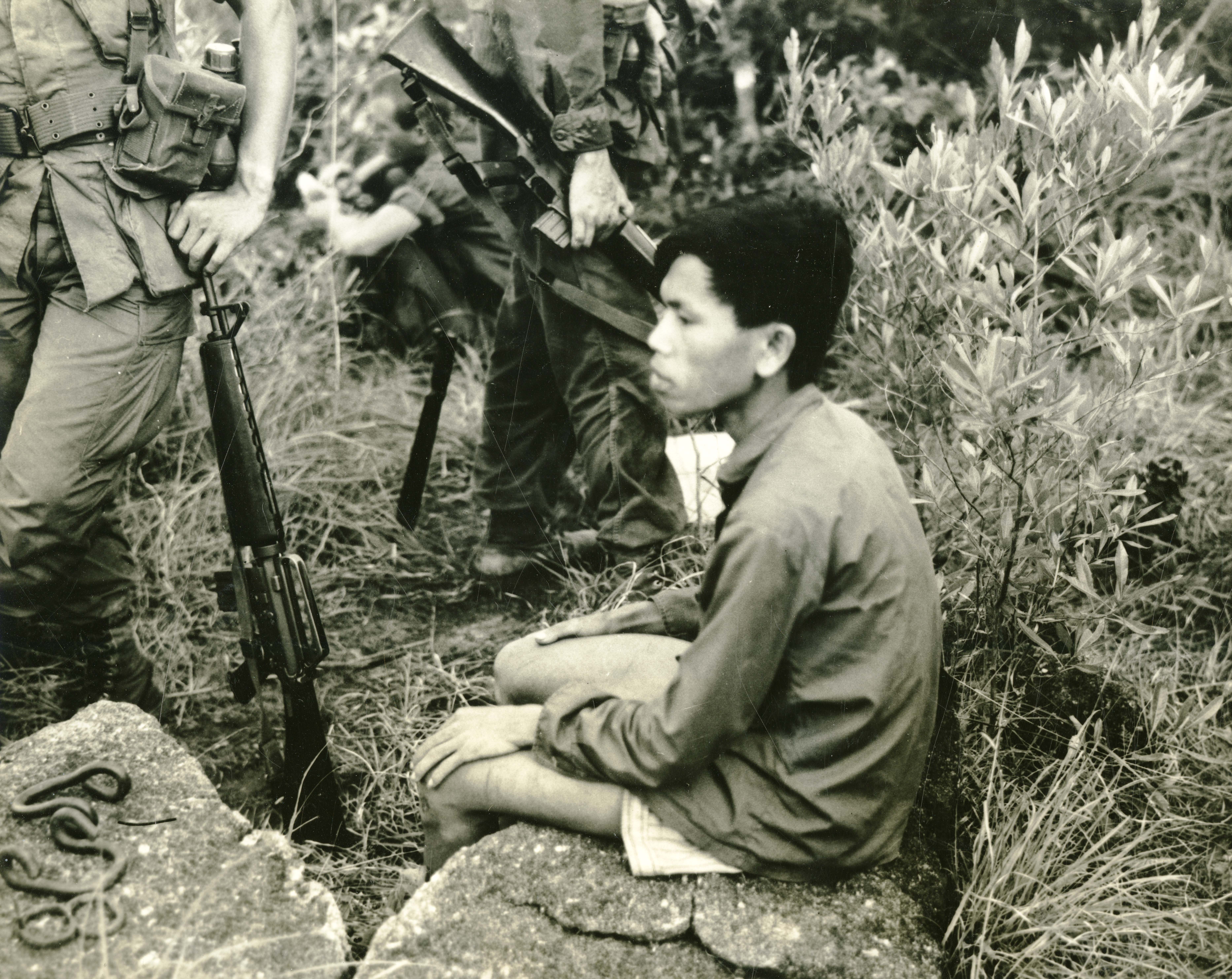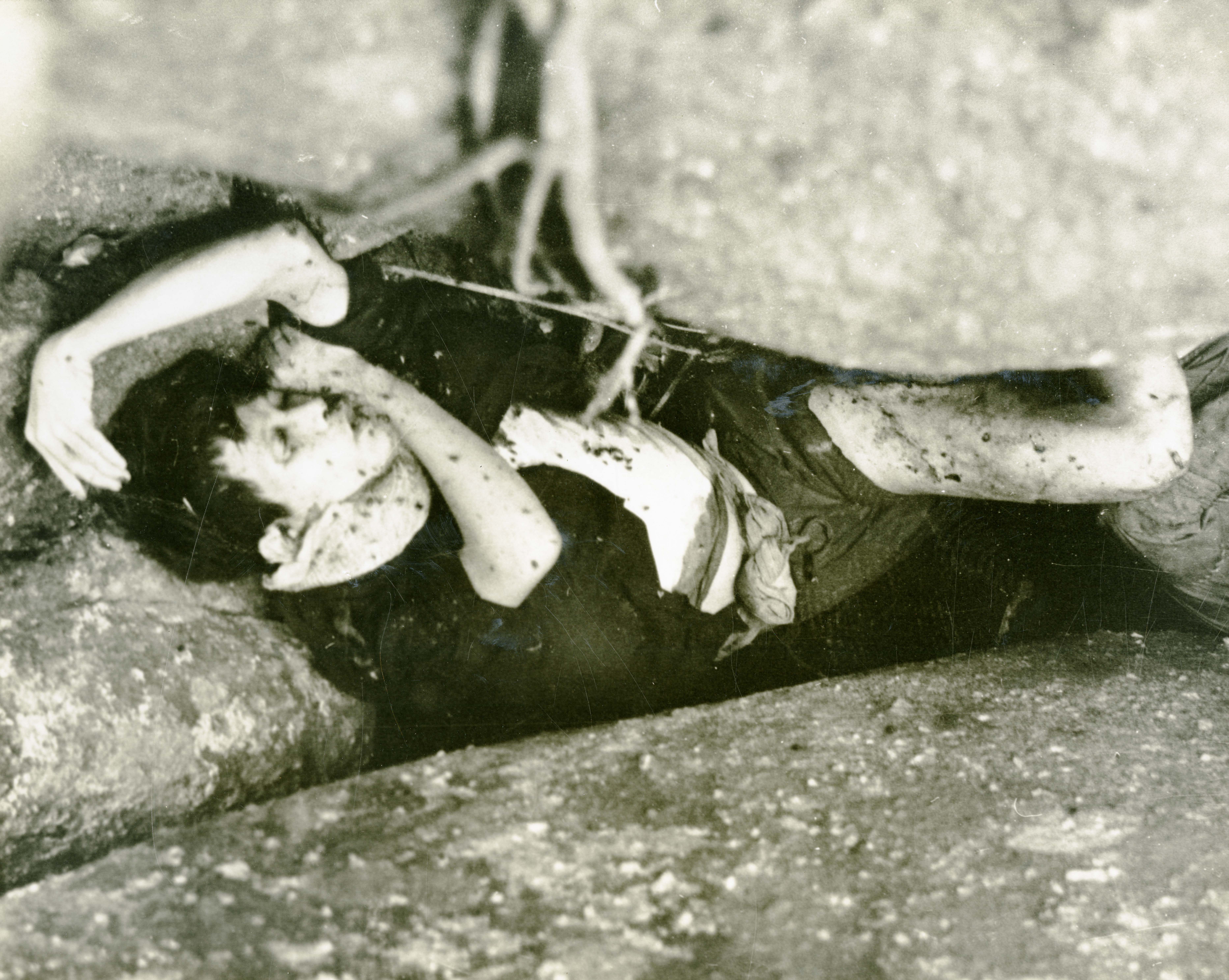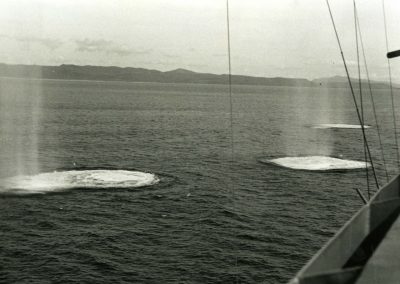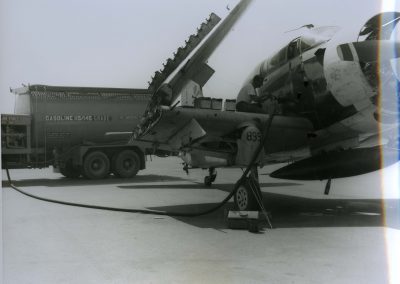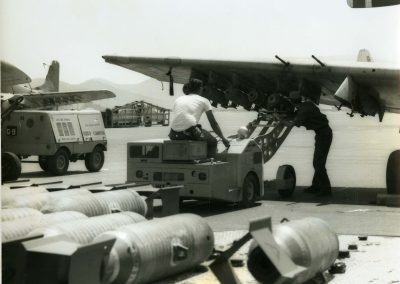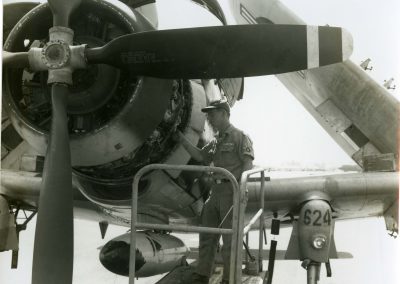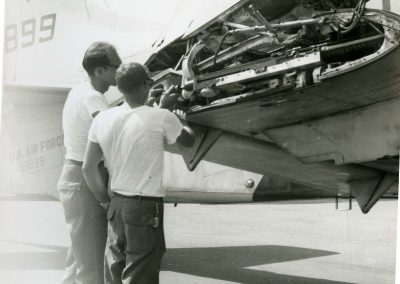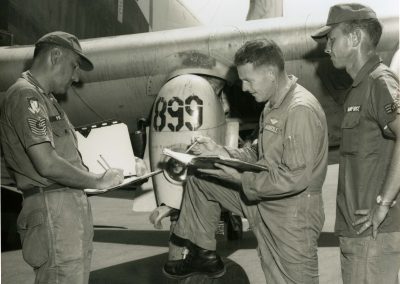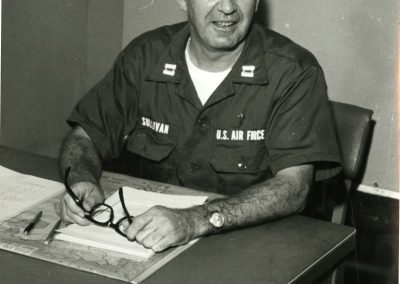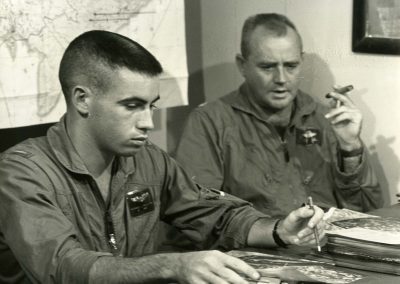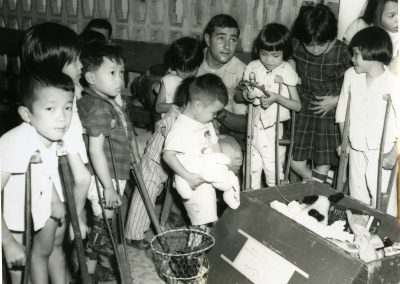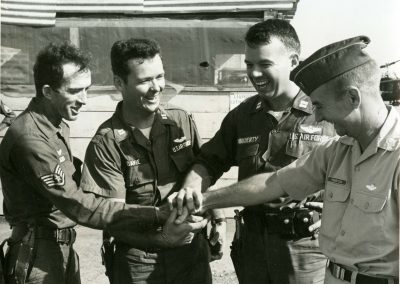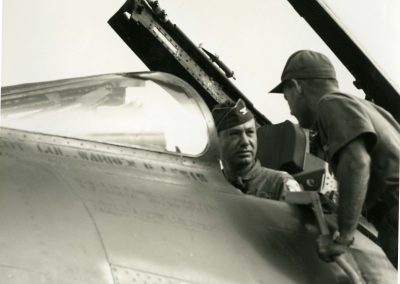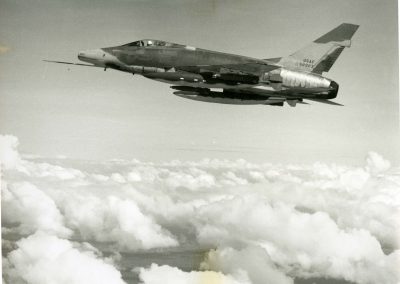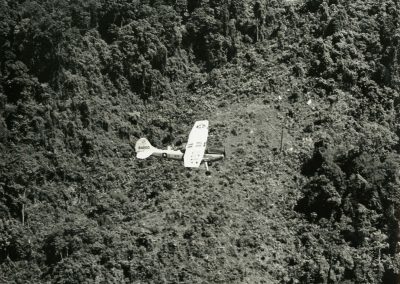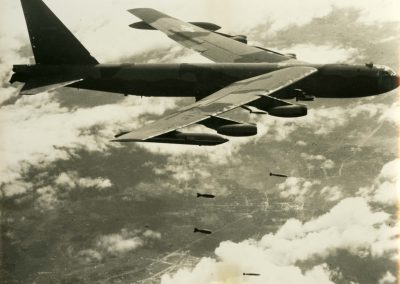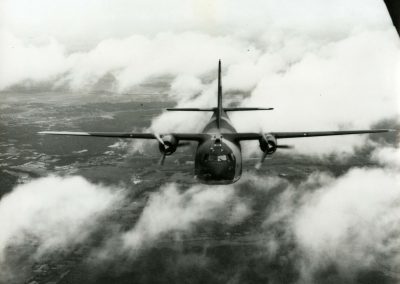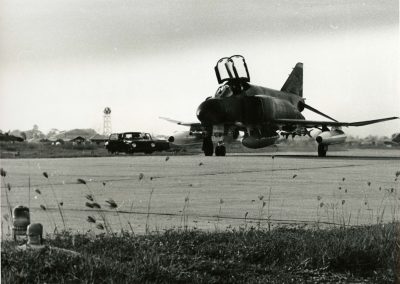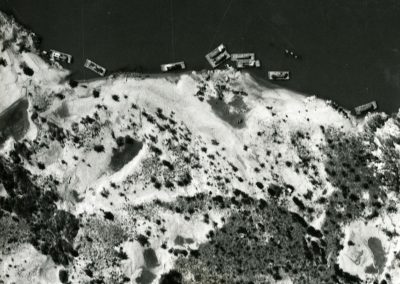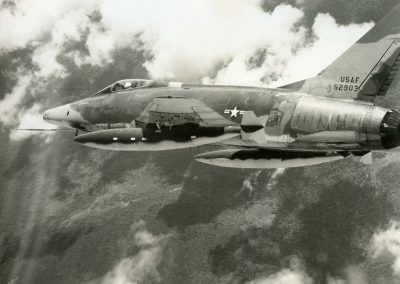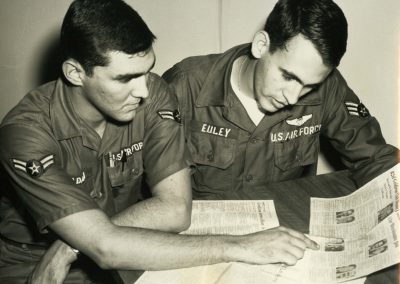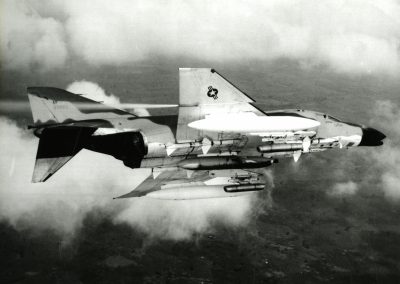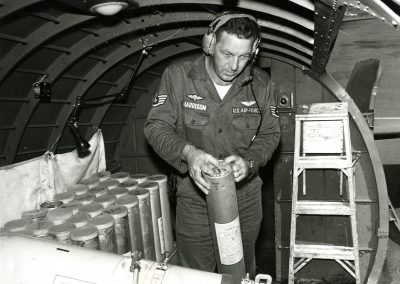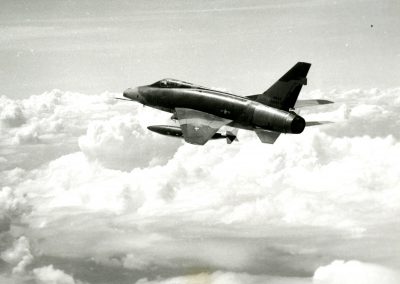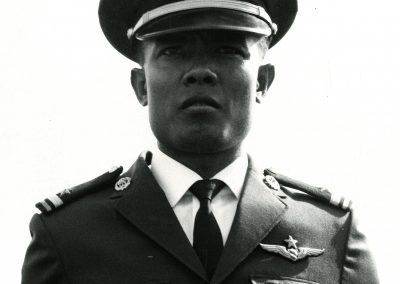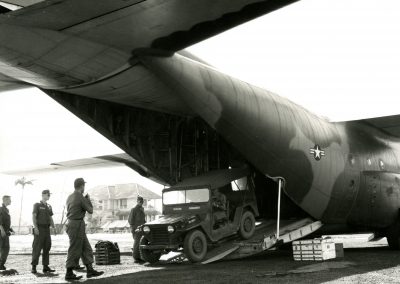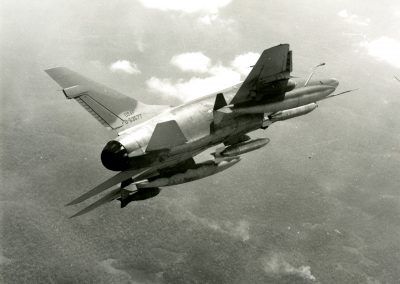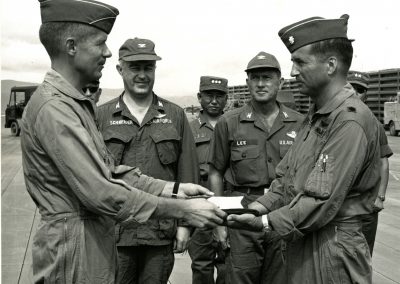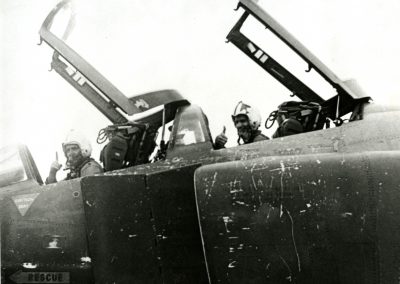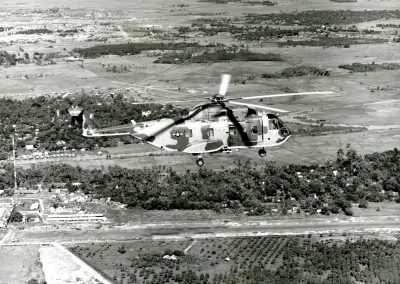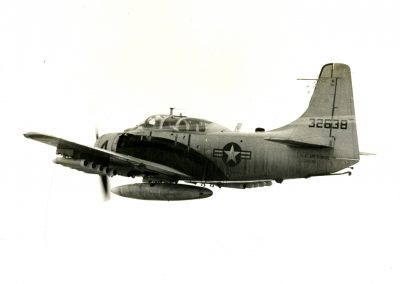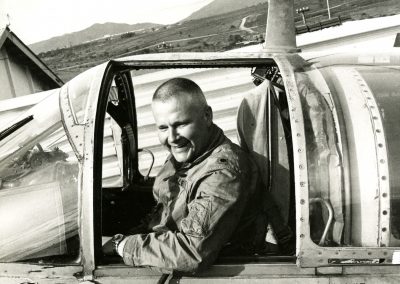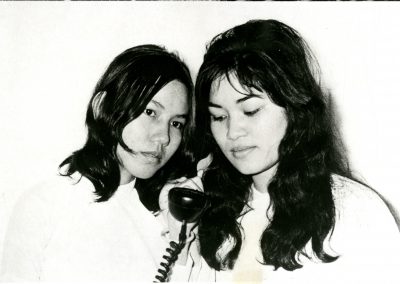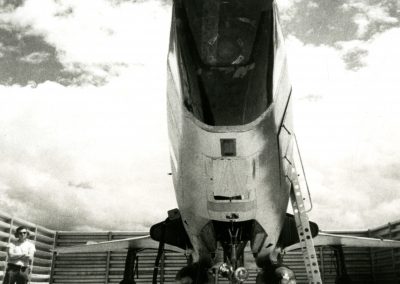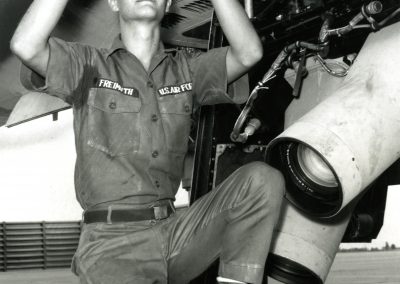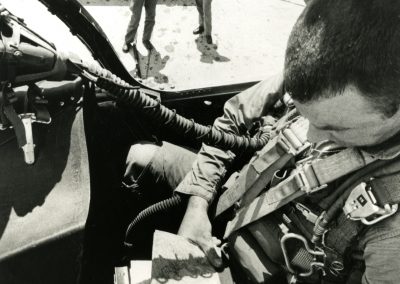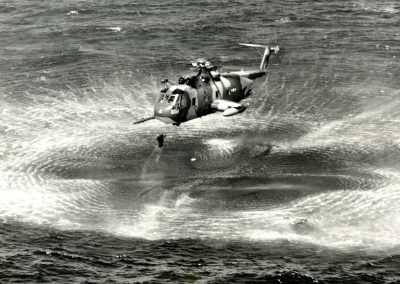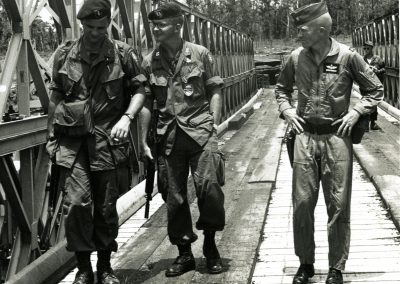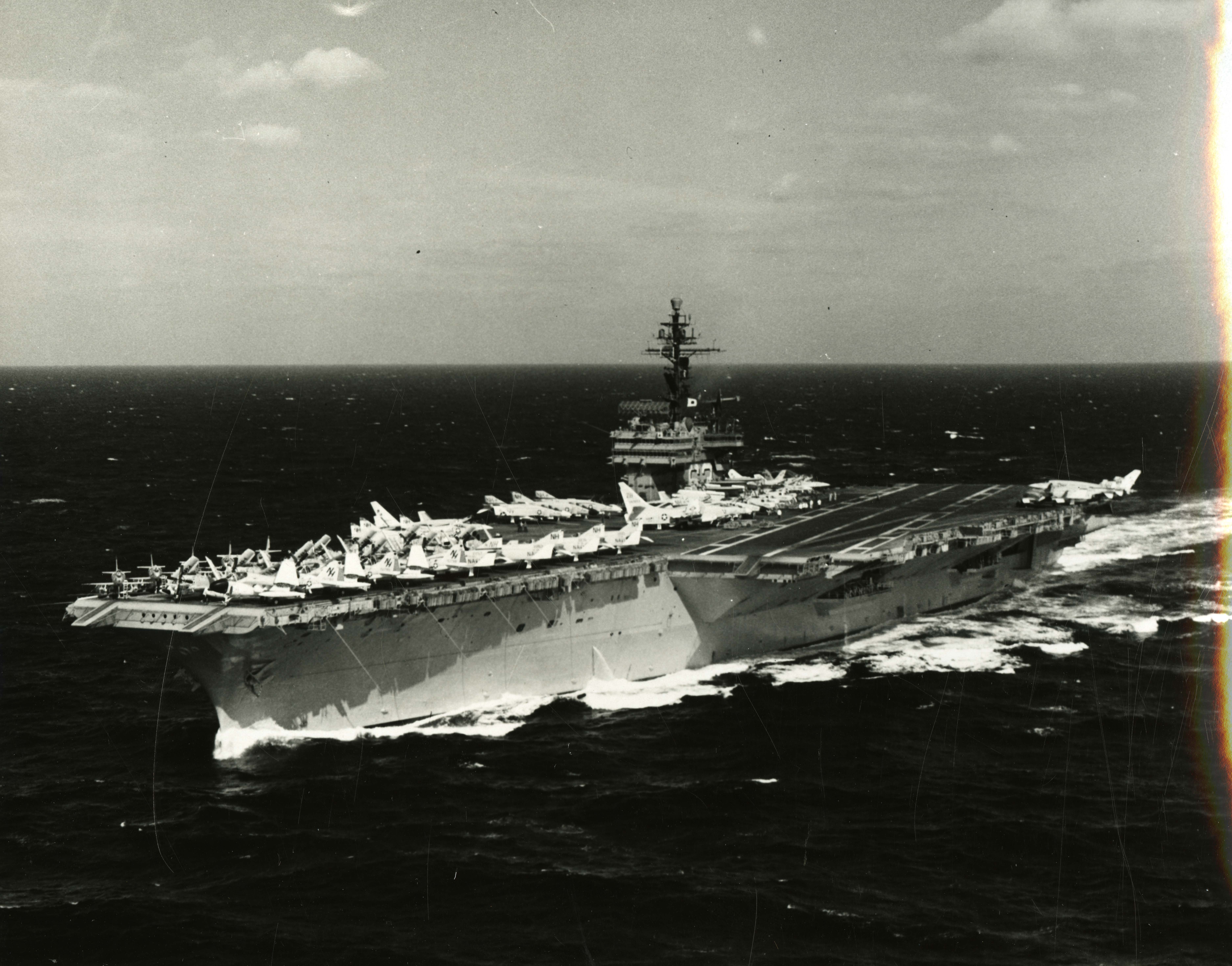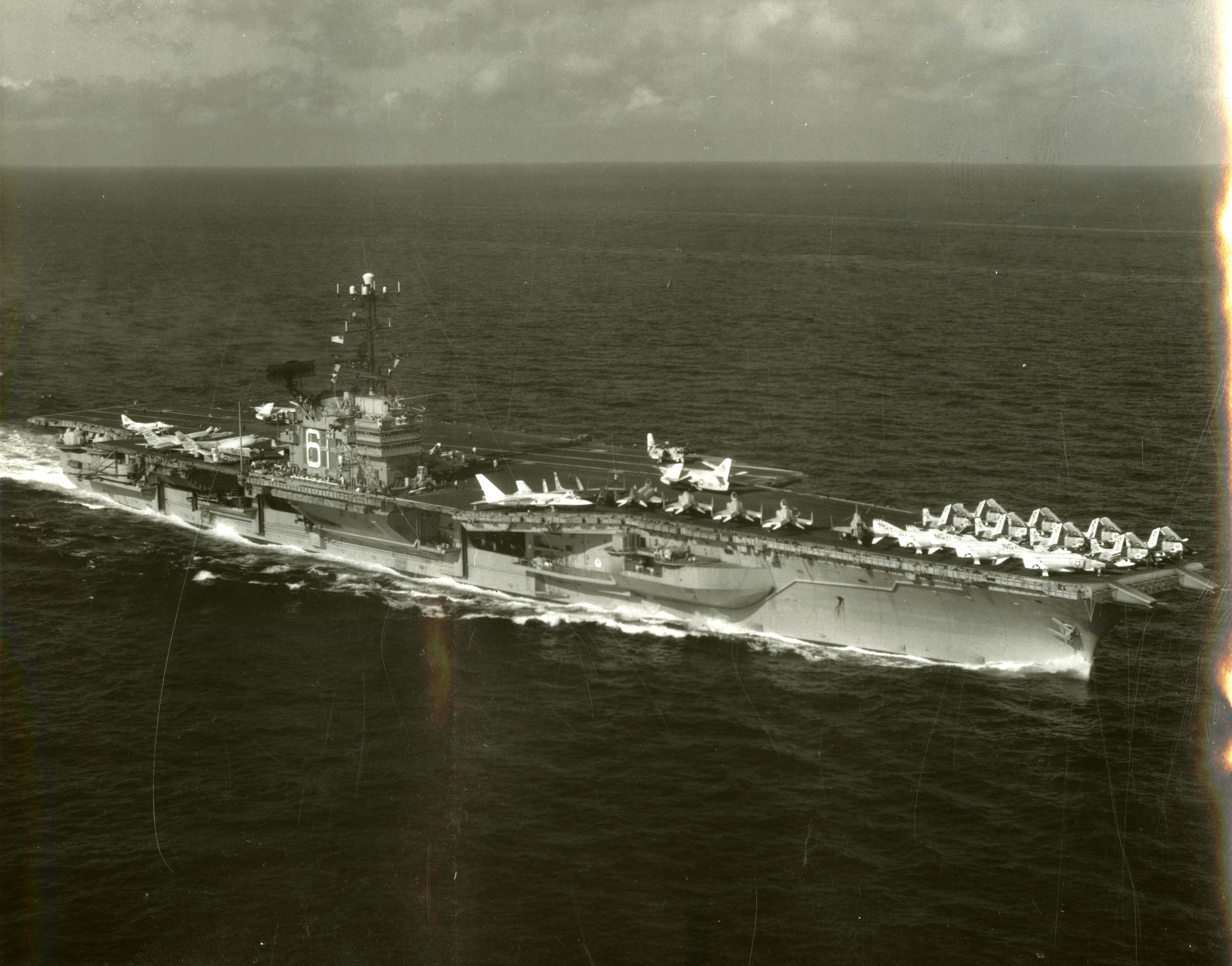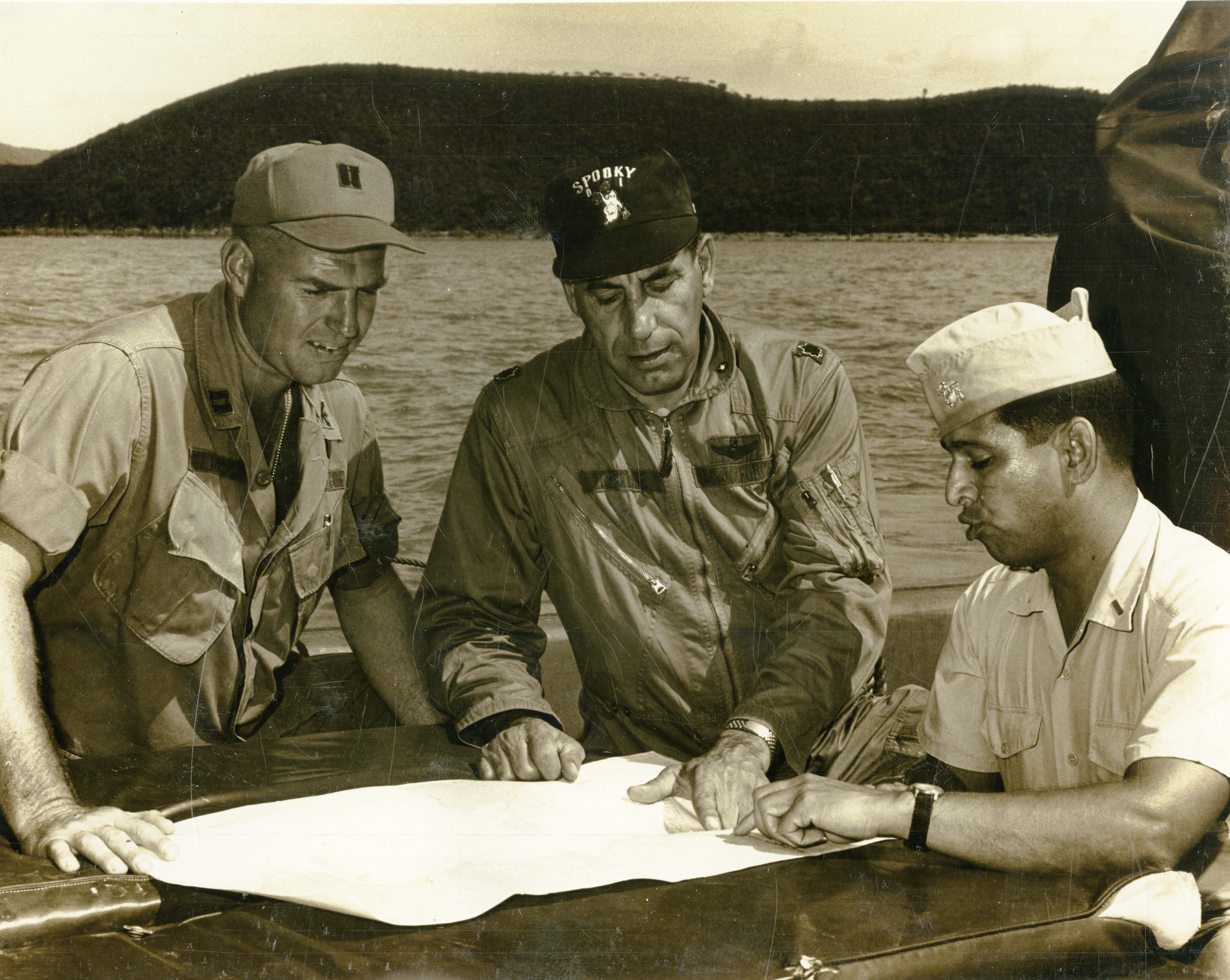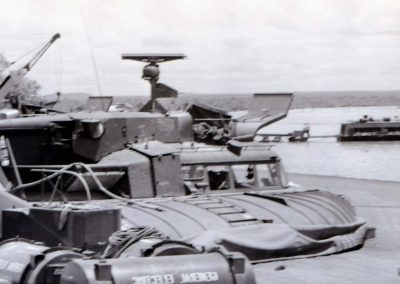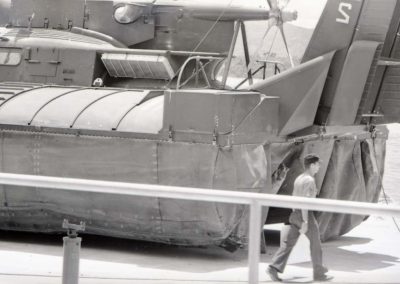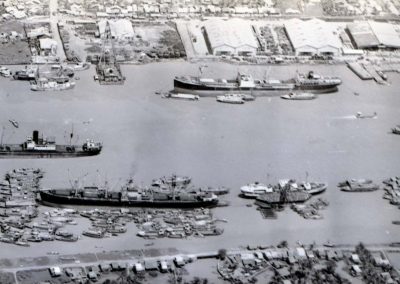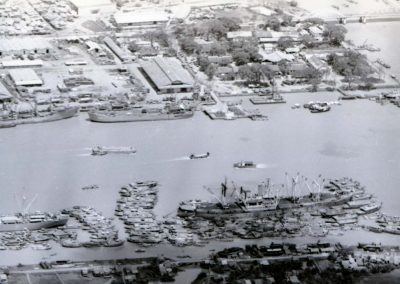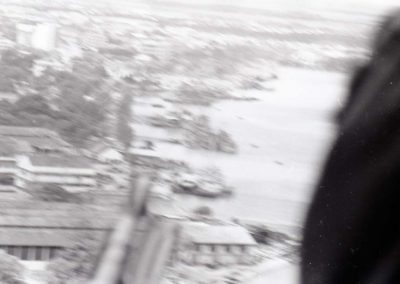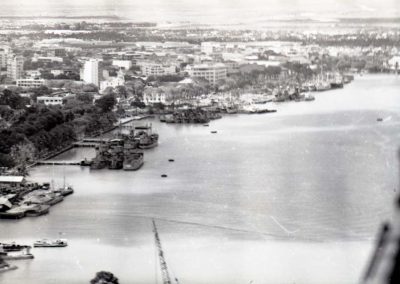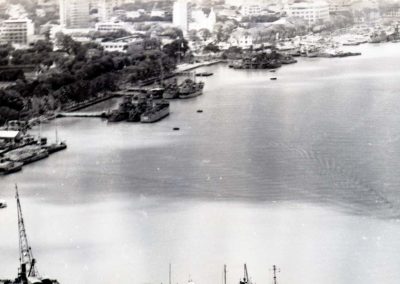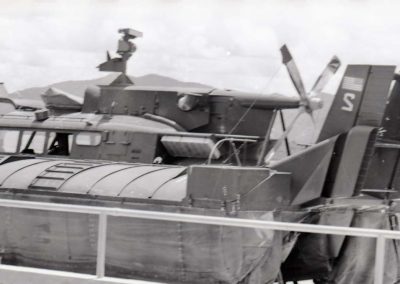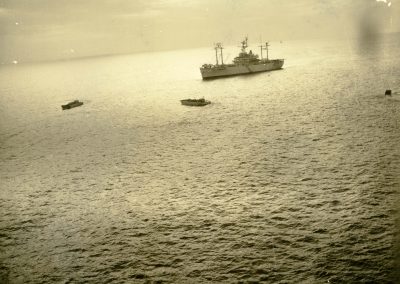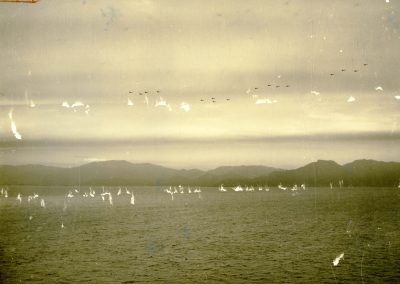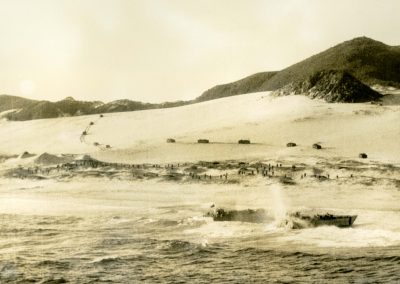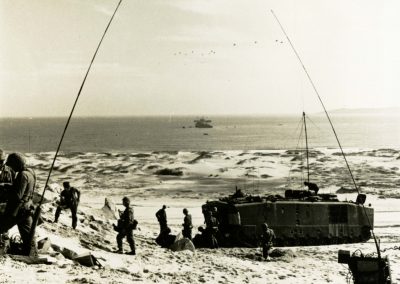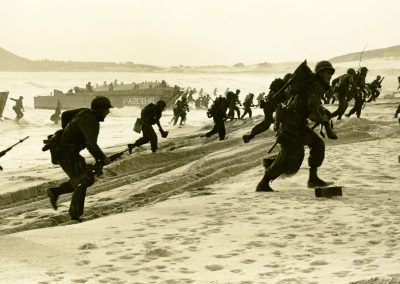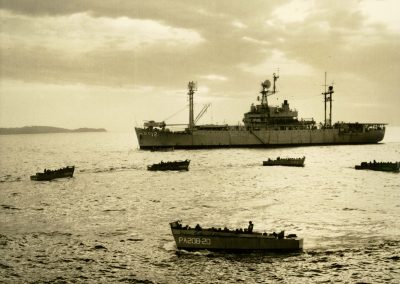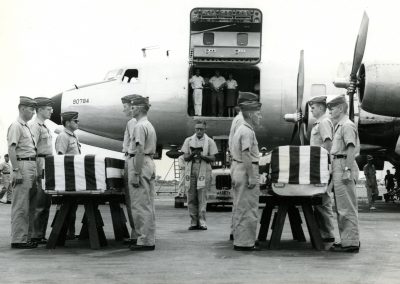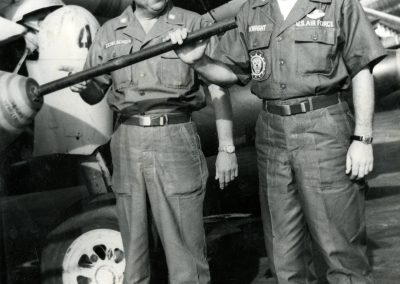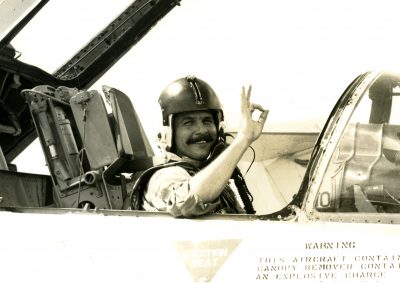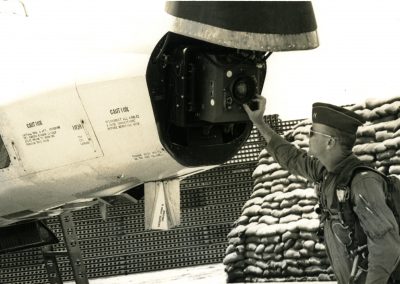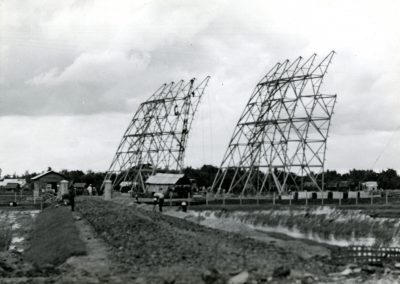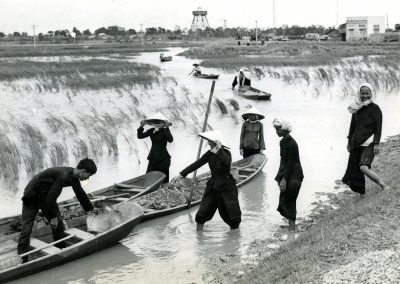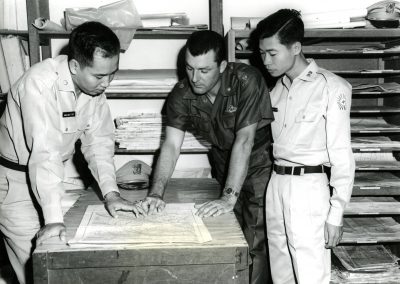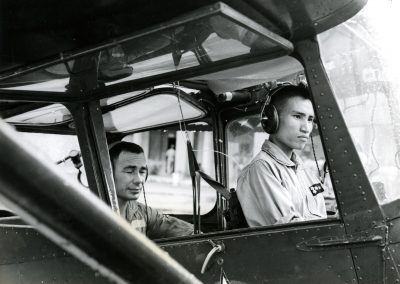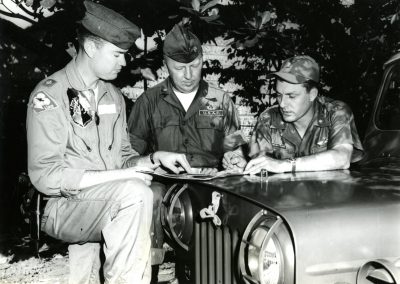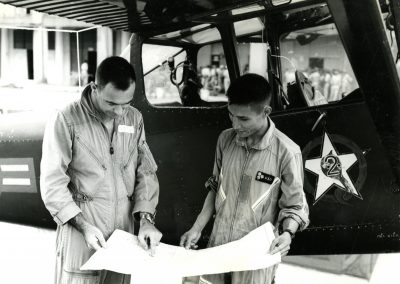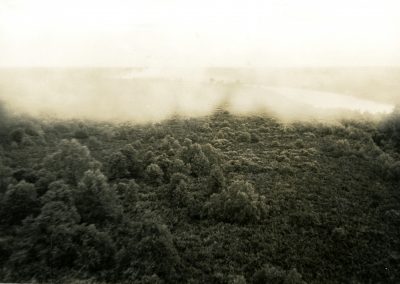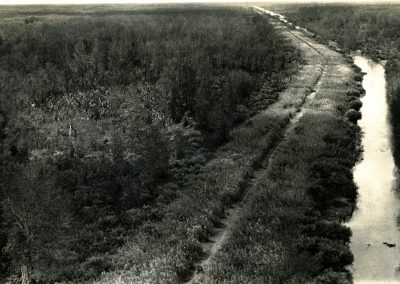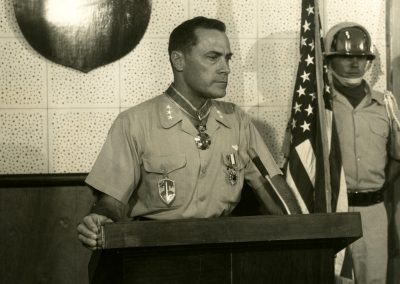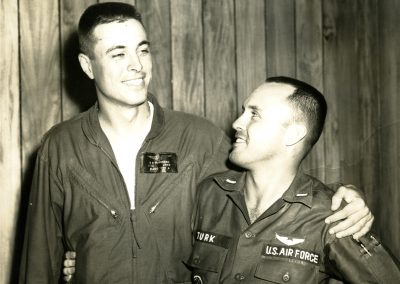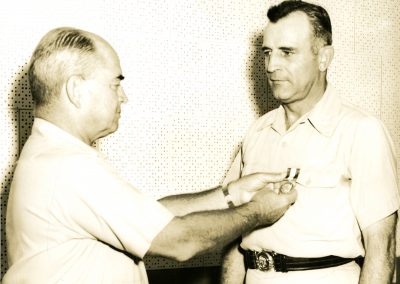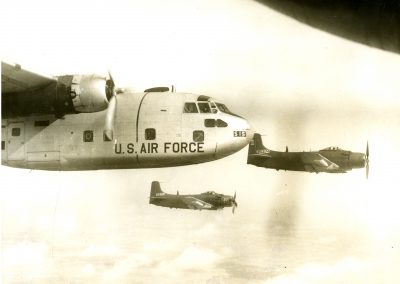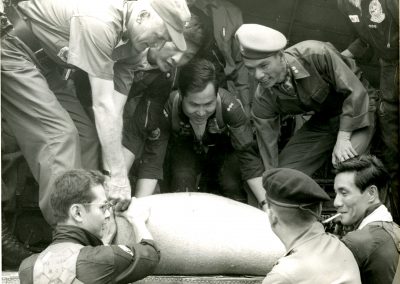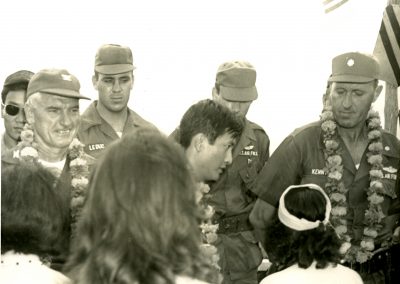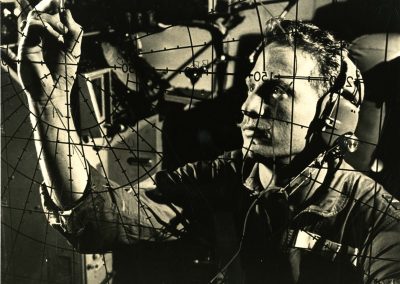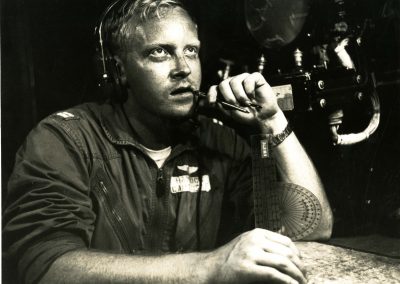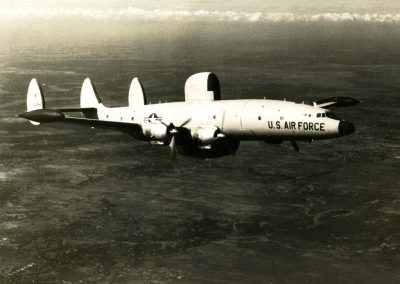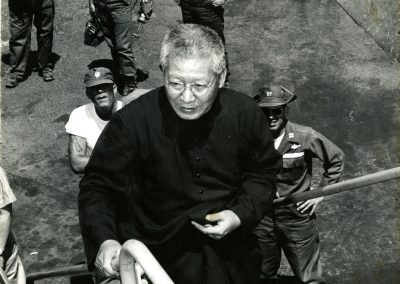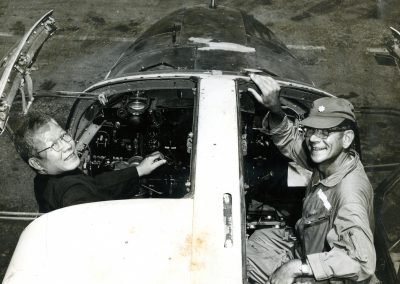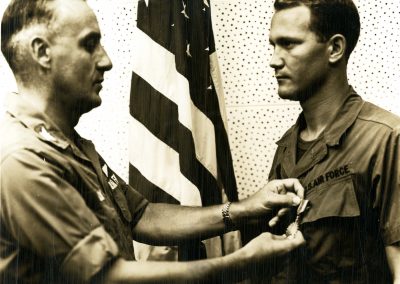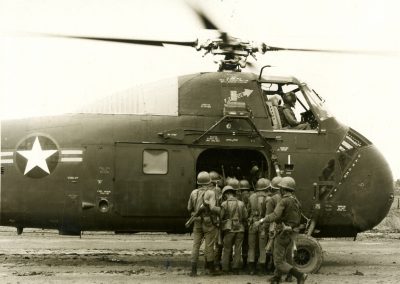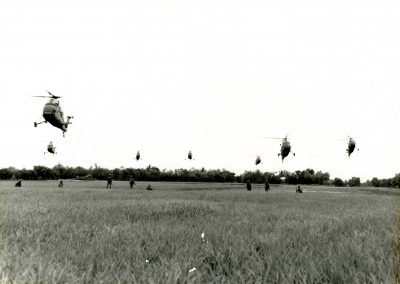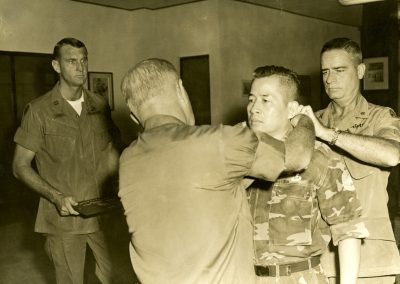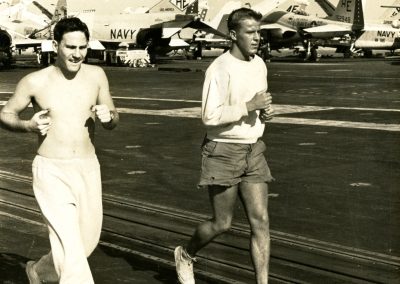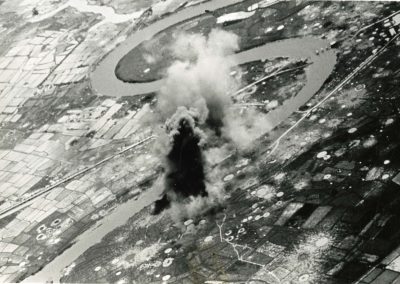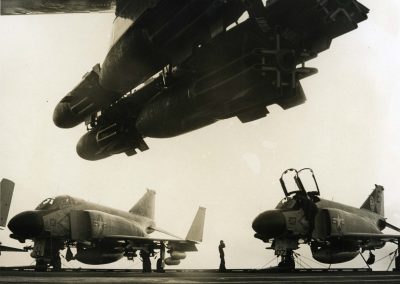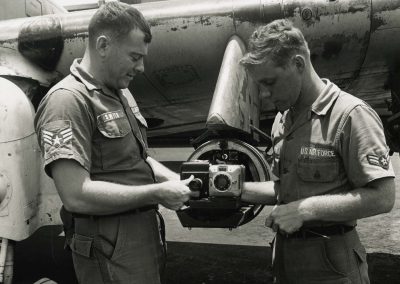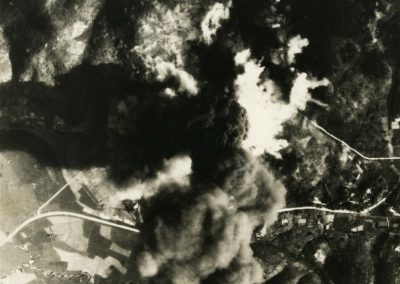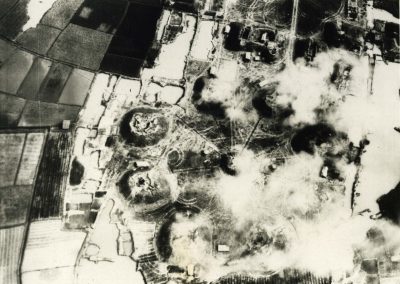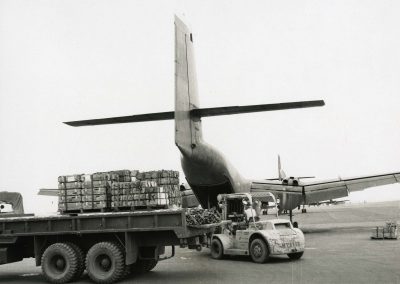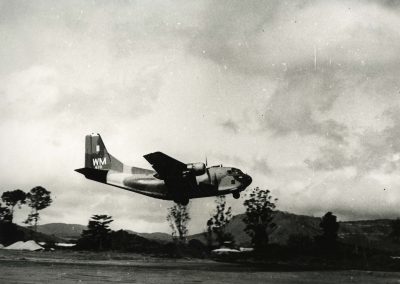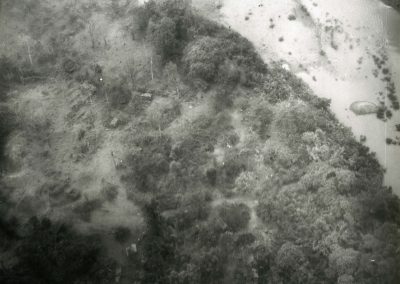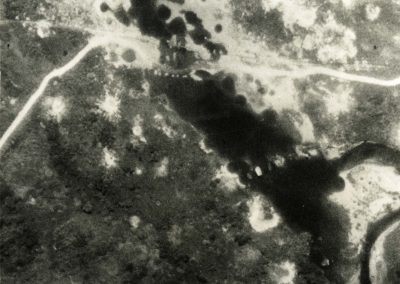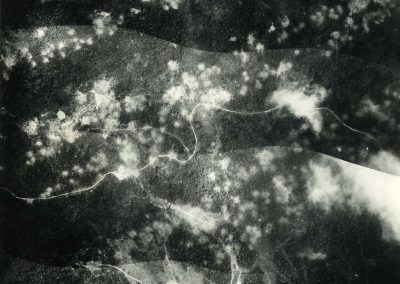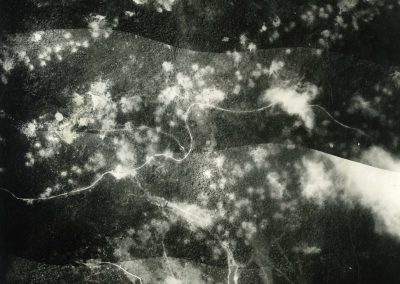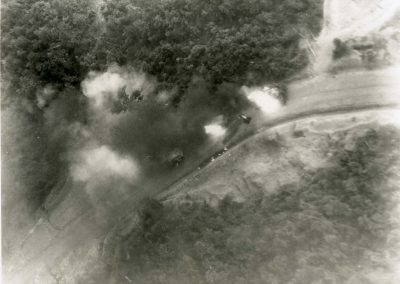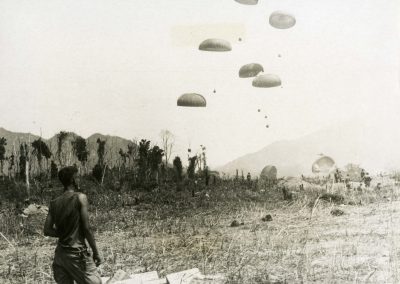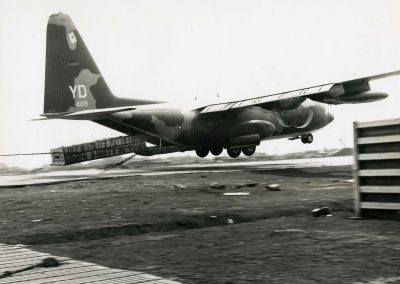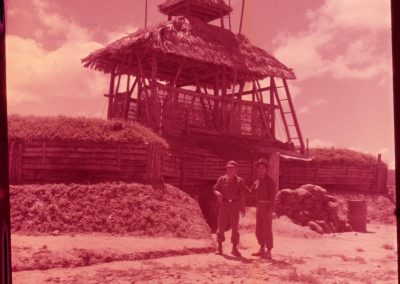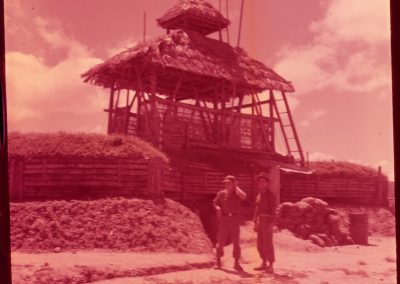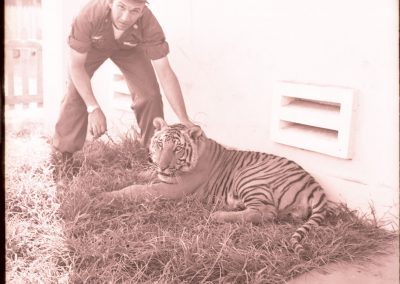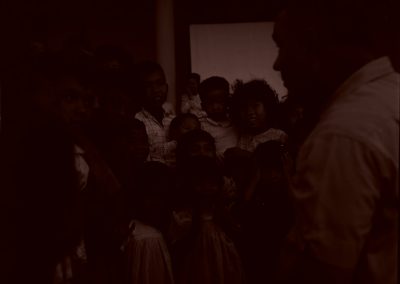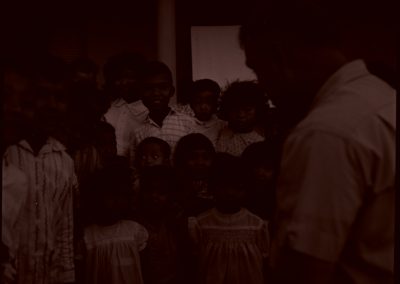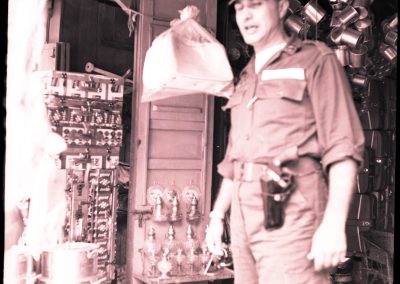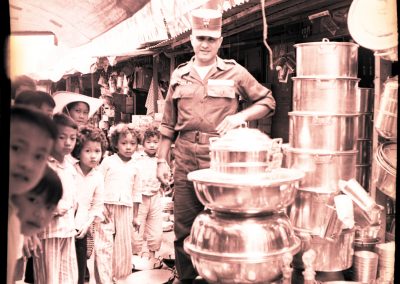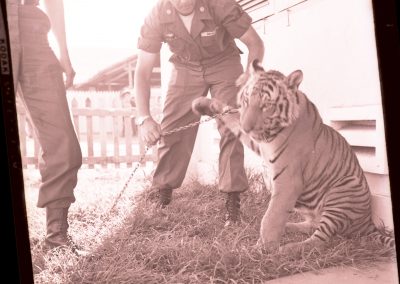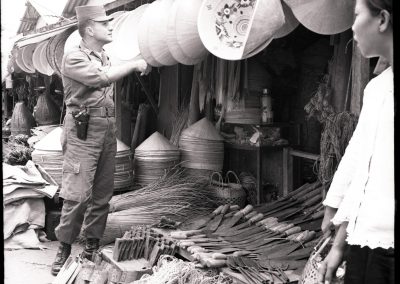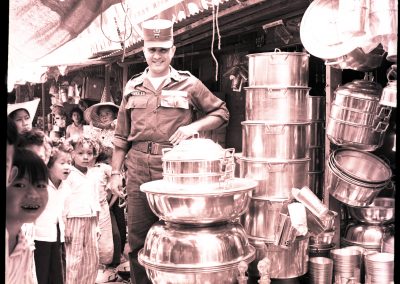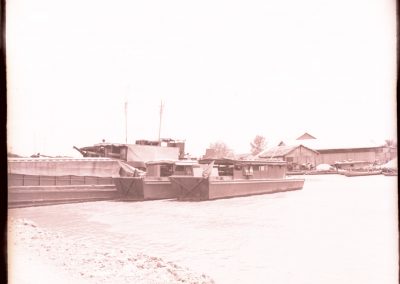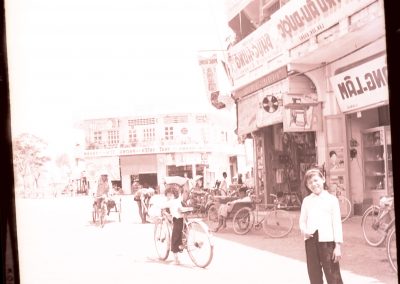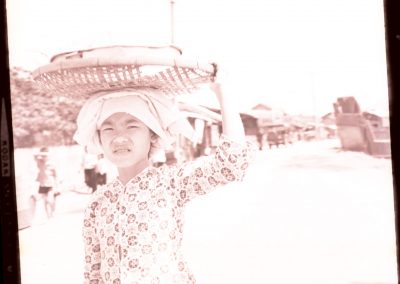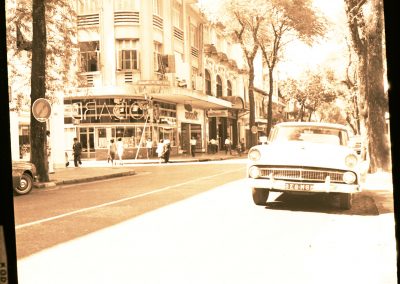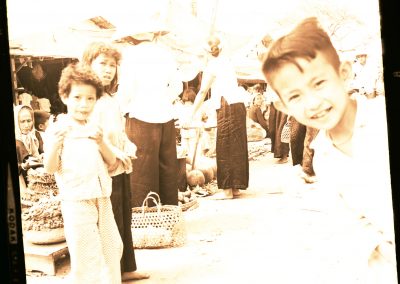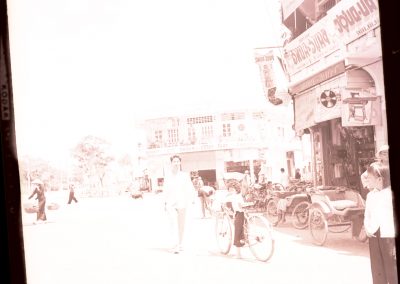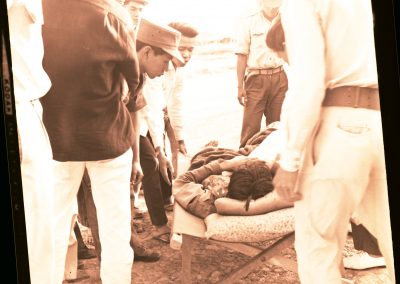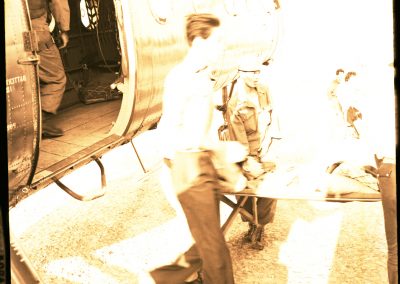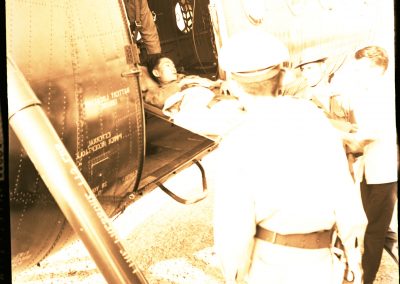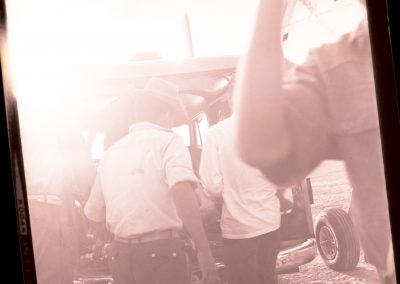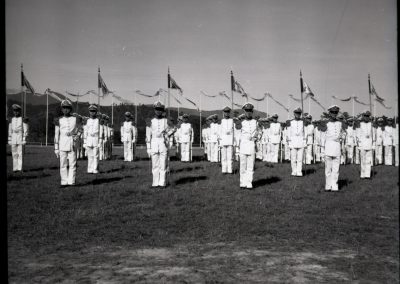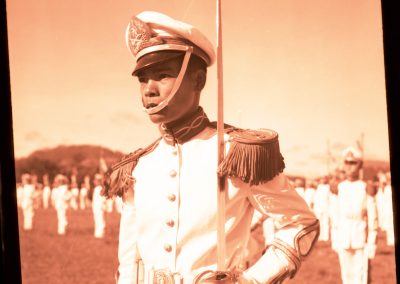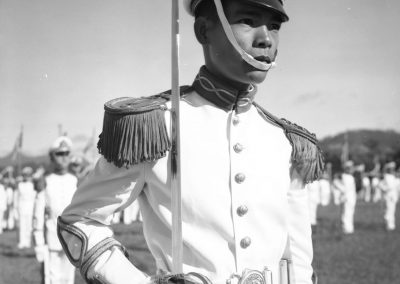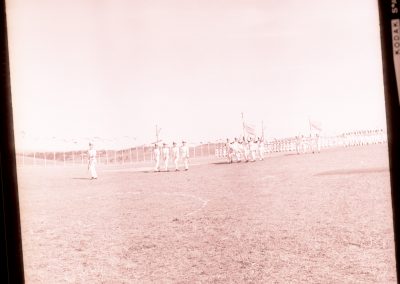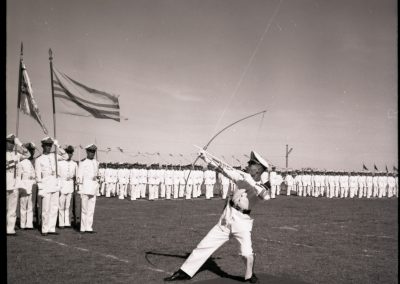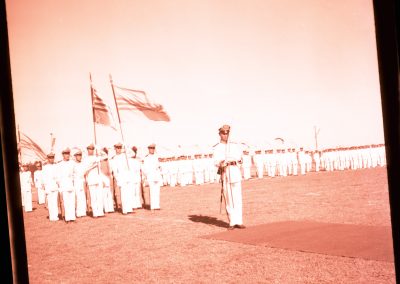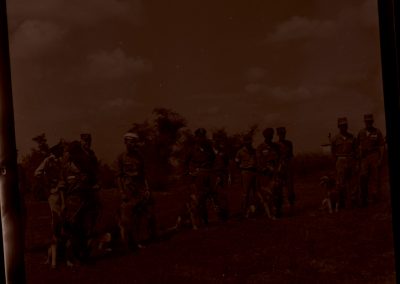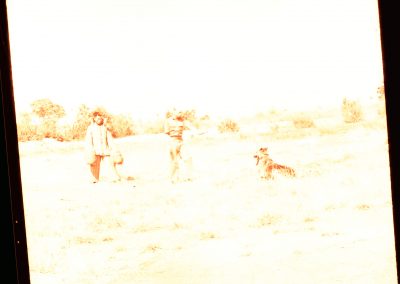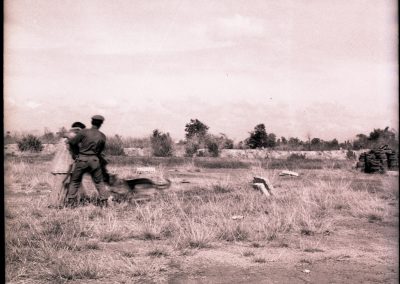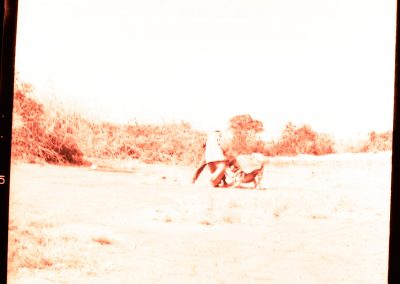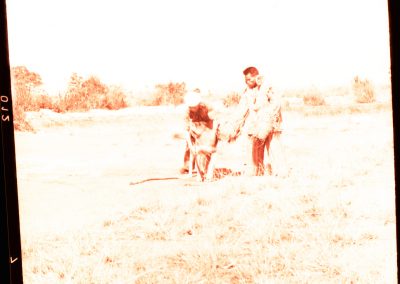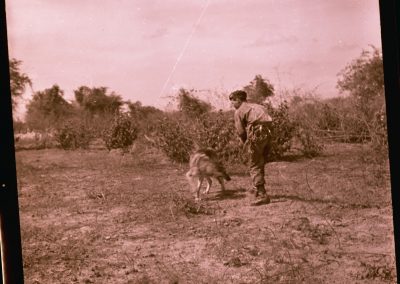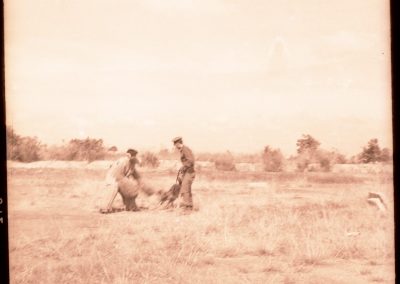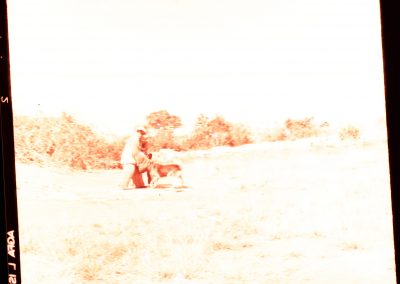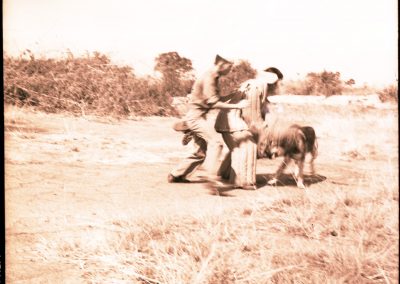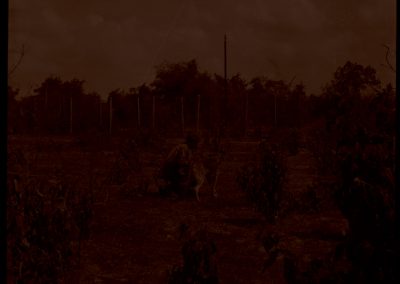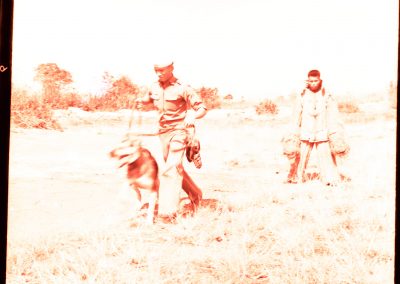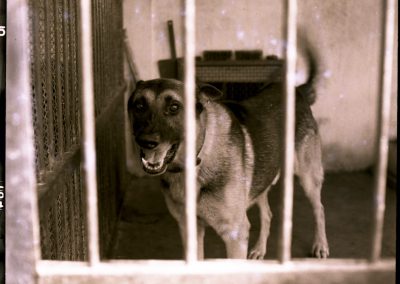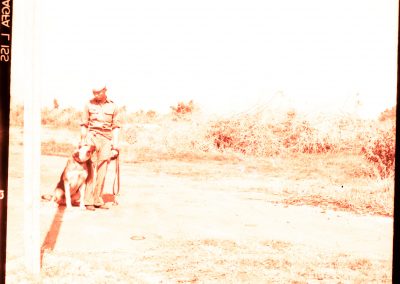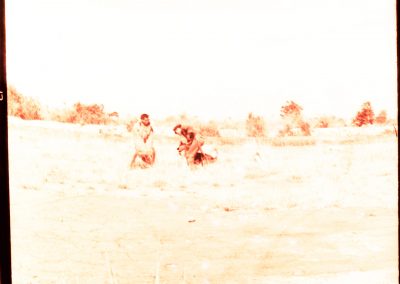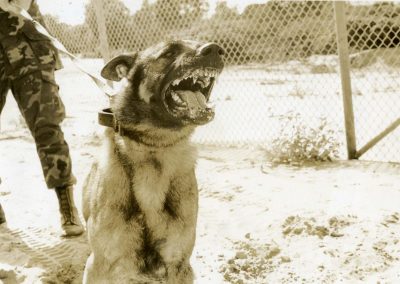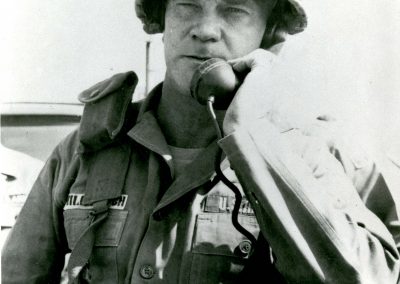Military Operations/Strategy/Background Photos
Cao Lanh (1963)
Helicopter (363-0901)
“Cao Lanh – M:VED Operation – etc.”; “A young Vietnamese soldier is walking next to a helicopter.”
Soldiers (363-0902)
“Cao Lanh – M:VED Operation – etc.” ; – “Two soldiers speak to one another around a table.”
Landscape (363-0903)
“Cao Lanh – M:VED Operation – etc.”; – “A landscape shot of soldiers in a field.”
Helicopter (363-0904)
“Cao Lanh – M:VED Operation – etc.” ; – “Several soldiers stand near the entrance of a helicopter.”
Children (363-0906)
“Cao Lanh – M:VED Operation – etc.” ; – “A bright shot of a group of Vietnamese children.”
Helicopter (363-0907)
“Cao Lanh – M:VED Operation – etc.” ; – “A bright shot of soldiers and a helicopter.”
Delta Heliborne (1963)
Delta Heliborne (363-0838)
“Delta Heliborne DPN – Mar ’63” “A small hut roofed with long grass. Cow legs can be seen through the legs of the hut.”
Delta Heliborne (363-0839)
“Delta Heliborne DPN – Mar ’63” “A group of soldiers gathering in a field of long grass and palm trees. Photo taken through the skids of a helicopter.”
Delta Heliborne (363-0840)
“Delta Heliborne DPN – Mar ’63” “A group of soldiers gathering in a field of long grass and palm trees. Photo taken through the skids of a helicopter.”
Delta Heliborne (363-0841)
“Delta Heliborne DPN – Mar ’63” “A small hut roofed with long grass. Cow legs can be seen through the legs of the hut. Another cow approaches the hut.”
Above Vietnam (363-0842)
“Delta Heliborne DPN – Mar ’63” “An aerial view of the ground. Some of the plains appear to be flooded.”
Delta Heliborne (363-0843)
“Delta Heliborne DPN – Mar ’63” “A group of soldiers running through an uneven field of tall grass.”
Bien Hoa (1965)
Harold Johnson (363-02496)
Bien Hoa, Vietnam (IO) – General Harold K. Johnson, U.S Army Chief of Staff, talks to men of the Army’s 2nd Bn, 1st Infantry Division at Bien Hoa – The 1st Div. was one of several units visited by General Johnson during his visit to Vietnam. Weapon in foreground is a Chinese Machine Gun captured by the 173rd.
Harold Johnson Rides Air Boat (363-02497)
Thuyen Nhon, Vietnam (Army IO) – General Harold K. Johnson rides an air boat used by Special Forces troops to patrol the many canals in the delta region. The Army Chief of Staff was visiting the Tuyon Nhon Special Forces camp in the 1V Corps area.
Santa Claus Propels from Helicopter (363-02498)
Saigon, Vietnam (Army IO) – Happy Vietnamese orphans wait for Santa Claus to rappel to the ground and start the Christmas party the officers and men of the 120th Aviation Company sponsored for the children. The 120th commander, Major William Chamberlin, played the part of Santa Claus.
Harold Johnson is Greeted (363-02499)
Arrival of General Harold K. Johnson, Army Chief of Staff to Vietnam. General Johnson is greeted by Maj. General W.B. Rosson, Chief of Staff, MACV at Saigon Airport, Saigon Vietnam.
Plane in Wreckage (363-03206)
Several soldiers are seen standing around planes that have landed among the Wreckage of Bien Hoa
Plane in Wreckage (363-03207)
A soldier is seen walking away from a plane landed among the wreckage of Bien Hoa
Military Operations (1965)
Military Operations (363-0045)
“September 1965 – Military Operations.” A soldier looks back at the camera from the porthole of a tank. Two other tanks in the background.
Military Operations (363-0046)
“September 1965 – Military Operations.” A procession of tanks. Three men sit atop Tank B43. One soldier sits on a second tank in the background.
Military Operations (363-0047)
“September 1965 – Military Operations.” A Negro soldier in tank porthole, speaking into headset.
Military Operations (363-0048)
“September 1965 – Military Operations.” A Negro soldier in tank porthole.
Military Operations (363-0049)
“September 1965 – Military Operations.” A Negro soldier in tank porthole.
Military Operations (363-0050)
“September 1965 – Military Operations.” A soldier talking with Iht and another man outside a village of thatched-roof cottages and palm trees. A group of children watch from around a 1960 Buick.
Military Operations (363-0051)
“September 1965 – Military Operations.” Two soldiers talk with tank gunner in the background.
Military Operations (363-0052)
“September 1965 – Military Operations.” A soldier gives or recieves orders from tank gunner in the background. A second soldier runs to meet him.
Military Operations (363-0053)
“September 1965 – Military Operations.” A soldier stands on Tank B41, talking with the gunner. Another gunner sits in a second tank in the background.
Military Operations (363-0054)
“September 1965 – Military Operations.” A tank crossing an open, hilly field. A soldier’s left shoulder has obscured part of the right side of the picture.
Military Operations (363-0055)
“September 1965 – Military Operations.” A soldier adjusts the turret gun of tank B41.
Military Operations (363-0056)
“September 1965 – Military Operations.” Iht stands outside a building attached to a bridge. Marshy land leads to water in the background.
Military Operations (363-0057)
“September 1965 – Military Operations.” Four soldiers sitting on a tank in an open, hilly field.
Military Operations (363-0058)
“September 1965 – Military Operations.” The gunner of Tank B41 waiting for further instruction.
Military Operations (363-0059)
“September 1965 – Military Operations.” A Vietnamese landscape of shrubs and small hills. A tank rolls toward the right background.
Military Operations (363-0060)
“September 1965 – Military Operations.” The gunner of Tank B41 taking aim. A second soldier reaches behind the first.
Military Operations (363-0061)
“September 1965 – Military Operations.” The gunner of Tank B41 taking aim. A second soldier sits beside and watches.
Military Operations (363-0062)
“September 1965 – Military Operations.” Iht (in civilivan clothes) points at another soldier outside a thatched-roof village. A crowd of children and a third soldier among them, stand around a 1960 Buick.
Military Operations (363-0063)
“September 1965 – Military Operations.” A Negro soldier in the porthole of a tank removes his helmet.
Military Operations (363-0064)
“September 1965 – Military Operations.” Four soldiers on three tanks in formation. Tank B12 is in the middle.
Military Operations (363-0065)
“September 1965 – Military Operations.” Four soldiers on three tanks in formation. Tank B12 is in the middle. Right corner of picture is slightly obscured.
Military Operations (363-0066)
“September 1965 – Military Operations.” Four soldiers on three tanks in formation. Tank B12 is in the middle. Right corner of picture is slightly obscured.
Military Operations (363-0067)
“September 1965 – Military Operations.” Tank with seven soldiers on top approach photographer.
Military Operations (363-0068)
“September 1965 – Military Operations.” Six soldiers stand in a horseshoe, discussing some papers. Two other soldiers in background.
Military Operations (363-0069)
“September 1965 – Military Operations.” Six soldiers stand in a horseshoe, discussing some papers. Two other soldiers in background.
Military Operations (363-0070)
“September 1965 – Military Operations.” Six soldiers stand in a horseshoe, discussing some papers (one obscured). Three other soldiers in background.
Military Operations (363-0071)
“September 1965 – Military Operations.” A crowd of Vietnamese children scramble to fit into the picture Iht (in civilian clothes) is preparing to take. Two other soldiers are caught in the crowd.
Military Operations (363-0072)
“September 1965 – Military Operations.” Iht grins at the camera, surrounded by children with their hands extended. Two soldiers stand in the crowd.
Military Operations (363-0073)
“September 1965 – Military Operations.” Two Vietnamese soldiers pose for a photo. The first soldier is named “Iht.” Two children stand beside them. Behind, another soldier leans against a military jeep.
Military Operations (363-0074)
“September 1965 – Military Operations.” Iht (in civilian clothes) stands in a crowd of excited children. In the background are two military jeeps and a Vietnamese buffalo.
Military Operations (363-0075)
“September 1965 – Military Operations.” Iht walking along a country path, looking back at photographer. A woman wearing a coolie hat also walks on the path, carrying two bales of hay on a yolk across her shoulders. Buildings line the horizon.
Military Operations (363-0076)
“September 1965 – Military Operations.” Iht listening to group of children. Behind him are two other soldiers. In the background are two military jeeps and a Vietnamese buffalo.
Military Operations (363-0077)
“September 1965 – Military Operations.” Iht (in civilian clothes) stands in front of a building. Behind him stands an older man in traditional Vietnamese garb.
Military Operations (363-0078)
“September 1965 – Military Operations.” Iht stands in the road amid a large group of children. Tall, tropical plants line the road.
Military Operations (363-0079)
“September 1965 – Military Operations.” Five tanks in a hilly field. The center tank is opened at the rear, revealing more soldiers inside.
Military Operations (363-0080)
“September 1965 – Military Operations.” Five tanks in a hilly field. The center tank is opened at the rear, revealing more soldiers inside.
Military Operations (363-0081)
“September 1965 – Military Operations.” Three soldiers run through a field, a tank to their right. The field is edged by a forest. Vague outlines of mountains rest on the horizon.
Military Operations (363-0082)
“September 1965 – Military Operations.” Two tanks in the brush. Photo taken from atop the second tank. A Negro soldier works from this tank.
Military Operations (363-0083)
“September 1965 – Military Operations.” Two soldiers atop Tank B12. A third soldier’s head partially obscures the picture.
Military Camp (1965)
Soldier (363-02840)
Soldier is smoking what appears to be a cigar as he walks towards the camera. A military camp/base appears to be in the background.
Soldier (363-02841)
Soldier appears to be preparing to smoke a cigar. A military base/camp appears to be in the background
Group of Soldiers (363-02843)
A group of soldiers are standing in plumes of smoke outside a tent for what appears to be for a meal time.
Soldiers At Table (363-02844)
A group of soldiers is sitting at a table in the middle of what appears to be a military base/camp.
Soldiers Sitting (363-02845)
Three soldiers are sitting on the ground near some small trees. A fourth soldier is seen leaning against a tree in the background.
Soldiers Around Map (363-02848)
A group of soldiers are standing/kneeling around what appears to be a map.
Soldiers Around Map (363-02849)
A group of soldiers are standing/kneeling around what appears to be a map.
Soldiers on Path (363-02852)
Two soldier are seen on a road/path. One is kneeling in the foreground as the other is seen running in the background.
Soldiers on Path (363-02854)
Two soldiers are seen on some path/road. The soldier in the foreground is kneeling and other in the background is standing.
Soldiers on Path (363-02855)
Two soldiers are seen walking along some path/road. The two soldiers are ahead the photographer.
African American Soldier (363-02858)
A photograph of an African America soldier is taken as he walks through what appears to be his camp/base.
Soldier (363-02859)
A soldier is seen walking around a base/camp carrying some weapons. A jeep is seen in the background.
Soldiers (363-02860)
Soldiers are seen to be gearing up. Two soldier appear to be attaching something to a third soldiers back. Other soldiers are seen in the background.
Soldiers (363-02861)
Three soldiers have their photo taken. Other soldiers are seen in the background.
Soldiers Playing Volleyball (363-02865)
A group of soldiers are seen readying for a game of volleyball.
Make Shift Theater (363-02866)
Three soldiers are seen standing near what appears to be a make-shift theater located in a base camp.
Playing Chess (363-02867)
Two soldiers are seen sitting under a tent like structure playing a game of chess.
Tent Lines (363-02868)
Rows of tents are pictured. The tents are put in several rows within some trees.
Soldier in Camp (363-02872)
A soldier is seen standing near tents and a laundry line within his camp.
Soldiers in Camp (363-02874)
Several soldiers are photographed while in their camp. More soldiers are seen within the background.
Soldier in Camp (363-02876)
A soldier is pictured in his camp behind a tent. He appears to be holding a stick.
Soldier with Supplies (363-02878)
A soldier is photographed in his camp some supplies in a box are seen at his feet. He also appears to be holding something in his hand.
Soldier with Supplies (363-02879)
A soldier is photographed in his camp some supplies in a box are seen at his feet. He also appears to be holding something in his hand.
Soldier in Trench (363-02881)
A soldier is photographed standing in a sandbag trench, he is also standing next to a large weapon/gun which is propped against the sandbag structure.
Soldier in Trench (363-02882)
A soldier is photographed standing in a sandbag trench, he is also standing next to a large weapon/gun which is propped against the sandbag structure.
Soldier in Tank (363-02883)
A soldier is pictured in a tank. He appears to be looking through the scope. Other soldiers are surrounding the tank.
Hammock (363-02884)
A soldier is relaxing in a hammock, other soldiers are seen talking to him as the photo is taken.
Hammock (363-02885)
A soldier is relaxing in a hammock in his camp. He appears to be reading something.
Soldier Near Covered Trench (363-02886)
A soldier is photographed near an open trench. The trench appears to have a cover to hide the trench.
Soldier Near Covered Trench (363-02887)
A soldier is photographed near an open trench. The trench appears to have a cover to hide the trench.
Soldiers on Road (363-02891)
Soldiers are photographed walking along a road towards a sandbag structure.
Soldiers on Road (363-02892)
Soldiers are photographed walking along a road towards a sandbag structure.
Tan Son Nhut (1965)
Armament Specialist (363-02456)
Hq 2AD Tan Son Nhut afld – RVN – Armament Specialist – U.S. Air Force A2C Ross J. Nicholson, of Grove City, Pa., a U.S. Air Force armament specialist, works on the hot gun bay of a North American F-100 Aupersabre of the 481st Tactical Fighter Squadron, Airman Nicholson is loading 20mm cannon shells in the Supersabre for a sortie somewhere in the Republic of Vietnam.
Cabin Secure (363-02457)
Hq 2AD Tan Son Nhut – Cabin Secure – U.S. Air Force A2C William R. Rumsey of 3109 Valley View, Dallas, Tex., a C-130 Hercules loadmaster, tells his aircraft commander, via intercom, that his cargo cabin is secure. This photo was shot just prior to takeoff from Pleiku Airfield, Republic of Vietnam.
Adding Hydraulic Fluid (363-02458)
Hq 2AD Tan Son Nhut – Inflight – U.S. Air Force A2C John H. Paxton of RT. 4, box 23, Glendenin, Va., adds hydraulic fluid to the hydraulic system of his lockhead C-130 Hercules. At the time, Airman Pacton, maintenance crew chief of his aircraft was on a flight over the Republic of Vietnam.
Unloading Bombs (363-02475)
Hq 2AD Tan Son Nhut Afld, RVN – U.S. Air Force B-52 Stratofortressesses of the Strategic Air Command unload tons of bombs on a strike against the notorious Viet Cong hideway, Zone D, during a July raid.
Ban Nuoc Chieu (363-02482)
A U.S. Air Force aerial reconnaissance photo of the Ban Nuoc Chieu ammunition depot, 80 miles west-northwest of Hanoi, shows heavy damage inflicted by U.S. Air Force Strikes in late June. This section of the target area covers about 700 by 1200 feet. Debris in the center and right side of the photo reveal areas where buildings were completely destroyed. Reports showed 22 buildings destroyed and seven others damaged during the strikes. Roadways in the target area were also heavily damaged.
Than Hoa Barracks (363-02487)
Hq 2AD, Tan Son Nhut Afld, RVN – Than Hoa Barracks – This reconnaissance photo of a U.S. Air Force stirke against North Vietnam’s Than Hoa Army Barracks (July 7) shows about half the barracks area destroyed. Large craters and debris in the upper portions of the photo are all that reamins of areas once covered by barracks buildings. Effect of bombs on highways can be seen in the lower center.
Silver Stars for MIG Kills (363-02488)
Hq 2AD, Tan Son Nhut Afld, RVN – Silver Stars for MIG Kills – Lt. Gen. Joseph H. Moore, commander of the 2d Air Division with headquarters here, awards Silver Star medals to F-4C aircraft commanders who downed two Communist MIG-type jets over North Vietnam yesterday. Accepting the awards are U.S. Air Force pilots Capt. Kenneth D. Holcombe of Detroit, Mich., and Capt. Thomas S. Roberts of LaGrange, Ga. The MIGs were the first shot down by U.S. Air Force pilots in the Vietnamese conflict.
US Air Forces First Vietnam MIG Killers Whoop It Up (363-02489)
Hq 2AD, Tan Son Nhut afld, RVN – U.S. Air Force’s First Vietnam MIG Killers Whoop It Up – Following awards of Silver Stars and Distinguished Flying Across by 2d Air Division Commander Lt. Gen Joseph H. Moore at Ten Nhut Airfield today, members of the first U.S. Air Force flight to down Communist MIG Airfield jets whoop it up. Flight Commander Maj. Richard Hall of Forest Lake, Minn., gets a ride to the shoulders of other members of the flight, 1. 1st Lt. George Larson of Winter Haven, Fla.; Capt. Ronald C. Anderson of Fairbanks, Alaska; Capt. Kenneth D. Holcombe of Detroit, Mich,; Capt. Thomas Roberts of LaGrange, Ga.; Capt. Harold Anderson of Yucaipa, Calif.; Major Hall; Capt. Arthur C. Clark of McAllen, Tex., and Capt. Wilbur Anderson of Tarboro N.C.
Dien Bien Phu Runway (363-02490)
Hq 2AD, Tan Son Nhut Afld, RVN – Dien Bien Phu Runway – July strikes against the Dien Bien Phu airfield in North Vietnam by U.S. Air Force Republic F-105s and McDonnel F-4s have left the airfield runway unusable. A direct hit (lower left) and several other 750 pound bomb blasts )center_ effectively cratered the airstrip.
Supply Route Cut (363-03210)
Hq 2AD Tan Son Nhut Afld RVN – Supply Route Cut – A flight of four U.S. Air Force F-105 Thunderchiefs knocked out one span of the Vinh Tuy Highway Bridge on Aug. 11. After cutting the Communist supply route, the F-105 piloted by Capt. Lawerence D. Wilson of Cleveland, Ohio, was downed by anti-aircraft fire. Captain Wilson ejected from his aircraft was rescued from the Gulf of Tonkin by an HU-16 Albatross.
Davis and Duchess (363-03211)
Hq 2AD Tan Son Nhut Afld, RVN – Plucky Sentry dog – Duchess, a U.S. Air Force sentry dog poses with her handler. A2C Clifford F. Davis of Knoxville, Tenn. The German Shepard probably saved Airman Davis’ life last week when she tooks a bite from a krait snake in tall grass while on patrol. Krait bites are fatal to humans in almost every instance, but the plucky sentry dog survived and is back on duty.
Plei Me (1965)
Helicopters Landed in Field (363-1172)
“Plei Me – Bak To Oct 65” ; “A line of landed helicopters lay sit in a field.”
Damages (1965)
1965/66 (363-0617)
Original caption: “1965/66” Two men walk through the rubble of a city. In the foreground, a 1960 Volkswagon Beetle is covered with rubble and torn fabric.
1965/66 (363-0618)
Original caption: “1965/66” A man in uniform climbs over a ruined 1960 Volkswagon Beetle. Rubble and torn fabric litter the street.
1965/66 (363-0619)
Original caption: “1965/66” A group of men in uniform arrive outside a ruined building with a truck filled with supplies.
1965/66 (363-0620)
Original caption: “1965/66” A man in uniform outside a ruined building, perhaps unloading something. The blurred face of another man obscures most of the picture.
1965/66 (363-0621)
Original caption: “1965/66” A group of men in uniform arrive outside a ruined building with a truck filled with supplies.
Navy Photos (1965)
Swift Ships on Christmas (363-02622)
SWIFTS boats try-out their sea legs upon arrival in Vietnam. Six SWIFTs arrived on Christmas Eve to join two others in Operation Market Time patrols off Phu Quoc Island in the Gulf of Thailand. Manned by U.S. Navy crews, these boats will patrol in conjunction with other Market Time unit to prevent inflitrations of men, arms and equipment by the Viet Cong.
Coast Guard Cutter (363-02828)
Coast Guard Cutter – Wearing a war zone coat of gray paint over her standard coat of white, the Coast Guard Cutter Point Grey operates on patrol out of An Thoi, Phu Quoc island, in the Gulf of Thailand. Seventeen cutters have been operating as units of the Coastal Surveillance Force since July of 1965, eight in Da Nang and nine in An Thoi.
Swift (363-02829)
Swift – Capable of speeds in excess of 25 knots, this 50-footer is aptly named the SWIFT. It mounts a twin .50-cal. Machine gun atop the pilot house and carriers a dual-mount combination, .50-cal machine gun and 81mm mortar aft. The first SWIFTS arrived in South Vietnam on Oct. 31, 1965, when they went on patrol out of An Thoi, Phu Quoc Island, as units of the Coastal Surviellance Force, engaged in preventing the inflitration of men, arms and supplies into the country for the Viet Cong.
Swift (363-02830)
Swift – Capable of speeds in excess of 25 knots, this 50-footer is aptly named the SWIFT. It mounts a twin .50-cal maching gun atop the pilot house and carriers a dual-mount combination .50 cal. Machine gun and 81mm mortar aft. The first SWIFTs arrived in South Vietnam on Oct. 31, 1965, when they went on patrol out of An Thoi, Phu Quoc Island, as units of the Coastal Surveillance Force, engaged in preventing the inflitration of men, arms and supplies into the country for the Viet Cong.
First Aid (363-02831)
First Aid – A. U.S. Coast Guardsman administers first aid to a Vietnamese civilian junkman during an inspection of his junk in the Gulf of Thailand. Serving as units of the Coastal Surveillance Force, the Coast Guard cutters are presently engaged in preventing in the infiltration by sea of men, arms and supplies for the Viet Cong.
Cargo Check (363-02832)
Cargo Check – A Vietnamese civilian junk is searched by a Vietnamese Navy liaison officer and crewmembers of a U.S. Coast Guard cutter during a patrol in the Gulf of Thailand. The Coast Guard cutters are based at An Thoi, Phu Quoc Island and operate as units of the Coastal Surveillance Force.
Speaking to Crew (363-03196)
RADM James R Reedy, USN, Commander Task force 77 looks on as Admiral David L. MacDonald USN, Chief of Naval Operations speaks to the crew of the USS Independence
On a Bridge (363-03197)
RADM James R Reedy, USN, Commander Task Force 77 looks on as Admiral David L. MacDonald USN, Chief of Naval Operations, on the bridge of the USS Indpendence
On a Tour (363-03198)
Adm. David L MacDonald USN, Chief of Naval Operations is greeted by Capt. John E. Kennedy C.O. of the USS Independence. Adm MacDonald and his party are on a tour of naval ships and installations in the South China Sea and Vietnam.
Greeted (363-03199)
Adm. David L MacDonald USN, Chief of Naval Operations steps down from C1A/ IR- craft after landing on board the USS Independence. He is greeted by Ens. Richard E. Newbert UNSR, Air Traffic Officer
Greeted (363-03200)
RADM, James R. Reedy USN, Commander carrier task force 77 greets, Adm. David L. MacDonald USN, Chief of Naval Operations on the flight deck of the USS Independence. Vadm Paul Blackburn Commander 7th Fleet and Vadm Paul E. Ramsey are in background.
Cutting the Cake (363-03201)
During his visit to the Seventh Fleet flagship Oklahoma City Adm. David L. MacDonald, Chief of Naval Operations, cuts a cake commemorating his 59th birthday. The four-star Navy boss is touring Navy and Marine Forces in the Pacific.
Visit (363-03202)
Adm. David L. MacDonald, U.s Chief of Naval Operations, (L) is greeted by Vice Adm. Paul P. Blackburn, Jr., Commander Seveth Fleet, on the flagship Oklahoma City. During his 10-day tour of Navy and Marine forces in the Pacific, Adm. MacDonald made an overnight visit 12 Sept. to the fleet commander and his flahship.
Plane in Wreckage (363-03206)
Several soldiers are seen standing around planes that have landed among the Wreckage of Bien Hoa
Plane in Wreckage (363-03207)
A soldier is seen walking away from a plane landed among the wreckage of Bien Hoa
Amphibious Operation (1965)
Navy/Marine Amphibious Operations (363-01269)
Navy/Marine Amphibious Operations photos, 2, front. Caravan of tanks winding up hilly Huey coast.
Navy/Marine Operations (363-01270)
Navy/Marine Amphibious Operations photos, 2, back. Information on Operation.
Navy/Marine Operations (363-01271)
Navy/Marine Amphibious Operations photos, 3. Soldiers gathering on the shore.
Navy/Marine Amphibious Operations (363-01272)
Navy/Marine Amphibious Operations photos, 4. Troops running from ships onto shore.
Navy/Marine Amphibious Operations Photos (363-01273)
Navy/Marine Amphibious Operations photos, 5, front. A ship cruising beside a line of small boats. Another small boat is in the foreground.
Military Vehicles (1965)
Soldiers in Camp (363-03178)
Several soldiers are seen either loading/unloading a military vehicle in camp
Soldiers in Camp (363-03179)
Several soldiers are seen either loading/unloading a military vehicle in camp
Soldiers in Camp (363-03180)
Several soldiers are seen either loading/unloading a military vehicle in camp
B-52 Raid (1965)
B-52 Raid (363-0624)
“B-52 Raid – Q. Tri – Aug 1965” An aerial view of the ground. Land dotted with trees and buildings stand in the shadow of mountains. The door of an airplane can be seen on the left.
B-52 Raid (363-0625)
“B-52 Raid – Q. Tri – Aug 1965” An aerial view of the ground. Land dotted with trees and buildings stand in the shadow of mountains. A river winds through the landscape. The door of an airplane can be seen on the left.
B-52 Raid (363-0626)
“B-52 Raid – Q. Tri – Aug 1965” An aerial view of the ground. Land dotted with trees and buildings stand in the shadow of mountains. A river winds through the landscape. The door of an airplane can be seen on the left.
B-52 Raid (363-0627)
“B-52 Raid – Q. Tri – Aug 1965” An aerial view of the ground. People can be seen walking along the dirt road. A cloud of smoke or perhaps dust drifts in the upper right corner.
B-52 Raid (363-0628)
“B-52 Raid – Q. Tri – Aug 1965” An aerial view of the ground. The wide leaves of a group of shrubs bend in the wake of the airplane from which the photo was taken.
B-52 Raid (363-0629)
“B-52 Raid – Q. Tri – Aug 1965” The ground and some shrubs. White flecks in the upper right corner are photo damages.
B-52 Raid (363-0630)
“B-52 Raid – Q. Tri – Aug 1965” The ground and some shrubs. A man’s left foot can be seen in the bottom right corner. White flecks in the upper right corner are photo damages.
B-52 Raid (363-00631)
“B-52 Raid – Q. Tri – Aug 1965” A wide row of soldiers standing along the rim of a large crater. Mountains rise up from the background.
B-52 Raid (363-0632)
“B-52 Raid – Q. Tri – Aug 1965” A wide row of soldiers standing along the rim of a large crater. (Damaged.)
B-52 Raid (363-0633)
“B-52 Raid – Q. Tri – Aug 1965” A wide row of soldiers standing along the rim of a large crater. Mountains rise up from the background.
B-52 Raid (363-0634)
“B-52 Raid – Q. Tri – Aug 1965” A wide row of soldiers standing along the rim of a large crater. Mountains rise up from the background.
Aerial Photos (1965)
A4 Skyhawk (363-02485)
A U.S Navy A4 Skyhawk from the Seventh Fleet carrier USS Bon Homme Richard drops a napalm bomb during operations against the Viet Cong on July 1 southeast of Saigon. Pilot of the aircraft was Ens R. W. Nielson of Sacremento, Calif.
A4 Skyhawk (363-02486)
A U.S. Navy A4 Skyhawk from the Seventh Fleet carrier USS Bon Homme Richard pulls away as a napalm bomb explodes during action against the Viet Cong on July 1 southwest of Saigon. Pilot of the aircraft was Ens. R. W. Nielson of Sacremento, Calif.
Dong Hoi Barracks (363-02492)
Aerial reconnaissance of a section of the Dong Hoi army barracks, located 35 miles north of the demarcation line, shows some of the heavy damage inflicted by a joint USAF and VNAF stirke force. Eight VNAF A-1H and four USAF F-104s struck the target with 27 tns of 50 to 500 pound general bombs rockets. Reports showed that 80 percent of the barracks buildings, seen along the bottom and right side of the photo, were destroyed or damaged during the attack.
Aerial Photo – Train Attack (363-02403)
Smoke billows from a North Vietnamese train attacked by Seventh Fleet Aircraft from the carrier, USS Midway, May 4 in what a Seventh Fleet spokesman said was probably the most successful armed reconnaissance mission flown to date by naval aircraft over Vietnam. Twenty railroad cars and two locomotives were destroyed and left smoking. The train, headed southward was stopped by downed bridges over North Vietnam Tuesday after conducting three days of in country attacks against Viet Cong concentrations in South Vietnam. Some twelve aircraft, including A-4 Skyhawks and F-8 Crusaders, participated in the attack, hitting the train with 250 pound bombs, five inch zuni rockets and 20mm gunfire.
Aerial Photo – Xom Ca Trang Bridge (363-02404)
Xom Ca Trang bridge on route 12, 40 miles south of Vinh, at 12:30 today. The 2nd aircraft of the strike group scored a direct hit, dropping 1 span of the 2 span structure.
Aerial Photo – USS Enterprise (363-02405)
The nuclear powered aircraft carrier USS Enterprise became a member of the U.S Seventh Fleet today. Accompanying her was the nuclear powered guided missile frigate USS Bainbridge.
County Fair (1966)
County Fair (363-0527)
“USMC – County Fair.” Three young boys on the other side of a barbed wire fence.
County Fair (363-0516)
“USMC – County Fair.” Soldiers walking through an aisle of tents. Children can be seen within the tents.
County Fair (363-0517)
“USMC – County Fair.” A soldier carrying a rifle amid tents. On the left stands a boy wearing too-big clothes. Other children can be seen within the tents.
County Fair (363-0518)
“USMC – County Fair.” Three young Vietnamese children. The oldest, a girl in the center, is stretching. A younger girl in a broad hat stands beside her. On the other side stands a boy. Above them waves the South Vietnamese flag.
County Fair (363-0519)
“USMC – County Fair.” Image of U. S. Army soldier Svec. In the background are other men and a tent.
County Fair (363-0529)
“USMC – County Fair.” Three women in coolie hats carry large baskets full of supplies on yolks across their shoulders. The third woman has taken off her hat to shade her child. Behind, a boy carries something in his mouth. An Army soldier is crouched in the background, gathering something.
County Fair (363-0528)
“USMC – County Fair.” A young boy beside a crop field. Behind him are several other children. Ribbons tied to poles separate the field from a path. On the path stands a group of adults.
County Fair (363-0526)
“USMC – County Fair.” On the other side of some barbed wire, two young children huddle near the corner of a building.
County Fair (363-0525)
“USMC – County Fair.” On the other side of some barbed wire, a young Vietnamese boy in a Western hat strikes a pose.
County Fair (363-0524)
“USMC – County Fair.” A young Vietnamese boy in a ballcap walking up the stairs of a building. A solider approaches from the background.
County Fair (363-0523)
“USMC – County Fair.” A Marine Corps vehicle. The label “USMC 108104” can be seen on the side.
County Fair (363-0522)
“USMC – County Fair.” Soldiers sitting around and on a severely damaged tank. One soldier lies down inside while another tends to him.
County Fair (363-0521)
“USMC – County Fair.” Soldiers sitting around and on a severely damaged tank. One soldier lies down inside while another tends to him.
County Fair (363-0520)
“USMC – County Fair.” Image of U. S. Army soldier Svec. In the background are others beneath a tent.
County Fair (363-0535)
“USMC – County Fair.” A young child in a broad hat looks confusedly at the camera. Beside him, his mother carries a basket of supplies. In front of him, another young child plays in the grass.
County Fair (363-0534)
“USMC – County Fair.” A young girl in the field glances at the camera. Around her are several other young girls. IN the background, Vietnamese cattle have been led in to graze.
County Fair (363-0533)
“USMC – County Fair.” A young boy in a coolie hat holds the ropes of Vietnamese cattle.
County Fair (363-0532)
“USMC – County Fair.” A young boy in a coolie hat smiles for the camera. Carpet and other fabric is draped across his shoulder, and his hands are full. Behind him follows a line of similarly-dressed people.
County Fair (363-0531)
“USMC – County Fair.” An old woman in a large coolie hat balances a large basket of supplies on her head. Behind her stands a young boy. Others can be seen across the crop field.
County Fair (363-0530)
“USMC – County Fair.” A young boy in a field wears his shirt on his head to keep cool. Behind him, a woman with a hat-wearing baby on her hip inspects the crop. In the background are the shapes of other villagers in the field.
County Fair (363-0549)
“USMC – County Fair.” A young boy carrying papers and a basket walks forward. Behind him waits a long line of villagers.
County Fair (363-0548)
“USMC – County Fair.” A young boy carrying papers and a basket walks forward. Behind him waits a long line of villagers.
County Fair (363-0547)
“USMC – County Fair.” A young boy carrying papers and a basket walks forward. Behind him waits a long line of villagers.
County Fair (363-0546)
“USMC – County Fair.” A young child in a coolie hat carries another child on his back. Behind him, a woman hands out small white objects which might be soap.
County Fair (363-0545)
“USMC – County Fair.” Villagers and soldiers weaving through roped-off sections between tents.
County Fair (363-0544)
“USMC – County Fair.” A young boy carrying papers and a basket glances away from camera. Behind him, a group of soldiers and villagers stand between tents.
County Fair (363-0543)
“USMC – County Fair.” A young boy carrying papers and a basket glances away from camera. Behind him, a group of soldiers and villagers stand between tents.
County Fair (363-0542)
“USMC – County Fair.” A young boy carrying papers and a basket glances at camera. Behind him, a group of soldiers and villagers stand between tents.
County Fair (363-0541)
“USMC – County Fair.” A young boy carrying papers and a basket glances at camera. Behind him, a group of soldiers and villagers stand between tents.
County Fair (363-0540)
“USMC – County Fair.” Villagers and soldiers weaving through roped-off sections between tents.
County Fair (363-0558)
“USMC – County Fair.” A young boy carries a younger boy on his back. A soldier stands in the background.
County Fair (363-0557)
“USMC – County Fair.” A young girl in a coolie hat balances a large basket of supplies on her head. An older woman follows.
County Fair (363-0556)
“USMC – County Fair.” A young boy wears a shirt on his head to keep cool. He clutches some white packets in his right hand which may be soap.
County Fair (363-0555)
“USMC – County Fair.” A young girl in a coolie hat running down a path sectioned off with ribbon. Others follow close behind.
County Fair (363-0554)
“USMC – County Fair.” A young girl in a coolie hat running down a path sectioned off with ribbon.
County Fair (363-0553)
“USMC – County Fair.” Smiling people leaving the crowd with armfuls of things. Behind them are other villagers and soldiers between areas sectioned off with ribbon.
County Fair (363-0552)
“USMC – County Fair.” A young child in a coolie hat carries another child on his back. Other children follow behind.
County Fair (363-0551)
“USMC – County Fair.” A soldier pauses for a photograph on a path sectioned off by ribbons. Another soldier is walking up the path behind him. In the background, a group of soldiers walk through the field.
DaNang Harbor (1966)
Lunch Break (363-02803)
Lunch Break – Members of Hatch Team #9, Seamen Charles C. Shearon and Robert J. Kinney, Jr., and Boatswain’s Mate 2C Robert J. Ely, take mid-day, 30-minute lunch break topside on merchant vessel they are offloading. The break helps to split-up 12-hour work shift. Combat “C-rations” is the menu for lunch.
Up and Away (363-02804)
Up and Away – Combat tents bound for Marines are lifted from #1 hold of S.S. Sir John Franklin to awaiting landing craft which shuttle the vital cargo to the piers within the city of DaNang.
The Heat is On363-02805
The Heat is On – George Nolan, Boatswain’s Mate 1C, assists Robert J. Ely, Boatswain’s Mate 2C, and Bobby R. Loftis, seaman, members of his Hatch Team #9, in slinging cargo in the 130 degree heat of #1 hold aboard S.S. Sir John Franklin. The men alternate between topside and below decks every 20-30 minutes due to extreme heat.
Cargo Delivery (363-02806)
Cargo Delivery – Pier Team #16 offloads LCM-8 #870 at Museum Annex pier within the city of Da Nang. The cargo consists of beverages bound for the Army-Air Force Exchange. Just 95 minutes earlier it was in the hold of a merchant vessel anchored in Da Nang harbor.
Loading Up (363-02807)
Loading Up – LCM-8 #870 takes cargo aboard starboard-side to S.S. Sir John Franklin as Hatch Team #9 offloads combat tents destined for the Marines. “870” is one of the LCM-8’s which deliver the cargo from ship to shore.
Heading Ashore (363-02808)
Heading Ashore – LCM-8 #870 journey’s through anchorage area of DaNang hrabor enroute to Commerical Pier within the city of Da Nang. The cargo aboard the LCM-8 is combat tents slated for delivery to the Marines.
Cargo Offloading (363-02809)
Cargo Offloading – LCU’s (Landing Craft Utility) and LCM’s 8’s (Landing Craft Medium) tied-up alongside merchant vessel load-up with combat cargo. These craft make numerous shuttles a day during the 24-hour, seven-days-a-week operation.
Thanh Hoa Bombings (1966)
Devastated (363-02812)
Devastated – said Navy jet pilots of Carrier Air Wing 15, Sept. 21, 1966, after pounding a railroad ferry complex northeast of Thanh Hoa in North Vietnam. The accompanying before-and-after photos display partial effects of about 200 tons of bombs dropped during the day by Air Wing 15. In attacking the area at least 8 defending flak sites were silenced. Boxcars, tracks and bomb craters are clearly seen before-and-after being hit by A6 Intruder and A4 Skyhawk pilots.
Devastated (363-02813)
Devastated – said Navy jet pilots of Carrier Air Wing 15, Sept. 21, 1966, after pounding a railroad ferry complex northeast of Thanh Hoa in North Vietnam. The accompanying before-and-after photos display partial effects of about 200 tons of bombs dropped during the day by Air Wing 15. In attacking the area at least 8 defending flak sites were silenced. Boxcars, tracks and bomb craters are clearly seen before-and-after being hit by A6 Intruder and A4 Skyhawk pilots.
Aerial Strikes of Thanh Hoa (363-02814)
Before and After near Thanh Hoa, North Vietnam – Navy jet pilots of Carrier Air Wing 15 pounded a railroad ferry complex northeast of Thanh Hoa Sept. 21-23, 1966. Targets included a thermal power plant, defending flak sites, railways, boxcars, and roads. After the raid shown in these before and after photos, Navy Intruder and Skyhawk pilots described the area as “devastated.”
Aerial Strikes of Thanh Hoa (363-02815)
Before and After near Thanh Hoa, North Vietnam – Navy jet pilots of Carrier Air Wing 15 pounded a railroad ferry complex northeast of Thanh Hoa Sept. 21-23, 1966. Targets included a thermal power plant, defending flak sites, railways, boxcars, and roads. After the raid shown in these before and after photos, Navy Intruder and Skyhawk pilots described the area as “devastated.”
Aerial Strikes of Thanh Hoa (363-02816)
Before and After near Thanh Hoa, North Vietnam – Navy jet pilots of Carrier Air Wing 15 pounded a railroad ferry complex northeast of Thanh Hoa Sept. 21-23, 1966. Targets included a thermal power plant, defending flak sites, railways, boxcars, and roads. After the raid shown in these before and after photos, Navy Intruder and Skyhawk pilots described the area as “devastated.”
Aerial Strikes of Thanh Hoa (363-02817)
Before and After near Thanh Hoa, North Vietnam – Navy jet pilots of Carrier Air Wing 15 pounded a railroad ferry complex northeast of Thanh Hoa Sept. 21-23, 1966. Targets included a thermal power plant, defending flak sites, railways, boxcars, and roads. After the raid showin in these before and after photos, Navy Intruder and Skyhawk pilots described the area as “devastated.”
Aerial Strikes of Thanh Hoa (363-02818)
Before and After near Thanh Hoa, North Vietnam – Navy jet pilots of Carrier Air Wing 15 pounded a railroad ferry complex northeast of Thanh Hoa Sept. 21-23, 1966. Targets included a thermal power plant, defending flak sites, railways, boxcars, and roads. After the raid shown in these before and after photos, Navy Intruders and Skyhawk pilots described the area as “devastated.”
Aerial Strikes of Thanh Hoa (363-02819)
Before and After near Thanh Hoa, North Vietnam – Navy jet pilots of Carrier Air Wing 15 pounded a railroad ferry complex northeast of Thanh Hoa Sept. 21-23, 1966. Targets included a thermal power plant, defending flak sites, railways, boxcars, and roads. After the raid shown in these before and after photos, Navy Intruder and Skyhawk pilots described the area as “devastated.”
Aerial Strikes of Thanh Hoa (363-02820)
Before and After near Thanh Hoa, North Vietnam – Navy jet pilots of Carrier Air Wing 15 pounded a railroad ferry complex northeast of Thanh Hoa Sept. 21-23, 1966. Targets included a thermal power plant, defending flak sites, railways, boxcars, and roads. After the raid shown in these before and after photos, Navy Intruder and Skyhawk pilots described the area as “devastated.”
Aerial Strikes of Thanh Hoa (363-02821)
Before and After near Thanh Hoa, North Vietnam – Navy jet pilots of Carrier Air Wing 15 pounded a railroad ferry complex northeast of Thanh Hoa Sept. 21-23, 1966. Targets included a thermal power plant, defending flak sites, railways, boxcars, and roads. After the raid shown in these before and after photos, Navy Intruder and Skyhawk pilots described the area as “devastated.”
Aerial Strikes of Thanh Hoa (363-02822)
Before and After near Thanh Hoa, North Vietnam – Navy jet pilots of Carrier Air Wing 15 pounded a railroad ferry complex northeast of Thanh Hoa Sept. 21-23, 1966. Targets included a thermal power plant, defending flak sites, railways, boxcars, and roads. After the raid shown in these before and after photos, Navy Intruder and Skyhawk pilots described the area as “devastated.”
Secondary Explosion (363-02823)
Smoke 3,000 feet high – follows eruption of 500-foot-diameter fireball, Sept. 18, 1966, from secondary explosion at Ninh Binh railway in North Vietnam. Navy pilots from the carrier USS Intrepid continued a four-day attack on the area which included Nihnh Binh railroad yards, RR Bridge, RR by-pass bridge, two trains totalling nearly 100 boxcars, and about 60 trucks. One train is seen at lower left along a rocky ridge. Trucks along roads were trying to salvage cargo from the bottled up trains.
Aerial Strikes Ninh Binh (363-02824)
Aerial photo of Ninh Binh. A giant smoke cloud is seen in this photograph.
Aerial Strikes Ninh Binh (363-02826)
Aerial photo of Ninh Binh. Appears to be of an aerial photo taken near some river or stream.
Operation Mastiff (1966)
Operation Mastiff (363-0197)
“Operation Mastiff.” Airplane dropping a missile. Seen above a tree branch.
Operation Mastiff (363-0209)
“Operation Mastiff.” Prairie grass. Burred, perhaps an accidental photo.
Operation Mastiff (363-0217)
“Operation Mastiff.” A military helicopter delivering supplies and a car to the soldiers.
Operation Mastiff (363-0218)
“Operation Mastiff.” In an open field, the soldier disburse their gifts from the helicopter.
Operation Mastiff (363-0219)
“Operation Mastiff.” An open field. White dust or foam lies in patches like snow.
Operation Mastiff (363-0220)
“Operation Mastiff.” Piles of white dust in the field like white flowers.
Operation Mastiff (363-0222)
“Operation Mastiff.” An aerial view of an explosion. Thick smoke spirals up over the forest.
Operation Mastiff (363-0223)
“Operation Mastiff.” An aerial view of an explosion. Thick smoke spirals up over the forest.
Operation Mastiff (363-0224)
“Operation Mastiff.” An aerial view of an explosion. Thick smoke spirals up over the forest.
Operation Mastiff (363-0225)
“Operation Mastiff.” An aerial view of an explosion. Thick smoke spirals up over the forest.
Operation Mastiff (363-0226)
“Operation Mastiff.” An aerial view of an explosion. Thick smoke spirals up over the forest.
Operation Mastiff (363-0227)
“Operation Mastiff.” An aerial view of the ground, pockmarked from explosions.
Operation Mastiff (363-0228)
“Operation Mastiff.” An aerial view of the forest. Sploches of white powder remain from explosions.
Operation Mastiff (363-0229)
“Operation Mastiff.” An aerial view of the forest. Sploches of white powder remain from explosions.
Operation Mastiff (363-0230)
“Operation Mastiff.” An aerial view of the forest. Sploches of white powder and huge puddles remain from explosions.
Operation Mastiff (363-0231)
“Operation Mastiff.” An aerial view of some trees and a field. The road is lined with white dust.
Operation Mastiff (363-0232)
“Operation Mastiff.” An aerial view of the landscape. Several roads lead to a triangle shaped building and a canal.
Operation Mastiff (363-0233)
“Operation Mastiff.” An aerial view of the landscape. Several roads lead to a triangle shaped building and a canal.
Operation Mastiff (363-0234)
“Operation Mastiff.” An aerial view of the landscape. Several roads lead to a triangle shaped building and a canal.
Operation Mastiff (363-0235)
“Operation Mastiff.” An aerial view of the landscape. Several roads lead to a triangle shaped building and a canal.
Operation Mastiff (363-0236)
“Operation Mastiff.” An aerial view of the ground, pockmarked and powdered from explosions.
Operation Mastiff (363-0237)
“Operation Mastiff.” An aerial view of the ground, pockmarked and powdered from explosions.
Operation Mastiff (363-0238)
“Operation Mastiff.” An aerial view. Thick smoke rises over forest and farmland. A dark shadow in the left corner of the picture may be of another plume of smoke behind the photographer.
Operation Mastiff (363-0239)
“Operation Mastiff.” An aerial view. Thick smoke rises over forest and farmland. A dark shadow in the left corner of the picture may be of another plume of smoke behind the photographer.
Operation Mastiff (363-0240)
“Operation Mastiff.” A campground: Soldiers sitting on a truck loaded with supplies. Several metal bins and barrels surround the them.
Operation Mastiff (363-0241)
“Operation Mastiff.” A campground: several men sit beside what may be the wing to a plane that needs repairing.
Operation Mastiff (363-0242)
“Operation Mastiff.” A campground: several men sit beside what may be the wing to a plane that needs repairing.
Operation Mastiff (363-0243)
“Operation Mastiff.” A campground: several men sit beside what may be the wing to a plane that needs repairing.
Operation Mastiff (363-0244)
“Operation Mastiff.” A campground: several men stand around their tents. Smoke rises from the background.
Operation Mastiff (363-0245)
“Operation Mastiff.” A campground: several men stand around their tents. Smoke rises from the background.
Operation Mastiff (363-0246)
“Operation Mastiff.” An aerial view of the soldier’s campground. Two helicopters descend.
Operation Mastiff (363-0248)
“Operation Mastiff.” An aerial view of the ground. Sploches of white powder remain from the explosions.
Operation Mastiff (363-0249)
“Operation Mastiff.” An aerial view of the ground. Sploches of white powder remain from the explosions.
Operation Mastiff (363-0250)
“Operation Mastiff.” An aerial view of the ground. Sploches of white powder remain from the explosions.
Operation Mastiff (363-0252)
“Operation Mastiff.” An aerial view of the ground. Sploches of white powder remain from the explosions.
Operation Mastiff (363-0253)
“Operation Mastiff.” An aerial view of the ground. Sploches of white powder remain from the explosions.
Operation Mastiff (363-0254)
“Operation Mastiff.” An aerial view of the ground. Sploches of white powder remain from the explosions.
Operation Mastiff (363-0255)
“Operation Mastiff.” An aerial view of the ground. Two military helicopters land beside white splotches of dust from explosions.
Operation Mastiff (363-0256)
“Operation Mastiff.” An aerial view of the ground. Some white dust from an explosion in the upper right. May be soldiers setting up camp.
Operation Mastiff (363-0257)
“Operation Mastiff.” A campground: Soldiers sitting on a truck loaded with supplies.
Operation Mastiff (363-0258)
“Operation Mastiff.” A soldier sitting in a ditch, speaking into a communicator.
Operation Mastiff (363-0260)
“Operation Mastiff.” Six soldiers standing together in an open field. In the upper left corner are another soldier and a helicopter.
Operation Mastiff (363-0261)
“Operation Mastiff.” Four soldiers walking through an open field. Another soldier and a helicopter are in the upper right corner. In the background is a second helicopter.
Operation Mastiff (363-0262)
“Operation Mastiff.” Two soldiers sitting in a crater, possibly resulting from an explosion. One talks on his communicator and pushes dust with a stick while the other smiles at something in his hand.
Operation Mastiff (363-0263)
“Operation Mastiff.” Two soldiers sitting in a crater, possibly resulting from an explosion. One talks on radio. Above, three other soldiers walk in an open field.
Operation Mastiff (363-0265)
“Operation Mastiff.” Three soldiers standing in a pile of white dust, likely resulting from an explosion.
Operation Mastiff (363-0266)
“Operation Mastiff.” A Negro soldier sitting in a crater of whit dust, likely resulting from an explosion. In the lower left corner a second soldier sits.
Operation Mastiff (363-0267)
“Operation Mastiff.” A helicopter in an open field. Three soldiers run from it while one runs toward it.
Operation Mastiff (363-0268)
“Operation Mastiff.” A blurry picture of prairie grass, likely taken unintentionally.
Operation Mastiff (363-0269)
“Operation Mastiff.” A blurry picture of prairie grass, likely taken unintentionally.
Operation Mastiff (363-0270)
“Operation Mastiff.” An open field. In the background, fog has settled over the soldiers’ camp pitched in front of some trees.
Operation Mastiff (363-0271)
“Operation Mastiff.” An open field. In the background, fog has settled over the soldiers’ camp pitched in front of some trees.
Operation Mastiff (363-0272)
“Operation Mastiff.” An open field. In the background, fog has settled over the soldiers’ camp pitched in front of some trees.
Operation Mastiff (363-0273)
“Operation Mastiff.” An open field. In the background, fog has settled over the soldiers’ camp pitched in front of some trees.
Operation Mastiff (363-0274)
“Operation Mastiff.” Soldiers’ camp pitched in an open field. Trees line the background.
Operation Mastiff (363-0275)
“Operation Mastiff.” A helicopter descending on the soldiers’ camp pitched in an open field. Trees line the background.
Operation Mastiff (363-0276)
“Operation Mastiff.” An aerial view of the ground: trees grow on either side of a wide river. To the left of the trees are open plains. To the right is cultivated land. A cloud of white dust or smoke obscures the bottom left and into the middle.
Operation Mastiff (363-0277)
“Operation Mastiff.” An aerial view of the ground: trees grow on either side of a wide river. To the left of the trees are open plains. To the right is cultivated land. A cloud of white dust or smoke obscures the bottom left and into the middle.
Operation Mastiff (363-0278)
“Operation Mastiff.” An aerial view of the ground: thick patches of trees grow around cultivated land and a river. Clouds of white dust and smoke drift over the landscape.
Operation Mastiff (363-0279)
“Operation Mastiff.” An aerial view of the ground: thick patches of trees grow around cultivated land and a river. Clouds of white dust and smoke drift over the landscape.
Operation Mastiff (363-0280)
“Operation Mastiff.” An aerial view of the ground: thick patches of trees grow around cultivated land and a river. Clouds of white dust and smoke drift over the landscape.
Operation Mastiff (363-0281)
“Operation Mastiff.” An aerial view of the ground: thick patches of trees grow around cultivated land. Clouds of white dust and smoke drift over the landscape.
Operation Mastiff (363-0282)
“Operation Mastiff.” An aerial view of densely wooded ground. Two white lines nearly cross through the center.
Operation Mastiff (363-0283)
“Operation Mastiff.” A silhouette of a small airplane against a cloudy sky.
Operation Mastiff (363-0284)
“Operation Mastiff.” An aerial view of the ground. Trees grow on either bank of a wide river.
Operation Mastiff (363-0285)
“Operation Mastiff.” An aerial view of the ground. Trees grow on either bank of a wide river. To the left, the surrounding land is cultivated. To the right, most of the land is uncultivated. A cloud of white smoke or dust rises from the center.
Operation Mastiff (363-0286)
“Operation Mastiff.” An aerial view of the ground. Trees grow on either bank of a wide river. White dust frosts the trees and half the river.
Operation Mastiff (363-0287)
“Operation Mastiff.” An aerial view of the ground. Trees grow on either bank of a wide river. The land on the right gleams white.
Operation Mastiff (363-0288)
“Operation Mastiff.” A group of soldiers running through an open field lined with trees. Three helicopters descend on the soldiers.
Operation Mastiff (363-0289)
“Operation Mastiff.” A group of soldiers running through an open field lined with trees. Two helicopters descend on the soldiers.
Operation Mastiff (363-0290)
“Operation Mastiff.” A group of soldiers running through an open field lined with trees. One helicopter descends on the soldiers. Another is leaving the scene.
Operation Mastiff (363-0291)
“Operation Mastiff.” A group of soldiers running through an open field lined with trees. Some run to a grounded helicopter. A second helicopter has just lifted off, and a third is over the trees, leaving the scene.
Operation Mastiff (363-0292)
“Operation Mastiff.” A group of soldiers running through an open field lined with trees. A helicopter rises from the scene.
Operation Mastiff (363-0293)
“Operation Mastiff.” A group of soldiers standing in an open field lined with trees. White smoke rises left from center. The skids of a helicopter can be seen in the upper right corner.
Operation Mastiff (363-0294)
“Operation Mastiff.” Four soldiers walking single file out of an open field lined with trees. The last two soldiers are smiling.
Operation Mastiff (363-0295)
“Operation Mastiff.” Two soldiers run by the photographer, one with a rifle and the other with an M60.
Operation Mastiff (363-0296)
“Operation Mastiff.” Soldiers working in groups in an open field lined with trees. In the foreground, crouch together. A fourth points upward toward the left corner. Several others group in the background.
Operation Mastiff (363-0297)
“Operation Mastiff.” Soldiers working in groups in an open field lined with trees. In the foreground, crouch together. A helicopter descends from the upper right corner. Several others group in the background.
Operation Mastiff (363-0298)
“Operation Mastiff.” Soldiers gathered around a line of white rubble in an open field lined with trees.
Operation Mastiff (363-0299)
“Operation Mastiff.” Soldiers gathered around a line of white rubble in an open field lined with trees. Three helicopters descend on the scene.
Aircraft Photos (1967)
Helicopter in Flight (363-03289)
A helicopter is seen in flight, an object is obscuring some of the photo
Helicopter in Flight (363-03290)
A helicopter is seen in flight, an object is obscuring some of the photo
Helicopter in Flight (363-03291)
A helicopter is seen in flight, an object is obscuring some of the photo
C-117 (363-03310)
The C-117 is a twin-engine, medium range aircraft, designed for use as a diversified cargo, personnel or ambulance transport
Hercules (363-03311)
The KC-130F “Hercules” is a four engine, long-range aircraft designed to provide inflight refueling or transportation of personnel or cargo
Sea Knight (363-03314)
The CH46 “Sea Knight” is a turbine powered, twin rotor helicopter designed to carry cargo and personnel
Phantom (363-03315)
The RF4B “Phantom” is a photographic/reconnaissance version of the versatile F4B supersonic aircraft
Skynight (363-03316)
The EF10B “Skynight” is a two-plane twin-jet aricraft utilizing electronics to provide intelligence and countermeasures
Deuce (363-03317)
The CH37 “Deuce” is a twin-engine, heavy transport helicopter utilized for cargo and personnel
UH34D (363-03319)
The UH34D is a single engine helicopter designed for transportation of cargo and personnel including aeromedical evacuations
Intruder (363-03321)
An A6A “Intruder” is a two seat jet, high altitude attack bomber, capable of carrying a heavy load of conventional weapons
Huey (363-03323)
The UH1E “Huey” is s jet trubine helicopter, designed for utility use. A Gunship version supplies close air support
Navy (1967)
Guns on Newport News (363-02652)
The guns of the USS Newport News, are the most rapid fire 8 inch guns in the navy. The newport news and other crusiers play a vital part in the Navy’s operation Sea Dragon off the coast of the North Vietnam.
USS Newport News (363-02653)
The USS Newport News is shown cruising in the Tonkin Gulf. She is presently engaged in operations off North Vietnam immediately above the DMZ.
Flight Deck USS Oriskany (363-02659)
Late Evening Shadows Begin to form on the flight deck of the USS Oriskany Silhouetting a group of A4 Skyhawks being armed and readied for an attack over North Vietnam.
USS Collett (363-02660)
The USS Collett heads across the Tonkin Gulf at high speed after taking on a fresh supply of ammunition.
Sea King Helicopter (363-02650)
An SH-3A Sea King Helicopter from the attack carrier USS Bon Homme Richard races to rescue a downed U.S. Air Force pilot from an inland ridge east-northeast of Hai Phong, North Vietnam, May 23. The Sea King is a unit of helicopter squadron two, search and rescue detachment presently on station off the coast of North Vietnam.
Night Work (363-02716)
Night Work – A Vietnamese junk is picked up at night by a search light from the U.S. Navy Patrol Gunboat USS Gallup (PG 85). Boarding parties must be prepared 24 hours a day to conduct searches for contraband goods the enemy attempts to inflitrate to Viet Cong ashore in South Vietnam.
Amphibious Craft (363-02722)
An amphibious craft from dock landing strip USS Monticellom loaded with U.S. Marines of the Seventh Fleet special landing force, heads toward the beachhead in Operation Beacon Hill I, March 20. The landing took place just south of the demilitarized zone for search-and-destroy sweep through northern Quang Tri Province. Intelligence reports indicate that at least on North Vietnam army division and an unconfirmed number of Viet Cong have recently been operating in the area. Beacon Hill I is the third amphibious assualt by the Seventh Fleet in this area.
Harbor Defense (363-02721)
Harbor Defense – The crew of a U.S. Navy Harbor Defense craft in Cam Ranh Bay, Vietnam, search a passenger junk, checking personal identification and looking for equipment which could be used to sabotage the cargo ships at anchor there. The LCPLs, a unit of the Harbor Defense Force of Operation Stable Door, patrol the sheltered harbors of Vietnam to ward off threats to ships bringing vital supplies to Free World Forces. Operation Stabel Door is part of the Coastal Surviellance Force which also conducts Operation Market Time.
All White (363-02718)
All White – The all white U.S. Coast Guard Cutter Bering Strait sits at anchor off Phu Quoc Island in the Gulf of Thailand after arriving in Vietnamese waters Monday, May 15. The Bering Strait is one of five, 150-man Cutters that will augment the 26 small, 80-foot Cutters which have served with Navy’s Coastal Surveillance Force (Operation Market Time) since October 1965. The five Cutter are painted all white, the traditional Coast Guard color.
Seals Ashore in Operation Crimson Tide (363-02651)
Seals ashore in Operation Crimson Tide – U.S. Navy Seals go ashore into a heavily-infested enemy area containing offensive bunkers and camoflaged fortifications along the Bassac River, 67 Miles southwest of Saigon in the Mekong Delta. Landing from support boats, the Seals destroyed approximately 275 enemy fortifications, bunkers, and sampans in the one-day operation on Sept. 15. Called Crimson Tide , the operation was supported by American Navy River Patrol Boats (PBRs) and Vietnamese Navy River Assault Group (RAG) craft. five enemy guerrillas were killed and two persons detained. One U.S. Navyman was slightly wounded. In addition, 25 lbs, of documents, 20 sampan motors, and three individual weapons were captured. Navy Operation “Game Warden” boats patrolling the area repeatedly had been fired on by the enemy. The intent of the operation was to destroy hostile positions hidden on the thick jungle near the river bank.
Richard Nelson (363-02720)
Lieutenant Junior Grade Richard Nelson of Sarasota, Fla., a pilot with fighter Squadron 194, was credited April 20 with silencing a surface-to-air missile (SAM) site while on a mission over North Vietnam. Nelson was among U.S. Seventh Fleet carrier-based aviators who struck two thermal power plants in Haiphong. The multi-wave air strikes by the naval aircraft caused sever damage to the facilities, which together produced 17,000 kilowatts of electricity. “I saw some SAMs coming up through the overcast, but they caused no trouble,” Nelson explained after returning from the strike. ” I saw SAM site through a hole in the clouds and there were puffs of dust around it, showing that missiles had just been fired. So I went down and put a batch of rockets right in the center of the site. They all went right where I wanted them and really tore things up.”
Plots (363-02717)
Plots – A crewmember of the gunboat USS Gallup plots the course to intercept a a Vietnamese junk on one of the ship’s Operation Market Time patrols. The Gallup arrived in Vietnam April 27, 1967 as a unit of Market Time. The new, high-speed gunboat patrols along the 1,000 mile coastline of South Vietnam to prevent the inflitration of enemy men, arms and supplies to the Viet Cong ashore in South Vietnam.
Infiltrating Trawler (363-02723)
Inflitrating Trawler – An enemy steel-hulled trawler, of the same type as this vessel, was detroyed north of Quang Ngai City early this morning. The 100-foot trawler shown was captured June 20, 1966. Close to 80 tons of ammunition and 1,000 weapons were taken off the trawler captured in June.
James Shipman (363-02724)
Carrier Air Wing Nine Aviators from the USS Enterprise hit the KEP airfield 37 miles northeast of Hanoi, this morning. Capt. James L. Shipman, of Aurora, MO, joined Skyhawk pilots on the mission. “There were four plans on the apron and no MIG’s in the air ” “He said, “that’s the way to get them… on the ground.”
J. Andrew Burnett (363-02725)
Carrier Air Wing Nine Aviators pounded the KEP Airfield 37 miles Northeast of Hanoi, this morning. Their bombs destroyed four MIG;s parked in ground reventments. Strike leader CDR. J. Andrew Burnett, of Jacksonville, Florida, executive officer of attack squadron 113 from the USS Enterprise, complimented the group’s performance he said ” It was the prettiest job in a major strike I’ve seen. The section leaders, the wingman…everybody..did a perfect job.” A4 Skyhawks From his squadron served both as flak supressors and as bombers.
Soldiers (1967)
Master Aviator Wings (363-02521)
Lt. Colonel Athol M. Smith (L) presents Major George Shallcross (right), Commanding Officer of the 54th Aviation Company with his Master Aviator’s Wings. Major Shallcross is the only Aviator in the 222nd Aviation Battalion to have such an honor.
Earle Wheeler (363-02553)
Arrival of Gen. Earle G. Wheeler, chairman joint Chief of Staff at Saigon airport, greeted by Gen. William G. Westmoreland, commanding general, U.S. armed Forces, Vietnam.
Looking through Photo Album (363-02617)
Two American soldiers are looking through a photo album with a young Vietnamese child. One solider is holding the album as the other kneels behind the child.
Looking through Photo Album (363-02618)
A young Vietnamese child is looking at two American soldiers as they are pointing at photos in a photo album.
Young Girl with Shoes (363-02616)
A young Vietnamese girl is photographed sitting on the floor with a pair of shoes off to the side. The young girl appears to be putting on socks before the shoes.
Soldier Holding a Child (363-02619)
An American soldier is pictured holding a young Vietnamese Child as another soldier and Vietnamese woman seen in the background.
TET Envelopes (363-02554)
Saigon – TET Envelopes … Chaplain (Colonel) Theodore V. Koepke, Chief of Chaplains, U.S. Military Assistance Command, Vietnam, holds the TET Envelopes, containing donations by the NACV Chaplains Corps, for the girls in the Buddet Institute Orphanage in Saigon. Assisting Chaplain Koepke in distributing envelopes is Miss Lee Eckles, of San Fransisco, California, came to Vietnam at her own expense, with the assitance of friends, to try to help the people of this country in thier struggle for freedom and independence.
Independence Pilots (363-02620)
USS Independence pilots who destroyed a North Vietnamese portable surface-to-air sight gather in front of their aircraft today. They are (left to right) Lieutenant Commander C.E. Garber of Mount Crawford, Virginia Commander Harry B. Southworth of Mexico, New York, and Lieutenant (Junior Crade) Ken Jones of Kirksville, Missouri.
Dozer in the Jungle (363-02522)
Dozers in the Jungle – Clearing the thcik Jungle of the Iron Triangle, bulldozers of the 1st Inf. Div. 1st Enginerrer Bn remove the protective foliage that has made the area a Viet Cong sanctuary for years. Much of the success of the multi-divisional Operation CEDAR FALLS is due to the use of modern methods and equipemtn which allied forces have at their disposal in Vietnam.
140mm Rocket (363-02556)
Shown here is a Russian made 140mm rocket and launcher, used for the first time in Vietnam against the Da Nang Air Base on 27 February. The rocket is 43 inches long, weighs approximately 90 pounds and has a range of over five miles.
140mm Rocket (363-02557)
Shown here is a Russian made 140mm rocket and launcher, used for the first time in Vietnam against the Da Nang Air Base on 27 February. The rocket is 43 inches long, weighs approximately 90 pounds and has a range of over five miles.
Armored Personnel Carrier (363-02559)
Mihn Than, Vietnam – An M113 Armored Personnel Carrier from the U.S. Army’s 25th Infantry Division charges along a dustry trail while the crew keeps an alert eye for Viet Cong. The action took place as the division participated in Operation “Junction City.”
Cactus Patrol (363-02560)
Catcus Patrol – Chu Lai, Vietnam – Combat-wise troops of the 196th Light Infantry Brigade fan out on a Viet Cong search sweep near the catcus-strewn nothern coastal village of Chu Lai. Par of the U.S> Army’s Task Force “Oregon” elements, searching out the VC and his chaches of weapons, equipment and supplies.
Heliborne Airborne (363-02561)
Heliborne Airborne – Paratroopers from the 173rd Ariborne Brigade, arriving by helicopter instead of by parachute, make an assault leanding 28 miles southwest of Plieku during Operation “Francis Marion”. A radioman (right) keeps on top of the situation as troopers secure the landing zone while trops carrying Huey “Slicks” move out to pick-up reinforcements.
Leadership in Action (363-02621)
Leadership in Action – Cpl. Bryant C. Collins (right) (Hartford, Conn.) talks to MajGen. Wood B. Kyle, 3rd Marine Division commanding general, after he was awarded the Navy Cross during Memorial Day cermonies at Phu Bai. Collins received the United States’ second highest combat award for personally killing 11 Viet Cong during a four-hour battle and taking command of hs reconnaissance patrol and leading them safely from deep in enemy territory after his company commander was killed.
Destroyed Hamlet (363-02623)
A photograph of a destroyed hamlet. Surrounding the remains of the hamlet is some destroyed vegetation.
Destroyed Hamlet (363-02624)
Pictured is a hamlet in the background with some villagers walking around in the foreground.
Potter (363-02625)
Some pottery is pictured sitting in the ground, smoke and other debris surround it.
Patton on the Prowl (363-02731)
Operation “Junction City,” Vietnam – An M48A3 (Patton) tank of the 11th Armored Cavalry Regiment rampages through rice paddies in search of Viet Cong troops being routed by the U.S. Army’s multi-divisional sweep of War Zone “C”. Code named “Junction City” the current sweep is the largest operation of the conflict in Vietnam.
Road March (363-02732)
Operation “Junction City,” Vietnam – Combat engineers of the Army’s 558th Engineer Battalion road-match to Tay Ninh, bringing the men and material it takes to fight or give instant engineer support to combat soliders in Operation “Junction City.”
Machine Gunner (363-02733)
Rach Kien, Vietnam – A 9th Infantry Division machinegunner hits the ground running near Rach Kien – about 35 miles south of Saigon – as heliborne infantrymen of the “Old Reliable” Division move into combat against Viet Cong forces during Operation “Jackson.” While elements of the 9th Infantry Division sweep the Rach Kien area, the Army’s multi-division Operation “Junction City” is clearing War Zone “C” of hard core VC and North Vietnamese regular forces in Tay Ninh area.
Combat Trooper (363-02734)
Operation “Junction City,” Vietnam – Bandoleered and battleweary, a combat trooper of the 1st Battalion, 16th Infantry, 1st Infantry Division, plows through the dense jungle near Suoi Ga, as his unit manuevers through War Zone “C” on the U.S. Army’s multi-division sweep, Operation “Junction City.” The massive Army operation, largest of the Vietnam conflict, entering its fourth week of action.
Artillery Pieces (363-02735)
Operation “Junction City,” – Booming artillery pieces of the 23d Artillery Group Rain tons of the steel on the enemy in War Zone “C”, as U.S. Army Vietnam’s massive multi-division sweep and clear operation continues its hard hitting strike against VC and North Vietnamese Army forces in the largest ground combat operation of the conflict. Endnig their fourth week in “Junction City,” U.S. Army troops have killed more than 1,100 of the hard core enemy. The artillery shell casing (Brass) above testify that the Army’s 23d Artillery Group is living up to the artilleryman’s motto, “Lay The Steel on the Target!”
M48 Tankers (363-02736)
Suoi Da, Vietnam – Headed back to their battlefield base camp near this South Vietnamese village, M48 tankers of 34th Armor give a lift to a base camp-bound infantry squad. The tankers and their ground-trooping passengers are taking part in Operation “Junction City,” the U.S. Army’s multi-division sweep of War Zone “C.” More than 1,100 enemy have been killed so far during the hard-hitting Army sweep and clear operation.
Trooper Watching (363-02737)
Suoi Da, Vietnam -A 173rd Airborne Brigade trooper watches the aerial acrobatics of the U.S. Army resupply choppers helilifting combat cargo to Operation “Junction City” soldiers sweeping through War Zone “C.” The month-long sweep and clear operation is the largest of the conflict in Vietnam, with the Army’s multi-division force adding more than 1,100 “kills” to the “Junction City” sweep.
Loading Captured Rice (363-02738)
Operation “Baker,” Near Duc Pho, Vietnam – Troops of 25th Infantry Division, load captured Viet Cong rice aboard a UH-1D helicopter transportation to Vietnamese villagers. The rice was captured during an action conducted by U.S. Army elements of Task Force “Oregon.”
Ivymen (363-02739)
Operation “Francis Marion” – The going is slow for “Ivymen” of the U.S. Army’s 4th Infantry Division in the lush jungles of western Pleiku Province, as they continue their search for the enemy during Operation “Francis Marion.” Since the operation began early in April, “Ivy” Division infantrymen have killed more the 675 enemy. U.S. casualities in “Francis Marion” have been light.
Time to Rest (363-02741)
Khanh Duong, Vietnam – After cutting his way through thick jungle on a search and destroy mission all day, SSgt. Sylvester Bowman (Philadelphia, Pa.) takes a few moments out for rest during opening phases of Operation Summerall. The operation, which began March 30, sent 1st Brigade, 101st Airborne Paratroopers into the central highlands of Khanh Hoa Province to search out the enemy.
Operation Malheur II (363-02740)
Operation “Malheur II” – Paratroopers of the U.S. Army’s 1st Brigade, 101st Airborne Division, shoot and scoot across the open field near Duc Pho in southern Quang Ngai Province, as enemy troops hidden in the treeline snipe at the advancing infantryman. The “Screaming Eagles” of the 101st are one of three U.S. Army brigades operating in the northern provinces as part of Task Force “Oregon.” The airborne unit’s sweep has been named Operation “Malheur II.”
Air Mattress (363-02742)
Khanh Duong, Vietnam – Sgt. Ramon Thomas, 1st Brigade, 101st Airborne Division, crosses a jungle stream by air mattress moments after a brief firefight with the Viet Cong during Operation Summerall. The enemy, however, escaped through a series of tunnels on the other side of the stream, Sgt. Thomas learned later.
Sleepy Time (363-02744)
Sleepy Time. Sgt Carlos Irizarry, from Brooklyn, takes a well deserved break in a landing zone after a hard day of going through the jungles of Tay Ninh Province. His unit, the 2nd Bn, 16th Inf. “Rangers” was participating in the 1st Inf Div’s biggest operation to date in Vietnam, Operation “Junction City,”
Pull the Pack (363-02745)
Minh Than, Vietnam – A U.S. Army maintainence crew “pull the pack” from one of their track vehicles during operation “Junction City II.” The engine is from a M113 Armored Personnel Carrier and the soliders are from 2/22nd Mechanized Infantry, 4th infantry Division.
Operation Pershing (363-02746)
Bong Son, Vietnam – Moving through a village during Operation “Pershing”, soliders of the U.S. Army’s 1/9th Calvary, 1st Calvary Division (Airmobile) search every hut for the suspected Viet Cong.
Same Bullet (363-02747)
Saigon, Vietnam – Twenty-four hours after both men received wounds from the same bullet, Army 2nd Lt. Johnny L. Bryant (Maryville, Tenn.) left, and Warrant Officer Bruce L. Carter (Leeds, Utah) exchange recollections in Saigon’s Third Field Hospital on how they landed their chopper safely despite being disabled. The pair are Army aviators with the 13th Combat Aviation Battalion’s 114th Assault Helicopter Company.
Men Around Tent (363-02914)
A group of men are gathered around the front of a tent labled with a sign “Phat Thouc Chua Benh Phi”
Men Around Tent (363-02915)
A group of men are gathered around the front of a tent labeled with a sign “Phat Thouc Chua Benh Phi”
Vietnamese Man (363-02916)
A Vietnamese man wearing a hat is standing with what appears to be soldiers in the background.
Vietnamese Soldiers (363-02917)
Four Vietnamese soldiers are seen. One is pointing to something off of the photograph.
Vietnamese Soldiers (363-02920)
Vietnamese soldiers are seen saluting some higher officials with a banner hanging above them.
Soldiers in Camp (363-02922)
Four soldiers are seen walking through camp in a line. The first in the line is carrying some bags.
Soldier with Helicopter (363-02924)
A soldier is seen standing outside a helicopter with it’s door open.
Sandbag Hut (363-02925)
Several soldiers are seen standing outside a sandbag hut which is photographed in the background.
Higher Officials (363-02926)
Some higher level officers appear to have visited the camp. One is wearing a white suit and is holding his hat as he chats with another officer.
After a Ceremony (363-02927)
Two soldiers in the foreground are seen chatting to one another as there is a formation of other soldiers in the background, as well as chairs perhaps after some sort of ceremony.
Thieu Aboard 7th Fleet (363-02928)
A Vietnamese man possibly Thieu is pictured, a metal cannister is seen to the side.
Soldiers Near Oxen (363-03235)
A soldier is carrying supplies as he walks near some oxen being lead by a Vietnamese child
Soldiers Near Oxen (363-03237)
Soldiers are walking along and carrying supplies as they walk along some oxen, more oxen are seen ahead in the background
Soldiers (363-03238)
Two soldiers are pictured underneath a tarpped trench and other soldiers are seen in the background
Soldiers Sitting (363-03239)
Some soldiers are sitting while a few others are pictured standing near them
Soldier with Camera (363-03248)
A soldier is holding what appears to be a camera in between his hands
Soldiers at the Riverbank (363-03262)
A soldier is seen standing near the edge of a river/creek as another is seen walking away in the background
Soldiers on the Riverbank (363-03268)
Soldiers are seen taking cover under shaded trenches along a riverbank
Soldiers on the Riverbank (363-03269)
Soldiers are seen sitting in and around trenches near the riverbank
Soldiers (363-03270)
Two soldiers are seen huddled near each other, they appear to be looking at a map or plans
Soldiers (363-03271)
Two soldiers are seen huddled near each other, they appear to be looking at a map or plans
Structure (363-03282)
A building is pictured with a large sandbag structure on the top, a man is seen sitting at the base of the building
Soldiers at the Riverbank (363-03286)
A soldier is seen folding a tarp along the landscape of the riverbank
Soldiers (363-03295)
Three soldiers are seen walking through a field, the soldier in the middle is holding a walking stick
Soldiers (363-03298)
Several soldiers are seen standing in a field, one on the far right is holding a camera
Soldier with Children (363-03305)
A soldier identified as LCpl Ray Freund from Sacremento is watching as a young Vietnamese child is looking through a pair of binoculars as other children watch
Soldier with Children (363-03306)
A soldier identified as LCpl Ronald Steponik from Chicago is showing the Vietnamese children how to use a slingshot
Soldier with Children (363-03307)
A soldier identified as Hospital Man 2nd Class Dennis Quinlan from Cincinnatti is seen holding a brown paper bag as children gather around and reach for it
Ping Pong (363-03308)
A soldier and a Vietnamese citizen are playing a game of ping pong as others watch from the side
Innocent Victim (363-03325)
Innocent Victim – Marine Lance Corporal William “L” Gilliland rushes an injuried Vietnamese child to medical aid after a grenade exploded in a residential courtyard approximately 200 yards outside the 1st Marine Aircraft Wing Headquarters main gate in Da Nang, March 4. Two Vietnamese suspects were apprehended at the scene. Marines and Navy hospital corpsmen rushed to the scene to treat and evacuate the injured. Gilliand, a 19 year old motor transport operator attached to the 1st MAW Headquarters, is form El Paso, Texas.
Aerial Photographs (1967)
Post Strike Photo- Bac Giang (363-02378)
Post-Strike photo of Bac Giang thermo power plant taken March 11 during a coordinated strike from three aircraft carriers. The plant. Located 23 miles from Hanoi, was hit from A6 Intruders from Kitty Hawk and other Navy carrier based planes.
Enemy Missile (363-02379)
An ememy surface to air missle is photographed in flight by the crew of an RA5C Vigilante Photo Reconnaissance plane. The carrier based vilgilante was on a recon mission west of Hai, Duong, July, 2, when the SAM was photogrpahed.
Hai Duong Soccer Stadium (363-02380)
Aerial photogrpah taken by U.S Navy reconnaisance aircraft showing SAM site in the Hai Duong soccer stadium midway bewteeen Hanoi and Haiphong. Photograph graphically shows North Vietnam’s location of an Air Defence site in a populated area.
Pinpoint Bombing (363-02384)
Pinpoint Bombing – bombs strike the Hoang Mai rail siding, 23 miles north-northwest of Hanoi, hitting an estimated 15 pieces of rolling rock, two 10-car trains and support buildings. The Air Force pilots unloaded their bombs on the west and center portions at the sidings June 11.
Huong Vi Railroad (363-02385)
Air Force Bombardment – Dense smoke billows skyward at Huong Vi railroad yars, 36 miles northeast of Hanoi, after Air Force F-105 Thunderchief pilots unloaded their bomb payloads on the facility. Air Force strikes, such as the one pictured above, are part of the continuous pressue being applied to North Vietnam’s lines of communications to halt the flow of war materials to the South.
Railroad Bridge Knocked Out (363-02386)
Railroad bridge knocked out – bombs from F-105 Thunderchiefs of the 388th Tactical Fighter Wing Impact on the Ha Gia railroad bridge, 20 miles north of Hanoi. The bridge’s center sectuib and south end were severly damaged during the strike yesterday.
Railroad Bypass Bridge (363-02387)
Railroad bypass bridge – high flying air force aerial reconnaissance pilots photographed the Dong Phong Thuong railroad bypass bridge undergoing intensive repairs in the western part of North Vietnam.
Hit Son Tay Army Supply Area (363-02388)
On target – Bombs from Air Firce F-105 Thunderchiefs hit on target during the March 26 strike at the Son Tay Army supply area, North Vietnam, during the Strike, 23 miles west of Hanoi, Colonel Robert R. Scott, 355th Tactical Fighter Wing Commander, chalked up his first MIG kill, bring the Air Force total of confirmed MIG kills for the Vietnam war to 30, and two probables.
Recon Jet Photographs MIGS on Airfield (363-02389)
MIGS on Ramp – An unarmed Air Force reconnaissance jet photogrpahed five MIG-17s parked at the Hoa Lac Airfield near Hanoi in a daylight mission over North Vietnam. The airfield is protected by a series of anti-aircraft gun batteries (upper left). Air Firce reconnaissance pilots keep a constant watch over North Vietnam airfields.
Fishbed (363-02390)
The communist-build Mig-21 “Fishbed” jet fighter has stepped up its appearance over North Vietnamese targets recenently. The one above was photographed near Hanoi. The aircraft set a sped record in Oct. 1959 of 1,484 mph. Flying in March 2, it has a combat radius of 375 miles. The basic load used by the communist jet is two air-to-air heat seeking missles. It can also carry a 30mm cannon.
Truck Convoy (363-02391)
An Air force reconnaiassance pilot photographed this truck convoy heading northwest on Route, 106, 50 miles north of the Democration line near Cu Hap, North Vietnam. Of the 12 turkcs, five are turning into a truck park located approximately 150 yards east of the highway.
Pontoon Bridge (363-02392)
An Air Force reconnaissance pilot photographed this newly constructed pontoon bridge on the Son Chay River near Doan Hung, Norh Vietnam, approximately 60 miles northwest of Hanoi. The pontoon bridge has 19 sections supported by sandbar at mid-river. Most permanent type bridges in North Vietnam have been rendered unservicable by attacking air Force tactical fighter-bombers.
F-105 Thunderchiefs (363-02393)
Flights of F-105 Thunderchiefs, simliar to those shown above, yesterday (March 19), bombed the Viet Tri thermal power plant 38 miles north of Vietnam capital with 500 pund bombs. The Power plants jointly produce 28 per cent of the electrical power in North Vietnam.
North Vietnam Auxiliary Field (363-02394)
Unaware of the roving camera eye of an Air Force reconnaissance pilot, this North Vietnamese auxiliary landing strip is being repaired following a strike by U.S. Air Force tactical aircraft. Two trucks and an earth-grading machine are in the center of the strip, packing and leveling the earth. Off the runway, (top of photo) is an unidentified destroyed aircraft. Reconnaissance aircraft constantly prowl the skies of North Vietnam seeking out targets for Air Force strike aircraft and recording post stirke bomb damage.
Power Plant (363-02395)
The Viet Tri thermal power plant, 29 miles northwest of Hanoi, was the target (March 19), for Air Force F-105 Thunderchief pilots from the 355th Tactical Fighter Wing. Flying under the low handing clouds, the pilots hit the plant which produces 11 per cent of the electrical power to North Vietnam.
Bombed Trench (363-02396)
Jets bomb trench – After tactical fighter-bombers made direct hits on a trench sheltering enemy forces, Air Force reconnaissance jet photos reveal the bomb damage. The photo was taken in South Vietnam.
POL Area (363-02397)
Pol Area Bombed – Heavy black smoke clouds billow into the sky as Air Force reconnaissance jets take this photo of a North Vietnam POL fuel storage area immediately after it was struck by tactical fighter bombers.
Steel Plant (363-02398)
Steel Plant – An unarmed Air Force reconnaissance jet photographed this section of the Thai Nguygen Steel Plant, 38 miles north of Hanoi. Enemy barges are clearly visible (top left) as well as petroleum-oil and lubricant tanks (right) and bridge girders (left). The steel plant, which has been hit several times in the past few months, produces a major portion of North Vietnams steel supply.
Road Interdiction (363-02399)
A direct hit is scored by an Air Force tactical fighter jets on one of the North Vietnam highways leading into South Vietnam. North Vietnam truck convoys have been using the road to transport supplies to the Viet Cong. The aerial reconnaissance photo also shows anti-aircraft gun positions on both sides of the interdicted road.
Kep Railroad Yard (363-02400)
Dense smoke and dust – Air Force reconnaissance photographs taken shortly after the air raid on the Kep railroad yard, 39 miles northeast of Hanoi, revealed the thick smoke and dust kicked up by the heavy bombardment. Air Force F-105 Thundercheif pilots triggered numerous secondary explosions and ignited several large fires during thier bombing strike April 20.
Hai Phong Thermo Power Plant (363-02401)
Damage assement photograph taken from a VF-213 Aircraft during a strike on Hai Phong Thermo Power Plant West on 20 April 1967, large smoke and dust clouds envelope the power plant as the plant is being struck by Air Wing Eleven pilots from the attack carrier Kitty Hawk, USS Kitty Hawk is presently off the coast of North Vietnam.
F-105’s Drop Ordinance (363-02402)
An Air Force reconnaissance aircraft took this unusual photogrpah of three F-105 Thunderchiefs dropping their bomb-load simultaneously during an air strike over North Vietnam.
Bombing of Vien Rail Classification Yard (363-02407)
Bomb craters cover the Yen Vien railroad classification yard, 10 km (6 miles) east-northeast of Hanoi, in this picture take by an Air force reconnaissance pilot. The complex was hit Aug. 21, by F-105 Thunderchief pilots and F-4 Phantom crews of the 355th and 8th Tactical Fighter Wings. Numerous boxcars were wrecked and the center of the yard torn up. Numerous anit-aircraft artillery sites surround the rail facility.
Strike on Kep Airfield (363-02408)
Minutes after an attack by other aircraft of air wing nince from the USS Enterprise, an rA-5C Vigilante obtained this photograph of burning MIG’s in Revetments at Kep military Airfield May 21. Four MIG’s were burned on the ground during the attacks and airfiled facilities received considerable damage. The pilot and Navigator of the reconnaissance vigilante were, lt. commander John H. Fowkles of Hanover, Vierginia and Lt. John Capewell Jr. of Trenton, NJ.
Tri Dong Highway Bridge (363-02411)
Photo show remains of the Tri Dong Highway Bridge 38 miles South of Hanoi after strike by USS Bon Homme Richard pilots on 11 July 1967. Brdige was knocked out in an earlier raid but rebuilt. The 11 July attacked knocked down one span and damaged the rest. Bombed areas at top left and right of photo are anti-aricraft sites. LTJG Stephan R. Gray, Okla. on strike with other pilots of attack squadron 212, was Lemoore Calif., said “we got some direct hits I could see pieces of the bridge flying through the air.”
Surface to Air Missiles (363-02412)
A surface to air missle is fired against U.S Navy aircraft in the vicinity of Hai Duong, North Vietnam, the missle was fired from a heavily populated area. No damage was inflicted upon the navy aircraft as the SAM exploded prematurely over the city of Hai Duong.
Missiles Destroyed (363-02414)
F4B Phantoms and A4C Skywaks successfully hit the missile holding area with 500-pound bombs and rockets. The photo shows nince of the ten missiles were destroyed by the Enterprise pilots. Photos were taken despite heavy AAA fire from five placements.
Pilots Examine Damage (363-02415)
Commanding officer, Cdr. Philip J. Ryan, 39, of Goodhue, Minn., and his navigator, Lt. (j.g.) James E. Owne, 24, of Hartford, Conn., examine damage sustained by their RA-5C Viligante while obtaining photo reconnaissance of the damage inflicted by planes from USS Enterprise on SAM missile complex, 50 miles southwest of Hanoi.
Death of an MIG (363-02416)
Saigon – Firing his 20mm cannon at point-blank range, Major Kuster hits the left wing of the MIG near the fuselage and it bursts into flame. The major’s F-105 passed 15 to feet below the flaming MIG.
57mm Positions (363-02417)
57mm Positions – This anti-aircraft site near the Hoa Loc airfield, 23 miles west of Hanoi, contains six 57mm positions. There are also numerous POL trucks in the area. U.S. Air Force reconnaissance jets maintain a contant surveillance over the communist airfields in North Vietnam to note any increase in MIG activity.
AA Site (363-02418)
AA Site – This photograph of a typical communist anti-aircraft site was taken by a U.S. Air Force reconnaissance aircraft. This site is near the Hoa Loc airfield, 23 miles west of Hanoi. The site has nine 57mm gun placements and support facilities. Air Force reconnaissance jets continually patrol the skies near the MIG airfields to detect any increase in communist aircraft activity.
Four F4Bs (363-02419)
Four F4B’s streak across the sky in formation towards their targets, in North Vietnam. The squadron is VF-114 which is deployed aboard the USS Kitty Hawk.
Tram Bac Oil Storage Area 1 (363-02420)
Aboard the USS Bon Homme Richard in the Gulf of Tonkin. This series of six pictures shows the Tram Bac OII Storage Area, located about six miles west of Haiphong in North Vietnam, exploding after pilots from this 7th Fleet attack aircraft carrier destroyed the site with 500-pound bombs. The photographs were made by a camera mounted in a navy A4E Skyhawk jet at an altitude of 3,00 feet on July 7 pilot of the aircraft, LTJG Billy W. Putnam, 274, of Winston, Salem, N.C. reported seeing several secondary fires and smoke cover the targer after the attack. Bombers were from attack squadrons 76 and 212.
Tram Bac Oil Storage Area 2 (363-02421)
Aboard the USS Bon Homme Richard in the Gulf of Tonkin. This series of six pictures shows the Tram Bac OII Storage Area, located about six miles west of Haiphong in North Vietnam, exploding after pilots from this 7th Fleet attack aircraft carrier destroyed the site with 500-pound bombs. The Photographs were made by a camera mounted in a Navy A4E Skyhawk jet at an altitude of 3,000 feet on July 7 pilot of the aircraft, LTJG Billy W. Putnam, 27, of Winston Salem, N.C., reported seeing several secondary fires and smoke cover the targer after the attack. Bombers were from attack sqadrons 76 and 212.
Tram Bac Oil Storage Area 3 (363-02422)
Aboard the USS Bon Homme Richard in the Gulf of Tonkin. This series of six pictures shows the Tram Bac OII Storage Area, located about six miles west of Haiphong in North Vietnam, exploding after pilots from this 7th Fleet attack aircraft carrier destroyed the site with 500-pound bombs. The photographs wer made by a camera mounted in a Navy A4E Skyhawk jet at an altitude of 3,000 feet on July 7 pilot of the aircraft, LTJG Billy W. Putnam, 27, of Winston, Salem, N.C., reported seeing several secondary fires and smoke cover the target after the attack. Bombers were from attack squadrons 76 and 212.
Tram Bac Oil Storage Area 4 (363-02423)
Aboard the USS Bon Homme Richard in the Gulf of Tonkin. This series of six pictures shows the Tram Bac OII Storage Area, located about six miles west of Haiphong in North Vietnam, exploding after pilots from this 7th Fleet attack aircraft carrier destroyed the site with 500-pound bombs. The photographs were made by a camera mounted in a Navy A4E Skyhawk jet at an altitude of 3,000 feet on July 7, pilot of the aircraft, LTJG Billy W. Putnam, 27, of Winston, Salem, N.C., reported seeing several secondary fires and smoke cover the target after the attack. Bombers were from attack squadrons 76 and 212.
Tram Bac Oil Storage Area 5 (363-02424)
Aboard the USS Bon Homme Richard in the Gulf of Tonkin. This series of six pictures shows the Tram Bac OII Storage Area, located about six miles west of Haiphong in North Vietnam, exploding after pilots from this 7th Fleet attack aircraft carrier destroyed the site with 500-pound bombs. The photographs were made by a camera mounted in a Navy A4E Skyhawk jet at an altitude of 3,000 feet on July 7, pilot of the aircraft, LTJG Billy W. Putnam, 27, of Winston, Salem, N.C., reported seeing several secondary fires and smoke cover the target after the attack. Bombers were from attack squadrons 76 and 212.
Tram Bac Oil Storage Area 6 (363-02425)
Aboard the USS Bon Homme Richard in the Gulf of Tonkin. This series of six pictures shows the Tram Bac OII Storage Area, located about six miles west of Haiphong in North Vietnam, exploding after pilots from this 7th Fleet attack aircraft carrier destroyed the site with 500-pound bombs. The photographs were made by a camera mounted in a Navy A4E Skyhawk jet at an altitude of 3,000 feet on July 7 pilot of the aircraft, LTJG Billy W. Putnam, 27, of Winston, Salem, N.C. Reported seeing several secondary fires and smoke cover the target after the attack. Bombers were from attack squadrons 76 and 212.
Vehicle Mounted Weapons (363-02426)
Vehicle Mounted Weapons – This Air Force reconnaissance photograph reveals six mobile, vehicle-mounted anti-aircraft weapons (4 reveted), with a reveted central fire control area. Seven troop and support tents are located throughout the area.
MIGS Revealed (363-02427)
MIGs revealed – This Air Force reconnaissance photograph reveals three Russian-built MIG-17 fighter aircraft at an airfield in North Vietnam. The aircraft parking area at rights shows one of the aircraft being serviced.
Post Strike Photo (363-02430)
Post Strike Photo – After massive bombardment of the site, spearheaded by Air Force F-4C Phantom crews, the communist SAM site was copletely destroyed. Secondary explosions were observed in each of six launch sites within the complex and numerous other secondaries was triggered in areas immediately adjacent. The air strikes were made through intense enemy 37 and 57mm anti-aircraft fire.
Highway Bridge Cut (363-02431)
Highway Bridge Cut – An Air Force reconnaissance jet photographed the Hanoi railroad and highway bridge shortly after it was cut by F-105 Thundercheif pilots. Struck for the second time in less than a week the bridge serves these only railway link between Hanoi and the three railroads north, northwest, and northeast of Hanoi.
This is How We Did It (363-02432)
This is How We Did It – Air Force Major Robert G. Dilger, 34, of Tampa Fla., an F-4C Phantom aircraft commander (right) and his pilot, First Lieutenant Mack Thies, 26, of Houston (center), explain to Lieutenant Colonel Hoyt S. Vandenberg Jr., 38, Washington, D.C., how they forced down a MIG-17 during an aerial dogfight over North Vietnam yesterday (May 1). Colonel Vandenberg is the commander is the commander of the 390th Tactical Fighter Squadron at Da Nang air base. The MIG kill was the second for the 390th in a week and the 36th confirmed Air Force Kill.
Navy F-8 Crusader (363-02433)
A U.S. Navy F-8 “Crusader” leaves the flight deck of the USS Bon Homme Richard (CVA-31) At dawn, for a strike mission against North Vietnam.
Pre Strike Photo (363-02434)
Pre-Strike Photo – Kep Airfield, 37 miles northeast of Hanoi, as it appeared July, 31 1966 when photographed by an RA5C Vigilante of Heavy Attack Reconnaissance Squadron 13.
Explosion at Kep Airfield (363-02435)
Explosions – Kep airfield, 37 miles northeast of Hanoi, as explosions blasted the runway a daylight strike by Navy jets from attack carrier USS Kitty Hawk.
Pre Strike Photo (363-02714)
Pre-Strike Photograph of the Haiphong Bridge SSE taken prior to the strike by Oriskany’s carrier air wing sixteen pilots on 4 September.
Post Strike Photo (363-02715)
Post-Strike photograph taken after the strike by pilots from Oriskany’s carrier air wing sixteen against the Haiphong Highway Bridge SSE, two miles south of the North Vietnamese Prot City on 4 September. The northern end of the bridge is completely destroyed and spans were dropped in the water.
Air and Sea (1968)
USS Ranger (363-02793)
Photo of the USS Ranger out on sea. Photo is taken of the whole ship from the side.
Corsair II (363-02794)
An A-7A Corsair II, the Navy’s newest attack aricraft, comes in for a landing on the flight deck of the USS Ranger, with other A-7s being shown in the foreground.
Corsair II (363-02795)
The Navy’s new A-7A Corsair II being readied for launch from the deck of the USS Ranger.
Thieu Aboard Constellation (363-02798)
James A. Purl shakes hands with Republic of Vietnam President Nguyen Von Theiu aboard the San Diego-based attack aircraft carrier USS Constellation.
Aerial Photos (1968)
Shack (363-03409)
Several soldiers gather around a shack labeled “Dax’s” as a soldier sits out in front of the sandbag wall in front of the shack
Debris (363-03413)
Some debris is seen on the ground and in the corner of the photo some debris is seen hanging
Taylor (Undated)
Taylor (363-0432)
Original caption: “Taylor.” Maxwell D.Taylor and another man in a 1960 Harvester Scout. A video camera on the right films their procession.
Taylor (363-0433)
Original caption: “Taylor.” Maxwell D.Taylor and another man in a 1960 Harvester Scout. A video camera on the right films their procession. A soldier stands outside the car and discusses something with them.
Taylor (363-0434)
Original caption: “Taylor.” Maxwell D.Taylor exiting a 1960 Harvester Scout. The second man remains in the car. A line of military jeeps wait behind.
Taylor (363-0435)
Original caption: “Taylor.” Maxwell D. Taylor walking through a village. Soldiers and locals gather nearby.
Taylor (363-0436)
Original caption: “Taylor.” Maxwell D. Taylor walking through a village with a soldier. A few locals stand outside their house across the street.
Taylor (363-0437)
Original caption: “Taylor.” Maxwell D. Taylor standing among a group of soldiers. A billboard and several trees stand in the background.
Taylor (363-0438)
Original caption: “Taylor.” A U. S. Army soldier gestures toward Maxwell D. Taylor. Several other soldiers look on.
Taylor (363-0439)
Original caption: “Taylor.”Maxwell D. Taylor standing among a group of soldiers. A billboard and several trees stand in the background.
Taylor (363-0440)
Original caption: “Taylor.” Maxwell D. Taylor standing among a group of soldiers. A billboard and several trees stand in the background.
Taylor (363-0441)
Original caption: “Taylor.” Maxwell D. Taylor standing among a group of soldiers. Taylor gestures at one of the soldiers. A billboard and several trees stand in the background.
Taylor (363-0442)
Original caption: “Taylor.” A U. S. Army soldier gestures toward Maxwell D. Taylor. Several other soldiers look on.
Taylor (363-0443)
Original caption: “Taylor.” A U. S. Army soldier gestures toward Maxwell D. Taylor. Several other soldiers look on.
Taylor (363-0444)
Original caption: “Taylor.” A U. S. Army soldier talking with Maxwell D. Taylor. Several other soldiers look on.
Taylor (363-0445)
Original caption: “Taylor.” A U. S. Army soldier talking with Maxwell D. Taylor. Several other soldiers look on.
Taylor (363-0448)
Original caption: “Taylor.” Maxwell D. Taylor standing with several soldiers. A truck and some barrels can be seen in the background.
Taylor (363-0449)
Original caption: “Taylor.” Maxwell D. Taylor standing with several soldiers. A truck and some barrels can be seen in the background.
Taylor (363-0450)
Original caption: “Taylor.”Maxwell D. Taylor and several soldiers talk with an old Vietnamese woman.
Taylor (363-0451)
Original caption: “Taylor.” Maxwell D. Taylor and several soldiers talk with an old Vietnamese woman. Taylor shakes the old woman’s hand.
Taylor (363-0452)
Original caption: “Taylor.” Maxwell D. Taylor and several soldiers talk with an old Vietnamese woman.
Taylor (363-0453)
Original caption: “Taylor.” Maxwell D. Taylor and several soldiers stand and talk. Behind stand a few rows of short stones.
Taylor (363-0454)
Original caption: “Taylor.” Maxwell D. Taylor and several soldiers stand and talk. Behind stand a few rows of short stones.
Taylor (363-0455)
Original caption: “Taylor.” Maxwell D. Taylor and several soldiers stand and talk. Behind stand a few rows of short stones.
Taylor (363-0456)
Original caption: “Taylor.” Maxwell D. Taylor speaks to a Vietnamese officer in white through an interpreter.
Taylor (363-0457)
Original caption: “Taylor.” Maxwell D. Taylor speaks to a Vietnamese officer in white through an interpreter. A group of other soldiers look on.
Taylor (363-0458)
Original caption: “Taylor.” Maxwell D. Taylor speaks to a Vietnamese officer in white through an interpreter. A group of other soldiers look on.
Taylor (363-0459)
Original caption: “Taylor.” Maxwell D. Taylor speaks to a Vietnamese officer in white through an interpreter. A group of other soldiers look on.
Taylor (363-0460)
Original caption: “Taylor.” Group portrait of four young Vietnamese men standing around an old Vietnamese woman. The men have white numbers on their shirts.
Taylor (363-0461)
Original caption: “Taylor.” Maxwell D. Taylor talking to an old Vietnamese woman while a group of other soldiers look on. The woman holds one hand to her mouth.
Taylor (363-0462)
Original caption: “Taylor.” Maxwell D. Taylor and another soldier point to something behind the photographer. Several other soldiers look on.
Taylor (363-0463)
Original caption: “Taylor.” Maxwell D. Taylor speaks to some young Vietnamese men through an interpreter. Several other soldiers look on.
Taylor (363-0464)
Original caption: “Taylor.” Maxwell D. Taylor speaks to some young Vietnamese men through an interpreter. Several other soldiers look on.
Taylor (363-0465)
Original caption: “Taylor.” Maxwell D. Taylor speaks to some young Vietnamese men through an interpreter. Several other soldiers look on.
Taylor (363-0466)
Original caption: “Taylor.” Maxwell D. Taylor, two soldiers, and driver pause for a photo in a 1960 Harvester Scout.
Taylor (363-0467)
Original caption: “Taylor.” Maxwell D. Taylor, two soldiers, and driver in a 1960 Harvester Scout. Taylor is midword.
Taylor (363-0560)
Original caption: “Maxwell D. Taylor and soldiers walking across plane runway. In the background, a group of men in white uniform stand in formation.”
Taylor (363-00787)
Original caption: ” Maxwell D. Taylor walking with officers through a field with some scraggly trees. A lookout tower can be seen among the trees. Another group follows behind. A military truck brings up the rear.”
Taylor (363-00788)
Original caption: “Maxwell D. Taylor walking with officers through a field with some scraggly trees. A lookout tower can be seen among the trees. Another group follows behind. A military truck brings up the rear.”
Taylor (363-00789)
Original caption: “Maxwell D. Taylor walking with officers through a field with some scraggly trees. A lookout tower can be seen among the trees. Another group follows behind. A military truck brings up the rear.”
Taylor (363-00791)
Original caption: “Maxwell D. Taylor talking with two Vietnamese men. He is shaking one man’s hand.”
Taylor (363-00792)
Original caption: ” Maxwell D. Taylor talking with two Vietnamese men. He is shaking one man’s hand. Other officers stand behind him.”
Taylor (363-00793)
Original caption: “Maxwell D. Taylor and two officers talking with a group of Vietnamese men. Behind Taylor stands several other soldiers.”
Taylor (363-00794)
Original caption: “Maxwell D/ Taylor walking with soldiers. A helicopter can be seen in the background.”
Taylor (363-00795)
Original caption: “Maxwell D. Taylor watches a group of soldiers approach him in an open field. Behind him have landed two helicopters. Another group of soldiers stand between them.”
Taylor (363-00796)
Original caption: “Maxwell D. Taylor walking away from two helicopters. Beneath his feet is a large white X that showed the helicopters where to land.”
Taylor (363-00797)
Original caption: “Maxwell D. Taylor walking away from two helicopters. Beneath his feet is a large white X that showed the helicopters where to land.”
Taylor (363-00798)
Original caption: “Maxwell D. Taylor walking with officers through a field with some scraggly trees. A lookout tower can be seen among the trees. Another group follows behind. A military truck brings up the rear.”
Taylor (363-00799)
Original caption: “Maxwell D. Taylor walking with officers through a field with some scraggly trees. A lookout tower can be seen among the trees. Another group follows behind. A military truck brings up the rear.”
Taylor (363-00800)
Original caption: “Maxwell D. Taylor walking with officers through a field with some scraggly trees. A lookout tower can be seen among the trees. Another group follows behind. A military truck brings up the rear.”
Taylor (363-00801)
Original caption: “Maxwell D. Taylor walking with officers through a field with some scraggly trees. A lookout tower can be seen among the trees. Another group follows behind. A military truck brings up the rear.”
Taylor (363-00802)
Original caption: “Maxwell D. Taylor meeting the Vietnamese locals, here pictured shaking an old man’s hand. Behind him are other officers. In the background are some military jeeps and what may be a tractor.”
Taylor (363-00803)
Original caption: “Maxwell D. Taylor meeting the Vietnamese locals, here pictured shaking an old man’s hand. Behind him are other officers. In the background are some military jeeps and what may be a tractor.”
Taylor (363-00804)
Original caption: “Maxwell D. Taylor meeting the Vietnamese locals, here pictured shaking an old man’s hand. Behind him are other officers. In the background are some military jeeps and what may be a tractor.”
Taylor (363-00805)
Original caption: “Maxwell D. Taylor meeting the Vietnamese locals, here pictured shaking an old man’s hand. Behind him are other officers. In the background are some military jeeps and what may be a tractor.”
Taylor (363-00806)
Original caption: “Maxwell D. Taylor meeting the Vietnamese locals, here pictured shaking an old man’s hand. Behind him are other officers. In the background are some military jeeps and what may be a tractor.”
Taylor (363-03521)
A man that appears to be Maxwell Taylor is pictured in uniform with other military officials
Gulf of Tonkin (Undated)
7th Fleet (363-0586)
Original caption: “7th Fleet” A row of men in uniform beneath what may be a plane. A metal ladder stands in the foreground.
7th Fleet (363-0587)
Original caption: “7th Fleet” A plane in flight. Landing gear is still visible. Photo taken from another plane.
7th Fleet (363-0588)
Original caption: “7th Fleet” A view of the open ocean. An aircraft carrier and an ascending plane can be seen in the background. Photo taken from a second aircraft carrier.
7th Fleet (363-0589)
Original caption: “7th Fleet” A view of the open ocean. An aircraft carrier and an ascending plane can be seen in the background. A wide strip of water in the foreground is rough in the wake of a second ship, out of view.
7th Fleet (363-0590)
Original caption: “7th Fleet” Navy airplanes sitting on an aircraft carrier in open water. A second aircraft carrier can be seen in the background.
7th Fleet (363-0591)
Original caption: “7th Fleet” Navy airplanes sitting on an aircraft carrier in open water. A second aircraft carrier can be seen in the background.
7th Fleet (363-0592)
Original caption: “7th Fleet” An aircraft in flight. Top of image is obscured by some overhead machinery.
7th Fleet (363-0593)
Original caption: “7th Fleet” A row of Navy airplanes sitting on an aircraft carrier in open water. One airplane has just taken off.
7th Fleet (363-0594)
Original caption: “7th Fleet” A row of Navy airplanes sitting on an aircraft carrier in open water. One airplane has just taken off.
7th Fleet (363-0595)
Original caption: “7th Fleet” A view of the open ocean. A low-flying airplane approaches the aircaft carrier from which the photo was taken. In the background a second aircraft carrier can be seen.
7th Fleet (363-0596)
Original caption: “7th Fleet” A view of the open ocean. An aircraft carrier and an ascending plane can be seen in the background.
7th Fleet (363-0597)
Original caption: “7th Fleet” A view of the open ocean. A low-flying airplane approaches the aircaft carrier from which the photo was taken. In the background a second aircraft carrier can be seen.
7th Fleet (363-0598)
Original caption: “7th Fleet” A view of the open ocean. A low-flying airplane approaches the aircaft carrier from which the photo was taken. In the background a second aircraft carrier can be seen.
7th Fleet (363-0599)
Original caption: “7th Fleet” Two men working on a large piece of machinery. A Naval plane can be seen in the background.
7th Fleet (363-0600)
Original caption: “7th Fleet” A man running a large piece of machinery. A second man can be seen climbing the machine in the upper right. A Naval plane can be seen in the background. There is a small hole in the photograph above the machine.
7th Fleet (363-0601)
Original caption: “7th Fleet” A Naval plane taking off from an aircraft carrier. Three men wearing headsets sit and watch it fly.
7th Fleet (363-0602)
Original caption: “7th Fleet” Three men wearing headsets sit on an aircraft carrier. Overhead, what may be the nose of a plane is in view.
7th Fleet (363-0603)
Original caption: “7th Fleet” A Naval plane taking off from an aircraft carrier. Three men wearing headsets sit and watch it fly.
7th Fleet (363-0605)
Original caption: “7th Fleet” A view of the open ocean. An aircraft carrier and two planes can be seen in the background. Photo taken from a second aircraft carrier.
7th Fleet (363-0606)
Original caption: “7th Fleet” A view of the open ocean. An aircraft carrier and an ascending plane can be seen in the background. Photo taken from a second aircraft carrier.
7th Fleet (363-0607)
Original caption: “7th Fleet” A view of the open ocean. An aircraft carrier and an ascending plane can be seen in the background. Photo taken from a second aircraft carrier.
7th Fleet (363-0609)
Original caption: “7th Fleet” A row of three Naval planes on an aircraft carrier.
7th Fleet (363-0610)
Original caption: “7th Fleet” A Naval plane on an aircraft carrier. The wings of the plane are detached and folded.
7th Fleet (363-0611)
Original caption: “7th Fleet” A Naval plane on an aircraft carrier. Two men in uniform adjust a flap near the tail of the plane.
7th Fleet (363-0612)
Original caption: “7th Fleet” A Naval plane on an aircraft carrier. The wings of the plane are detached and folded. A man in uniform can be seen nearby, perhaps giving directions.
7th Fleet (363-0613)
Original caption: “7th Fleet” A man wearing a headset sits beside what may be artillery on the USS Kitty Hawk.
7th Fleet (363-0614)
Original caption: “7th Fleet” A man wearing a headset sits beside what may be artillery on the USS Kitty Hawk. In the foreground stands an officer giving the thumbs-up sign.
7th Fleet (363-0615)
Original caption: “7th Fleet” A man wearing a headset and two other men near what may be artillery on the USS Kitty Hawk. In the foreground stands an officer giving the thumbs-up sign.
Aircraft Carrier (Undated)
Aircraft on Carrier (363-0647)
Naval planes on an aircraft carrier in open water. A group of men are working on something on the runway.
Naval Plane (363-0648)
A Naval plane with detached wings on an aircraft carrier in open water. A line of men stand along the edge of the ship.
Aircraft on Carrier (363-0649)
Men working on an aircraft carrier in open water. Several Naval planes are still on the runway. One has just taken off.
Aircraft on Carrier (363-0650)
Men working on an aircraft carrier in open water. One Naval plane is still on the runway. Three have just taken off.
Aircraft on Carrier (363-0651)
Men working on an aircraft carrier in open water. One Naval plane is still on the runway. Three have just taken off.
Aircraft on Carrier (363-0652)
Men working on an aircraft carrier in open water. One Naval plane is still on the runway. Three have just taken off.
Aircraft on Carrier (363-0653)
Men working on an aircraft carrier in open water. One Naval plane is still on the runway. Two have just taken off.
Aircraft on Carrier (363-0654)
Men working on an aircraft carrier in open water. Two Naval planes are still on the runway. Two have just taken off.
Aircraft on Carrier (363-0655)
Men working on an aircraft carrier in open water. Two Naval planes are still on the runway. Two have just taken off.
Aircraft on Carrier (363-0656)
Men working on an aircraft carrier in open water. Three Naval planes are still on the runway. One has just taken off.
Aircraft on Carrier (363-0657)
Men working on an aircraft carrier in open water. One Naval plane is still on the runway. Two have just taken off. Two more can be seen flying in the background.
Aircraft on Carrier (363-0658)
Men working on an aircraft carrier in open water. Two Naval planes are still on the runway.
Aircraft on Carrier (363-0659)
Men working on an aircraft carrier in open water. Two Naval planes are still on the runway. Two have just taken off.
Aircraft on Carrier (363-0660)
Men working on an aircraft carrier in open water. Three Naval planes are still on the runway. One has just taken off.
Aircraft on Carrier (363-0661)
Men working on an aircraft carrier in open water. Four Naval planes are on the runway. One has just taken off
Aircraft on Carrier (363-0662)
Four Naval planes on an aircraft carrier in open water. Photo taken from the window of another plane.
Aircraft on Carrier (363-00668)
Men working on an air craft in open water. Two Naval planes are still on the runway, one with detached wings. Two others have taken off.
Aircraft on Carrier (363-00669)
Men working on an aircraft carrier in open water. Four Naval planes are still on the runway, one with detached wings. One other have just taken off.
Aircraft on Carrier (363-00670)
Men working on an aircraft carrier in open water. Four Naval planes are still on the runway, one with detached wings.
Aircraft Carrier (363-00743)
Men working on an aircraft carrier in open water. Three Naval planes are still on the runway. Two have just taken off.
Aircraft Carrier (363-00744)
Men working on an aircraft carrier in open water. Three Naval planes are still on the runway. Two have just taken off.
Aircraft Carrier (363-00745)
Men working on an aircraft carrier in open water. Three Naval planes are in sight. Photo may have been taken from within a fourth plane.
Aircraft Carrier (363-00746)
Men working on an aircraft carrier in open water. Three Naval planes are in sight. Photo may have been taken from within a fourth plane.
Aircraft Carrier (363-00747)
Men working on an aircraft carrier in open water. Three Naval planes sit on the runway. A man slightly left of center is also taking a photograph.
Aircraft Carrier (363-00749)
Men working on an aircraft carrier in open water. Three Naval planes are still on the runway. One has just taken off.
Aircraft Carrier (363-00750)
Men working on an aircraft carrier in open water. Three Naval planes are still on the runway. One is preparing for liftoff.
Aircraft Carrier (363-00751)
Men working on an aircraft carrier in open water. Three Naval planes are still on the runway.
Aircraft Carrier (363-00752)
Men working on an aircraft carrier in open water. Three Naval planes are still on the runway.
Aircraft Carrier (363-00753)
Men working on an aircraft carrier in open water. Two Naval planes are still on the runway. One has just taken off.
Aircraft Carrier (363-00754)
Men working on an aircraft carrier in open water. Two Naval planes are still on the runway. One has just taken off and another can be seen in the distance. The smoke from both takeoffs still trail on the runway.
Aircraft Carrier (363-00755)
Men working on an aircraft carrier in open water. Two Naval planes are parked beside the runway.
Aircraft Carrier (363-00756)
Men working on an aircraft carrier in open water. Two Naval planes are parked beside the runway. Photo may have been taken from within another plane.
Aircraft Carrier (363-00759)
Men working on an aircraft carrier in open water. Two Naval planes are parked beside the runway.
Marines of Seventh Fleet (363-02719)
Marines of the Seventh Fleet special landing force race to their helicopters for a vertical assault on the beach in Thua Thien Province. The mission is a search and destroy sweep of the coastal area Northwest of the City of Hue. The landing force is embarked aboard the amphibious assault carrier USS Princeton the operation is being conducted twenty-one miles southeast of the DMZ.
Danang, USAF (Undated)
Danang (363-0481)
Original caption: “USAF — B-57 – Danang.” A pedestal for a Vietnamese diety. Flowers, bottles, and other offering surround an image. A parisol rests on the ground beside it. Behind are several other such pedestals, and barbed wire.
Danang (363-0482)
Original caption: “USAF — B-57 – Danang.” A pedestal for a Vietnamese diety. Flowers, bottles, and other offering surround an image. A parisol rests on the ground beside it. Behind are several other such pedestals, and barbed wire.
Danang (363-0483)
Original caption: “USAF — B-57 – Danang.” A pedestal for a Vietnamese diety. Flowers, bottles, and other offering surround an image. A parisol rests on the ground beside it. Behind are several other such pedestals, and barbed wire.
Danang (363-0484)
Original caption: “USAF — B-57 – Danang.” A laundering table set up outside a boarded up shop, on the street. Cloth drapes over its surfaces and wires. On the sidewalk beside it sits what may be a radio.
Danang (363-0485)
Original caption: “USAF — B-57 – Danang.” Tank BI 768 rolls into town with two soldiers. A local rests by a sculpture just beside the tank.
Danang (363-0486)
Original caption: “USAF — B-57 – Danang.” Tank BI 768 in the street near a bus stop. One soldier stands on top, another crouches.
Danang (363-0487)
Original caption: “USAF — B-57 – Danang.” Men sitting on a tank rolling through town.
Danang (363-0491)
Original caption: “USAF — B-57 – Danang.” A group waiting on the steps of a building. One soldier stands near the entrance. On one side of the entrance is written “13th–the Devil’s Den.” On the other is “8th–Bomb Eagle’s Nest.”
Danang (363-0492)
Original caption: “USAF — B-57 – Danang.” Two soldiers pose for a photo beside an airplane. On the plane is written “Snoop’s Jet” above the image of Snoopy the Dog in an aviator helmet.
Danang (363-0493)
Original caption: “USAF — B-57 – Danang.” Two soldiers pose for a photo beside their plane. On the plane is written “Snoop’s Jet” above the image of Snoopy the Dog in an aviator helmet.
Danang (363-0494)
Original caption: “USAF — B-57 – Danang.” Two soldiers pose for a photo beside their plane. On the plane is written “Snoop’s Jet” above the image of Snoopy the Dog in an aviator helmet.
Danang (363-0495)
Original caption: “USAF — B-57 – Danang.” Two men stand for a photo outside a small building. One wears a kind of camaflouge suit.
Danang (363-0496)
Original caption: “USAF — B-57 – Danang.” Two men stand for a photo outside a small building. One wears a kind of camaflouge suit. The other is smoking.
Danang (363-0497)
Original caption: “USAF — B-57 – Danang.” A blurry picture of a tree through a window.
Danang (363-0498)
Original caption: “USAF — B-57 – Danang.” A group waiting on the steps of a building. One soldier approaches the entrance. On one side of the entrance is written “13th–the Devil’s Den.” On the other is “8th–Bomb Eagle’s Nest.”
Danang (363-0499)
Original caption: “USAF — B-57 – Danang.” A group waiting on the steps of a building. One soldier approaches the entrance. On one side of the entrance is written “13th–the Devil’s Den.” On the other is “8th–Bomb Eagle’s Nest.”
Danang (363-0500)
Original caption: “USAF — B-57 – Danang.” A group waiting on the steps of a building. One soldier approaches the entrance. On one side of the entrance is written “13th–the Devil’s Den.” On the other is “8th–Bomb Eagle’s Nest.”
Danang (363-0501)
Original caption: “USAF — B-57 – Danang.” A group waiting on the steps of a building. On one side of the entrance is written “13th–the Devil’s Den.” On the other is “8th–Bomb Eagle’s Nest.”
Danang (363-0502)
Original caption: “USAF — B-57 – Danang.” A man in the cockpit of an airplane. On the side is written “Snoop’s Jet” above the image of Snoopy the Dog in an aviator helmet.
Danang (363-0503)
Original caption: “USAF — B-57 – Danang.” A man in the cockpit of an airplane. On the side is written “Snoop’s Jet” above the image of Snoopy the Dog in an aviator helmet.
Danang (363-0504)
Original caption: “USAF — B-57 – Danang.” A well-shaded plaza with a wood pile near the center. Several people walk at the edge of the plaza. In the background, a banner hangs over the entrance to a building.
Danang (363-0505)
Original caption: “USAF — B-57 – Danang.” A well-shaded plaza with a wood pile near the center. Several people walk at the edge of the plaza. In the background, a banner hangs over the entrance to a building.
Danang (363-0506)
Original caption: “USAF — B-57 – Danang.” A well-shaded plaza with a wood pile near the center. Several people walk at the edge of the plaza. In the background, a banner hangs over the entrance to a building.
Danang (363-0507)
Original caption: “USAF — B-57 – Danang.” A well-shaded plaza. Several people walk at the edge of the plaza, including a man in traditional white garb. In the background, a banner hangs over the entrance to a building.
Danang (363-0508)
Original caption: “USAF — B-57 – Danang.” A wood pile out front of a building. A banner hangs over the entrance of the building.
Danang (363-0509)
Original caption: “USAF — B-57 – Danang.” A wood pile out front of a building. A banner hangs over the entrance of the building.
Danang (363-0511)
Original caption: “USAF — B-57 – Danang.” Three soldiers beside an airplane. On the plane is written “Snoop’s Jet” above the image of Snoopy the Dog in an aviator helmet.
Danang (363-0512)
Original caption: “USAF — B-57 – Danang.” Three soldiers beside an airplane. On the plane is written “Snoop’s Jet” above the image of Snoopy the Dog in an aviator helmet.
Danang (363-0513)
Original caption: “USAF — B-57 – Danang.” Three soldiers beside an airplane. On the plane is written “Snoop’s Jet” above the image of Snoopy the Dog in an aviator helmet.
Vietnamese Soldiers (Undated)
Vietnamese Soldiers (363-0561)
Original caption: “A group of soldiers standing outside a thatched-roof building with four Vietnamese women. Three wear matching Red Cross uniforms. The fourth woman wears a dress suit and dabs at her eyes.”
Vietnamese Soldiers (363-0562)
Original caption: “A group of soldiers and one woman in a Red Cross uniform stand outside a thatched-roof building.”
Vietnamese Soldiers (363-0563)
Original caption: “A group of soldiers sitting on the ground. One soldier crouches beside a log and prepares a long strip of wood (or maybe bamboo) with a large knife.”
Vietnamese Soldiers (363-0564)
Original caption: “Ihn and two other soldiers stand and talk outside a thatched-roof building. A man in civilian clothes heads into the building. On the other side of the street stands a hut with walls made mostly of burlap.”
Vietnamese Soldiers (363-0565)
Original caption: “Ihn stands outside a thatched-roof building.On the other side of the street stands a hut with walls made mostly of burlap.”
Vietnamese Soldiers (363-0566)
Original caption: “A military jeep drives between two thatched-roof buildings while a soldier looks on.”
Vietnamese Soldiers (363-0567)
Original caption: “A military jeep drives between two thatched-roof buildings.”
Vietnamese Soldiers (363-0568)
Original caption: “A military jeep stops between two thatched-roof buildings. A soldier talks with the driver. A woman in a Red Cross uniform walks past.”
Vietnamese Soldiers (363-0569)
Original caption: “Group photo of Vietnamese soldiers with two Red Cross nurses and U. S. Army soldier outside a hut.”
Vietnamese Soldiers (363-0570)
Original caption: “Group photo of Vietnamese soldiers with two Red Cross nurses and U. S. Army soldier outside a hut. One nurse guestures for a soldier to come into the shot.”
Vietnamese Soldiers (363-0572)
Original caption: “A soldier sitting on the ground holding a long knife.”
Vietnamese Soldiers (363-0573)
Original caption: “A soldier sitting on the ground holding a long knife.”
Vietnamese Soldiers (363-0574)
Original caption: “Two soldiers sitting on the ground. A Red Cross nurse points to something in front of them.”
Vietnamese Soldiers (363-0575)
Original caption: “A group of soldiers and two Red Cross nurses stand outside a thatched-roof building.”
Vietnamese Soldiers (363-0576)
Original caption: “A group of soldiers and two Red Cross nurses stand outside a thatched-roof building.”
Vietnamese Soldiers (363-0577)
Original caption: “A group of soldiers and two Red Cross nurses stand outside a thatched-roof building.”
Vietnamese Soldiers (363-0578)
Original caption: “A group of soldiers in a field constructing a small building.”
Vietnamese Soldiers (363-0579)
Original caption: “A group of soldiers in a field constructing a small building.”
Vietnamese Soldiers (363-0580)
Original caption: “A village of thatched-roof huts. The dirt road is uneven and rough. A soldier sits outside a hut.”
Soldiers (363-01090)
A solider grabs onto what appears to be a helicopter as other soliders in the background walk toward him.
Soldiers (363-01091)
One Vietnamese solider carries another on his back while other soldiers are seen in the background.
Soldiers (363-01094)
Soldiers appear to be carrying some supplies while other soldiers in the background look on.
Soldiers (363-01095)
Vietnamese soldiers are handling supplies. One solider appears to be giving orders.
Soldiers (363-01096)
Many Vietnamese soldiers have their backs to the cameras as many supplies litter the ground around them.
Soldiers (363-01100)
A solider is showing/explaining something to a group of Vietnamese soldiers on the hood of a military vehicle.
Soldiers (363-01104)
A solider shuffles a deck of cards on the hood of a military vehicle as a group of Vietnamese solider watch.
Soldiers (363-01105)
A solider shuffles a deck of cards on the hood of a military vehicle as a group of Vietnamese solider watch.
People on Wooden Structure (363-01112)
A person is leaning over a wooden structure as a man stands behind them.
Defense Force (363-02662)
Two members of the Binh Hung Civilian irregular defense group (CIDG) force, walk along the canal that divides the hamlet. CIDG forces maintain the security of Binh Hung from within the hamlet. Vietnamese Popular Forces and other units defend the hamlet from outposts surrounding the area.
Two Flags (363-02663)
Air Force Lieutenant Everett S. Martin Jr., 25, (left) holds the Sea Swallow battle standard of Binh Hung which was presented to him when he became the first person from Newburyport, Mass., to visit the hamlet, the sister-city of the New England town. Martin presented Newburyport’s Homecoming Flag to Father Nguyen Quang Huan, religious leader of the hamlet, and Vietnamese Army Major Nong Viet Ngoc, battalion commander of the Vietnamese regional forces. The two flags are flown over the hamlet.
Downed Buffalo (363-02664)
Airman Second Class James M. Long Jr., left, 23, of Florence, Miss., holds up the head of the water buffalo he was forced to kill to protect Vietnamese Air Force Airman Second Class Trinh Han Cuong, who smilingly assists him. The crazed animal was slain after it ran through the main gate to Da Nang air base and rampaged down streets, charging pedestrians and cycle riders.
First Step (363-02665)
First step in the maintenance process on the J-75 turbojet engine is removing it from the F-105 Thunderchief fighter.
Treating Wounded (363-02901)
Saigon – MACV IO – A Philippine medical team assists in treating wounded following recent battle in the Michelin Plantation area.
Treating Wounded (363-02902)
Saigon – MACV IO – A Philippine medical team assists in treating wounded following recent battle in the Michelin Plantation area.
Treating Wounded (363-02903)
Saigon – MACV IO – A Philippine medical team assists in treating wounded following recent battle in the Michelin Plantation area.
Vietnamese Militia (363-03036)
A formation of Vietnamese soldiers stand in front of some type of field
Vietnamese Militia (363-03038)
A formation of Vietnamese soldiers stand in front of some type of field
Vietnamese Children (363-03039)
Some Vietnamese children have their photo taken as they stand behind some type of barrier which can be seen in the foreground
Vietnamese Militia (363-03040)
A formation of Vietnamese soldiers stand in front of some type of field
Vietnamese Militia (363-03042)
A formation of Vietnamese soldiers stand in front of some type of field
Vietnamese Militia (363-03043)
A formation of Vietnamese soldiers stand in front of some vehicle with loudspeakers attached
Vietnamese Militia (363-03044)
A formation of Vietnamese soldiers stand in front of some road being used by other Vietnamese people
Vietnamese Militia (363-03045)
A formation of Vietnamese soldiers stand in front of some vehicle with loudspeakers attached
South Vietnamese Flag (363-03047)
The South Vietnamese Flag is placed on a wooden flagpole, some villagers are seen in the background
Vietnamese Villagers (363-03050)
The Vietnamese militia is pictured, children are on one side and a man carrying an umbrella is seen in the foreground
Vietnamese Villagers (363-03051)
The Vietnamese militia is pictured, a man holding an umbrella stands in front of them
Vietnamese Militia (363-03052)
The Vietnamese militia is pictured, some are holding things wrapped up in plastic
Vietnamese Militia (363-03055)
The Vietnamese militia is pictured, a man holding an umbrella is in front of them
Vietnamese Militia (363-03056)
The Vietnamese militia is pictured, a man holding an umbrella is in front of them
Getting Supplies (363-03057)
Some Vietnamese people are pictured in what appears to be a camp. Two people are carrying what appears to be some kind of animal rib cage as others watch.
Getting Supplies (363-03058)
A Vietnamese woman is holding a basket as a man digs into a trash can for something, some soldiers look on
Getting Supplies (363-03059)
Two Vietnamese women are awaiting for some supplies as a man serves it to them, soldiers look on
Getting Supplies (363-03060)
A Vietnamese woman is getting supplies, as a man assists her, some soldiers look on
Getting Supplies (363-03061)
A Vietnamese villager is getting rice as a man scoops it into a bag, some soldiers look on
Getting Supplies (363-03062)
Some Vietnamese villagers are carrying supplies with baskets, a soldier looks on from the path
Vietnamese Child (363-03063)
A Vietnamese child holding a stick walks along a path as a soldier looks on
Gas Masks (363-03066)
A Vietnamese soldier holds up what appears to be a gas mask as two other soldiers are wearing gas masks
Gas Masks (363-03067)
A Vietnamese soldier holds up what appears to be a gas mask as two other soldiers are wearing gas masks
Guerrilla Battle Field (363-03229)
The body of First Aid man Tran Nam Dinh at the battle field after a fight between guerrilla and government troops
Guerrilla Battle Field (363-03230)
Picture of Communist guerrilla named Le van Lam, military commissar at Quang Tri province
Talking to Newsmen (363-03455)
The commander of the security forces and the venerable Thich Tam Giac were talking with newsmen during the demonstration
Throwing Stones (363-03459)
The rioters were throwing stones at the security forces from behind the V.H.D’s fences
Demonstrators (363-03465)
The young demonstrators with weapons were standing in the yard of the V.H.D
Demonstrators (363-03467)
A group of demonstrators were gathering at the front gate of the V.H.D. to take to the streets
Vietnamese Soldier (363-03542)
A Vietnamese soldier is seen standing in front of many other military personnel
Vietnamese Soldier (363-03543)
A Vietnamese soldier is seen standing in front of many other military personnel
Man in Suit (363-03546)
A man wearing a suit is walking, he is surrounded and followed by military members and a woman
Canteen Break (363-03564)
Several Vietnamese soldiers are taking a breather and drinking from their canteens
Measuring Results (363-03567)
Measuring results of rice production increase from rice demonstration at a field near Can Tho, Phong Dinh Province
Aboard Plane (363-03579)
A man is pictured as he sits aboard a plane, he is holding some items in his hands
Oxen (363-03582)
An oxen is seen tied to some kind of structure, a bunch of soldiers are gathered in the background to watch
Sitting on Plane (363-03583)
A man is seen sitting on a plane, a pillow is seen behind him on the seat
Villagers (363-03587)
Several villagers are dressed in their traditional clothing as they seem to prepare for some type of ceremony
Villagers (363-03593)
Several villagers are dressed in their traditional clothing as they seem to prepare for some type of ceremony
Villagers (363-03594)
Several villagers are dressed in their traditional clothing as they seem to prepare for some type of ceremony
Prisoner (363-03598)
A prisoner is seen sitting next to a soldier, as the soldier is reading something to him
Prisoner (363-03599)
A prisoner is sitting down as he is surrounded by several soldiers and their weapons
Saigon (Undated)
Batteries Bracketed (363-02574)
Over 100 shells from enemy coastal batteries bracketed the U.S. Seventh Fleet heavy cruiser, USS St. Paul while on an offshore mission, along the north vietnamese coast. The ship returned the fire fire with her 8-inch and destroyed one enemy gun emplacement, damaged another, and still managed to destroy her original target.
Fisher Gets Thanks (363-02575)
Saigon – Thanks – Shaking hands with Air Force Maj. Bornard F. Fisher of Inda. Lt. Gen. Joseph H. Moore Air Force Commander in Vietnam, thanks him for rescuing A-1E Skywalker pilot Maj. Stafford W. (jump) Myers/ from the enemy held air strip at A Shua U.S. Army Special Forces camp, 60 miles west-northwest of Da Nang. Fisher, also an A-1E pilot, landed on the air strip and picked up Myers who had crash landed there after being shot down by North Vietnamese gunners.
Refueling (363-02576)
Nha Trang – Refueling – The engine of an Air Force A-1E Skyrader uses about 100 gallons of high-test gasoline per hour. A refueling crew of the 14th Material Squadron refuelds an A-1E after a mission against the Viet Cong. During refuelding, maintence on the aircraft stops because of the danger of explosion. Before refueling, any parts that can be repaired away from the aircraft are removed to a safe distance.
Bomb Loading (363-02577)
Nha Trang – Bomb Loading – The last operation in an Air Force A-1E Skyraiders combat turn-around is reloading it with weapons for the next mission. Her, an armament loading crew consisting of A.2.C. Stephan S. Jager of Albuquerque, NM; S. Sgt. Fred D. Laster of Cabot, Ark., crew chief; and S. Sgt. Frederic H. Dearns of Phoenix, Ariz., hand 260-pound bombs. Loading takes place only after all maintenance has been performed and the aircraft declared ready for its next mission.
Engine Check (363-02578)
Nha Trang — Engine Check – Checking the engine of an Air Force A-1E Skyraider for cracks or leaks which might bring about engine failure is A.2.C. Robert M. Hafner of Wilkes-Barre, Pa. Engines are checked closely after all flights to determine if combat damage has been done or if normal maintenance is needed.
Gun Maintenance (363-02579)
Nha Trang – Gun Maintenance – Air force gun mechanics A.1.C. Raymond T. Schalk of Victorville, Calif., (left) and A.1.C James E. foster of Lake Park, Ga., clear a malfunctioning 20-millimeter cannon of an A-1E Skyraider. Gun maintenance is one of the first operations performed in readying a Skyraider for its next combat mission against Viet Cong forces.
Conference (363-02580)
Nha Trang – Conference – First step in turning Air Force planes around for combat is discussions of maintenance discrepancies and performance. Line chief M. Sgt. Emerson C. Price of Absecon, N.J. (left) pilot, Maj. Robert V. Arbuckle of Greenville, Ky., (center) and A.1.C. Landon S. White of Memphis, Tenn., crew chief, talk about performance of an A-1E Skyraider following a combat mission.
Chaplain Sullivan (363-02581) (1963)
Pleiku – Air Force Capt. T. Raymond Sullivan, 39, a Boston Irishman who speaks Swahili, was recently assigned to the Pleiku air base as Catholic chaplain. This is Chaplain Sullivan’s second trip overseas as a priest. His first was as a Catholic missionary with Kikuyu tribesmen in Kenya, Africa from 1959 to 1963.
Planning Strike (363-02582)
Saigon – Planning Strike – Air Force Col. Aaron J. Bowman (right) 44, of Madras, Ore., and 1st Lt. Michael L. Brazelton, 24, of Los Angeles, Calif. Plan tactics for the Air Force’s biggest strike against a target complex in the Viet Nam war. Bowman with his wingman Brazelton led F-105 Thunderchief pilots and F-4C Phantom crews in May 31 strike on the Yen Bay Storage Area, 80 miles northwest of Hanoi. During the strike, pilots and crews destroyed 72 warehouses, damaged 44 others, silenced about 25 antiaircraft sites and damaged a nearby pontoon bridge. They reported one secondary explosion and said the area was engulfed in flames.
Gifts (363-02583)
Saigon – Crippled Vietnamese Orphans Get Gifts – Air Force A.1.C. Stephan F. Whitmore, 24, of Baldwin, NY, distributes gifts to crippled children of the Regina Pacis Orphanage in Saigon. The gifts, ranging from toothbrushes to teddy bears, were sent to him by ninth grade students at Christiana Hunior High School in Newark, Del.
Rescued Airmen Meet Search Chief (363-02584)
Saigon – Rescued Airmen Meet Search Chief – Crewmen of Air Force C-123 Provider shot down in the Iron Triangle 23 miles northwest of Saigon this morning (Oct. 31) meet Maj. Joe Roberston (right) of Macon, Ga., who directed the successful rescue effort. The crewmen (left to right) S. Sgt. Ilijah R. Winstead, 34, of Nashville, NC, flight mechanic; Capt. Thomas Davie, 29, of Tulsa Okla., pilot; and Capt. Joseph Doughterty, 35, of Glasgow, ky., copilot, were picked up 25 minutes after their aircraft was downed by intense ground fire.
Welcome to Tuy Hoa (363-02585)
Tuy Hoa – Welcome to Tuy Hoa – Air Force Colonel Warren R. Lewis, (in cockpit) the 31st tactical fighter wing commander, of Spirit Lake, Iowa, is greeted by Colonel Woodfin M. Sullivan, 44, of Homestead, Fla., upon his arrival at Tuy Hoa air base with a squadron of F-100 Supersabres. The arrival of the 306th tactical fighter squadron boosted the new air bases strength to two squadrons and provides a considerable increase in air strike compatibility in the central portion of South Vietnam,. Colonel Sullivan is the wing’s deputy commander for operations.
F-100 (363-02586)
Saigon – F-100 Strikes – U.S. Air Force F-100 Supersabres have been bombing and strafing enemy positions with devastating results while supporting U.S. and allied units in South Vietnam. The Supersabres, equipped with 750-pound bombs, missiles and cannon are a versatile aircraft.
Bird Dog Spotter (363-02587)
Saigon – VC Seeker – An Air Force O-1E Bird Dog spotter aircraft flies over rugged terrian in South Vietnam seeking out Viet Cong hiding places and storage areas. The forward air controller (FAC) will find the targets; get official permission to hit the target; direct the tactical air strikes and report the bomb damage assessment.
Bombers Strike (363-02588)
Saigon – Bombers Strike – Air Force B-52 Stratoforts flying miles above their targets unload tons of bombs on enemy stronghold and heavily fortified positions, softening them up for friendly ground troops. The B-52s have increased the number of their daily raids, hitting as many as six enemy targets in a single day. The eight-engine Air Force bombers have impaired the enemy’s ability to build-up and launch ground offensives in South Vietnam.
Support (363-02589)
Saigon – Junction City Support – Air Force troop-cargo carrier crews flying C-123 Provider aircraft aid in providing the massive airlift support needed to transport troops and supplies for Operation Junction City. On Feb. 23, the Provider crews were directly responsible for air-dropping more than one million pounds of cargo and 750 paratroopers into Tay Nihn Province while supporting the huge operation.
Phantom Jet (363-02590)
Saigon – Phantom Strike – Armed with Sidewinder and Sparrow missiles this F-4C Phantom jet, capable of speeds in excess of 1,400 mph, is preparing to takeoff for a strike on enemy target. This twin-engine tactical fighter-bomber is used on strikes in both North and South Vietnam.
Supply Carriers (363-02591)
Saigon – Supply Carriers – Eight rafts loaded with supplies destined for the Viet Cong were photographed by an Air Force reconnaissance pilot on the Ha Giang River (Black River), 85 miles west of Hanoi. This type raft is used in getting supplies to the Ho Chi Minh trail where they are transported to the Viet Cong in the South.
Drilling in Bulkhead (363-02592)
Cam Ranh Bay – Joint Effort – Airman Second Class Edwin A. McClure of Irving, Tex., gets assistance from a 10-year-old Vietnamese lad as he drills holes in the bulkhead of a newly constructed fishing pier. Fourteen members of he 485th Ground Electronics Engineering Installation (GEEIA) Squadron at Cam Ranh Bay spent six days working on the 180 food pier for the fisherman of My Ca village.
Supersabre (363-02593)
Saigon – Streaking Towards Enemy Targets – An Air Force F-100 Supersabre pilot heads his aircraft towards an enemy target in South Vietnam. Supersabre pilots that have been hitting enemy forces throughout the Republic are noted for their deadly accuracy during bombing and strafing runs.
Banquet Highlights (363-02594)
Saigon – Banquet Highlights – Airman First Class David V. Euley, 23, of Chesire, Conn. (right) shows his buddy, airman Second Class Ronnie A. Bajadali, 19, of Honolulu, Hawaii, newspaper clippings about his experience at the Gridiron Club banquet held in Washington. Airman Euley represented the Air Force men serving in Vietna, at the banquet. A member of the Army, Marines and Navy also attended.
MIG-21 Downed (363-02595)
Saigon – MIG-21 Downed – An Air Force F-4C Phantom jet, like the one above, accounted for the Air Forces 30th MIG kills in the Vietnam war, when the twin-engine fight bomber downed a MIG-21 during a brief engagement 30 miles north of Hanoi, yesterday (April 23). The MIG kills also lifted the F-4C Phantom count to 22 enemy aircraft shot down.
Unique Job (363-02596)
Pleiku – Unique Job – Staff Sergeant Don. G. Harrison, 30, of Raleigh, NC, demonstrates how he sets a flare before dropping it from an AC-47 Dragon Ship. A loadmaster with Flight B, 4th Air Commando Squadron, dropping flares is part of his job. The flare produces two billion candle power.
Striking the Enemy (363-02597)
Saigon – Striking the Enemy – Used primarily in close air support roles, the U.S. Air Force F-100 Supersabre has been dealing enemy forces devastating blows during Allied ground operation in South Vietnam. Powered by a 16,000 pound thrust Pratt and Whitney J-57 engine, the F-100 is capable of speeds in excess of 800 miles-per-hour.
Enemy Location (363-02598)
Nha Trang – Enemy Location – An enemy communications site lies nearly hidden in the jungle 25 kilometers south-southwest of Nha Trang in Khanh Hoa Province. An alert forward air controller noticed the new construction, had it photographed and it was positively identified as an enemy site.
Award for Heroism (363-02599)
Saigon – Award for Heroism – The Distinguished Flying Cross, the U.S. Air Force’s fourth highest decoration, was presented to Royal Thai Air Force First Lieutenant Anavil Phadkeechitt, at recent ceremonies at Tan Son Nhut air base. It was the first time an American award was ever given to a member of the Thai Air Force for heroism in Vietnam.
Airlifting Equipment (363-02600)
Saigon – Airlifting Equipment – A jeep is one of many pieces of vital military equipment Air Force C-130 Hercules airlifted into the Operation Manhattan area in South Vietnam. C-130s airlifted more than 200 tons of equipment the first day of the operation and are resupply ground forces in the area on a continuing basis.
Striking Supersabre (363-02601)
Saigon – Striking the Enemy – Six Seventh Air Force F-100 Supersabres, like the one above, attacked an enemy base camp yesterday (April 27), 22 miles north of Saigon in Binh Duong Province. Using bombs and 20mm cannon, the jets triggered five secondary explosions and destroyed 15 enemy bunkers during their attack.
Welcome to Tab Son Nhut (363-02602)
Saigon – Welcome to Tan Son Nhut – Air Force Lieutenant General William W. Nomyer (right), Seventh Air Force commander, greet Lieutenant General Joseph H. Moore, Pacific Air Forces (PACAF) vice commander in chief, upon his arrival at Tan Son Nhut air base yesterday (April 26). General Moore, whom General Nomyer succeeded as 7AF commander, is in Vietnam to observe current air operations in Southeast Asia.
Command Change (363-02604)
Saigon – Command Change – Lieutenant Colonel Paul Ingram, receives the unit flag and command of the 146th Tactical Fighter Squadron from outgoing commander Lieutenant Colonel Leighton R. Palmerton upon the squadron’s arrival at Phu Cat air base yesterday (May 29). The two men, along with First Lieutenant Kent Bankus, brought the first three F-100 Supersabres here from their previous station at Bien Hoa air base. Second left is Colonel Edwin A. Schneider, 37th Tactical Fighter Wing commander, and second right Colonel Raymond C. Lee Jr., wing vice commander. Also present was Major General Lew Byong Hion, commander of the Republic of Korea Tiger Division. Phu Cat was officially opened as an operational air base yesterday.
MIG Killers (363-02605)
Saigon – MIG Killers – Air Force Major Samuel O. Bakke, 35, of Fort Morgan, Colo., front seat, and Captain Robert N. Lambert, 26, of Virginia Beach, Va., give the “high sign” as they taxi-in after destroying an MIG-17 in an aerial battle west of Hanoi yesterday (May 14). The 480th Tactical Fighter Squadron crew from Da Nang air base got their MIG with an air-to-air missile.
Jolly Green Giant (363-02606)
Saigon – Jolly Green Giant – A welcome sight to any downed pilot on air crew member in Vietnam is the U.S. Air Force’s HH-3E Jolly Green Giant. This 150 mph helicopter, assigned to units of the 3rd Aerospace Rescue and Recovery Group, recovered 113 air crew members during 1966. Built by the Sikorsky Aircraft Division of United Aircraft Corporation, the HH-3E can carry 25 passengers of a 5,000 pound payload.
A-1E Skyraider (363-02607)
Saigon – Does Many Jobs – One of the Air Force’s most versatile aircraft used in Southeast Asia is the A-1E Skyraider as the one shown above. The propeller-driven Skyradier, which has been flying in different models since World War II, is used to strike enemy supply lines in North Vietnam’s Southern panhandle, fly protective cover missions for HH-3 Jolly Green Giants on rescue pickups and also performs duty as the forward air controllers.
A-1E First (363-02608)
Pleiku – A-1E First – Major James c. Holler, became the first A-1E Skyraider pilot in Southeast Asia to use the “Yankee” extraction system recently deployed in A-1E aircraft. By use of a special seat, parachute and rocket set-up, the pilot is extracted from the aircraft. The new system is an improvement over the old “over-the-side bailout method previously used. The major is shown here in an A-1E without the Yankee” System.
Telephone Call (363-02609)
Bien Hoa – Telephone Call – Juli Krill (left, top photo) and Sally Wade of East High School, Denver talk to Nguyen Thi Nhut (left, bottom photo) and Truong Thi Sing of Bien Hoa City, Vietnam’s Ngo Quyen High School. The two schools are sister schools. The call was placed by the 1877th Communications Squadrons, Bien Hoa air base.
Telephone Call (363-02610)
Bien Hoa – Telephone Call – Juli Krill (left, top photo) and Sally Wade of East High School, Denver talk to Nguyen Thi Nhut (left, bottom photo) and Truong Thi Sing of Bien Hoa City, Vietnam’s Ngo Quyen High School. The two schools are sister schools. The call was placed by the 1877th Communications Squadrons, Bien Hoa air base.
On the Ramp (363-02611)
Saigon – On the Ramp – This RF-101 Voodoo aircraft flown by Air Force pilots of the 432nd Tactical Reconnaissance Wing, is one of several supplying strike froces commanders with top quality aerial photographs of enemy troop activity, installations and supply areas. Crew chief, Airman First Class John C. Wilson, 21, of Los Angeles, keeps this Voodoo operationally ready.
Clean Filters (363-02612)
Saigon – Airman Second Class Joseph J. Freimuth, 20, of Des Plaines, Ill., insures the filters are clean on the 36 inch aerial cameras mounter beneath RF-101 Voodoos of the 432nd Tactical Reconnaissance Wing. He is one of a camera maintenance team that has set a 95 percent plus record for camera operational reliability.
Vodoo Pilot (363-02613)
Saigon – Air Force RF-101 “Voodoo” pilot Captain George Perkins, 33, of San Francisco, checks his flight plan prior to a photo reconnaissance mission over North Vietnam.
HH-3E Above Water (363-02614)
Da Nang – HH-3E Jolly Green Giant – The HH-3E Jolly Green Giant, a twin-turbine engines helicopter is used in Vietnam primarily for search and rescue operations. The HH-3E is equipped with armor plating, extra external fuel tanks and a powerful exterior winch for lighting downed airman out of areas where other aircraft can’t land. On rescue missions, it carries a crew of four – two pilots, a flight engineer and parachutes men.
Pilots Visit Army Camp (363-02615)
Cam Ranh Bay – Pilots Visit Army Camp – Green Beret First Lieutenant Tommy L. Richardson and Captain Earl. E. Berg, escort Air Force Major Von, R. Christiansen (left to right) on a tour of the only bridge standing in an area 90-100 miles northeast of Saigon known as War Zone C during the major’s visit to the Tong Le Chon Special Forces Camp.
Navy (Undated)
Summit at Sea (363-03491)
Nha Trang – Summit at Sea – Representing three close partners in recent operations against enemy forces near Nha Trang, Army Captain Donald J. Banta, 27, Las Vegas (left); Air Force Lieutenant Colonel Joseph W Lentine, 45, San Jose, Calif., and Navy Lieutenant (junior grade) Joseph D. Lopez, 30, Central Valley, Calif. scan a chart of Nha Trang, where the action took place. Against a background of the area in which the three found and destroyed Charlie, the three represent Army artillery, Air Force Spookys and Navy harbor defense units that spotted Communists on the coastline
Aboard Boat (363-03572)
A man is seen walking aboard a boat, another sea craft appears to be next to him
Landscape (363-03602)
A landscape seen from the water is pictured, a flock of birds is seen flying in the photo
Marine Landing (363-03603)
Navy and Marine Raid Operations conducted at Vung Mu, Republic of Vietnam on September 25, 1965. In a coordinated dawn attack the seventh fleet amphibious task group landed marines by landing craft, vehicles and helicopter to search for and destroy Viet Cong supplies, troops and possible infiltration points on a peninsula, 15 miles South of Qui Nhon. Marine Landing armored vehicles of the first assault wave climb up sand dunes at Vung MU, while fourth wave LCMS touchdown on the beach
Beach Landing (363-03604)
A tank is pictured parked on a beach, surrounding it are several soldiers and military equipment
Beach Landing (363-03605)
Soldiers are seen running up a shore as their navy vessels have landed them on a beach
Boats (363-03606)
Navy and Marine Raid Operations conducted at Vung Mu, Republic of Vietnam on September 25, 1965. In a coordinated dawn attack the seventh fleet amphibious task group landed marines by landing craft, vehicles and helicopter to search for and destroy Viet Cong supplies, troops and possible infiltration points on a peninsula, 15 miles South of Qui Nhon. Marine Landing armored vehicles of the first assault wave climb up sand dunes at Vung MU, while fourth wave LCMS touchdown on the beach
US Air Force (Undated)
Plane Side Rites (363-02453)
Planeside services for Captain Robert D. Bennett and First Lieutenant William B. Tully, who were killed November 5 when their VNAF B-26 crashed during the support mission, are conducted by Chaplain Donal Squires near the Tan Son Nhut terminal, as pallbearers representing the 2nd Air Division look on. The bodies were transported to Clark AB, Philippines, and from there to their next of kin in the States.
Two Pilots (363-02455)
Lt. Col. William R. Eichelberger (left), departing commader of 1st Air Commando Sq. and Lt. Col. John J. Knight who will be the new commander discuss the merits of the “daisy cutter.” Loaded on A-1E Fighter-bomber the innovation, using pipes fitted to the noses of general purpose bombs, enables them to explode before they bury themselves in the soft Vietnamese soil. This greatly increases the chock and fragmentation effects.
A-OK Sign (363-02459)
Hq 2AD Tan Son Nhut – Giving the traditional AOK sign after landing from a mission is Capt. Raymond J. Riffault, of Newport, R.I. Captain Tiffault pilots an RF-101 reconnaissance aircraft on both in country and out of country sorties to photograph areas selected for armed strikes by U.S. Air Force planes, or areas that have already been hit in order to determine bomb damage.
Examining Nose Camera (363-02460)
Hq 2AD Tan Son Nhut – Examining the nose camera of his RF-101 reconnaissance aircraft is Capt. Simon W. Moses, 37, of Lake Charles, La., a recce tech pilots who flies daring missions over both South and North Vietnam photographing enemy strong points for future targeting by the U.S. Air Force armed aircraft, or areas already hit for assessment of bomb damage by photo experts. Captain Moses is a squadron operations officer with the unit.
Antennas (363-02461)
Huge antennas are being erected on the outskirts of Saigon by the USAF to provide a new tactical and administrative communications system for the Republic of Viet Nam. Note Road in foreground being built with sand and gravel brought in by flat bottom boats
Flat Bottom Boats (363-02462)
Flat bottom rice boats which were usd to haul steel beams for the antenna are now used to bring rocks and sand for road construction at the site.
Planning (363-02463)
Maj. Bill Burgin (center), U.S. Air force air liaison adviser to the Republic of Viet Nam’s 21st Army Division, plans a counterinsurgency mission with two Vietnamese Army officers.
Discussing Mission (363-02464)
Capt. Jerry Rhein (right), U.S. Air Force pilot with the 2nd liasion Sq., discusses a mission with Vietnamese Air force pilot in Front of an L-19
Pilots Prepare for Takeoff (363-02465)
Capt. Jerry Rhein (left), U.S. Air Force adviser to the Vietnam Air Force 2nd Liasion Sq., prepares to take off with a Vietnamese Air Force pilot in the front seat of an L-19
Men Coordinating on Jeep Hood (363-02466)
Maj. Carl G. Schneider (left), USAF chief of the Air Liasion/Forward Air Control Division, Joint Operation Center, Ten Son Nhut Air Base, and Lt. Col. Carl H. Lee (center), director Air Support Operations Center, III Corps Area, coordinate activities with Maj. Bill Burgin, air liasion adviser to the Republic of Viet Nam’s 21st Army Division.
Pilots Discussing Flight Plan (363-02467)
Capt. Jerry Rhein (left), USAF adviser to the Vietnamese 2nd Liasion Sq., goes over a flight plan with a Vietnamese Air Force pilot in front of their L-19 aircraft.
Landscape (363-02468)
Unofficial description – Shot of a landscape – the background appears to be covered in either smoke or fog
Landscape (363-02469)
Shot of a treeline – the ground can be seen in the foreground through the trees
Vietnamese Award (363-02471)
Saigon – Highest Vietnamese Award -Air Force Lt. Gen. Joseph H. Moore, who was responsible for conducting aerial combat operations in Southeast Asia for two and one half years, wears South Viet Nam’s highest award – the Viet Nam National Order, Third Grade – on a ribbon around his neck. Moore received the decoration from Prime Minister Nguygen Cao Ky – the only other person to have received the award. Moore left Viet Nam July 1 to become vice commander-in-chief, Pacific Air Forces.
Two Pilots (363-02474)
Hq 2AD Tan Son Nhut Afld, RVN – Lt (jg) Grant R. Townsend (left), of West Palm Beach, Fla., Navy pilot rescued from North Vietnam following bailout from his strike aircraft July 28, is all smiles as he embraces U.S. Air Force rescue pilot 1st Lt. Walter F. Turk of Manhattan Beach, Calif. Lietenant Turk’s rescue helicopter snatched the Navy flyer from capture or death with only moments to spare.
Distinguished Service Medal (363-02476)
Maj. Gen Gilbert L. Meyers, deputy commander of 2nd Air Division, was presented the first oak leaf cluster to the Distinguished Service Medal by Gen. Hunter Harris, commander in chief of the Pacific Air Forces. The ceremony held at Tan Son Nhut Air Base, July 31 honored Gen. Meyers, who was recently assigned as second in command of the 2nd Air Division which supports all Air Force which supports all Air Force combat strikes and activities in Southeast Asia. During the presentation, Gen Meyers was cited for his “exceptionally meritorious service to the United States”… as commander, United States Air Forces Tactical Air Warfare Center, Tactical Air Command, from 30 September 1963 to 21 April 1965. During this period, “the citation continued, his outstanding professional knowledge, dynamic leadership and initiative resulted in the development of tactical weapons and air mobility concepts specifically tailored to the global requirements of the Air Force.”
Provider and Escorts (363-02477)
Hq 2AD Tan Son Nhut Afld – Provider and Escorts – A U.S. Air Force C-123 Provider, one of a flight six Providers and a C-47 propels its way towards Ban Me Thout City in the Province of Darlac with a load of rice for the people there. Escorteed by four A1H Sky raiders flown by Republic of Vietnam Air Force pilots , the flight airlifted 90 tons of rice in two days, USAF’s 309th Air Commando Squadron of the 315th Air Commando Group provided the aircraft.
Off-loading Rice (363-02478)
Hq 2AD Tan Son Nhut Afld, RVN – Off-Loading Rice – Col. George L. Hannah, left, of Knoxville, Tenn., helps unload first rice bag from a Republic of Vietnam Air Force C-47 Sky Train at the City of Ban Me Thout in Darlac Province. Colonel Hannah commander of the 315th Air Commando Group.
Royal Welcome (363-02479)
Hq 2AD Tan Son Nhut Afld, RVN – Royal Welcome – Col. George. L. Hannah, left 315th Air Commando Group commander, Maj. Luu Kim Cuong (hatless) commander of the 83rd special Air Group of the Republic of Vietnam Air Force, and Lt. Col. Richard M. Kenney, right, 309th Air Commando Sq. commander, are greeted by the people of Ban Me Thuot after bringing the first load of rice to the rice short city. Seen over the left shoulder of Colonel Hannah is A1C Donald, L. LeDuc, of Hartford, Conn., a member of the 309th.
Two Pilots (363-02480)
Hq 2AD Tan Son Nhut Afld, RVN – Taking it Over – Maj. Luu Kim Cuong, commander of the 83rd Special Air Group, discusses the successful rice airlift with Capt. Joseph Chalk of Bristo, Okla. Of the 309th Air Commando Sq. The occasion was the completion of the first flight of Ban Me Thout, where pilots of the 83rd were host to the U.S. Air Force pilots at a buffet luncheon.
Setting the Plot (363-02493)
Southeast Asia – Setting the Plot – Plotting positions of a Air Force strike force over the southern Panhandle of North Vietnam is exacting business for First Lietentnat Lance D. Scalf, 24, Mataline, Wash. He is a weapons controller aboard an EC-121D Warning Star of the College Eye Task Force which recently marked its third anniversary in Southeast Asia.
Plotting Course (363-02494)
Southeast Asia – Plotting Course – Captain Paul G. Hammock, 28, Louisville, plots a course aboard an EC-121D Warning Star of the College Eye Task Force on a combat support mission over the Gulf of Tonkin off the coast of southern Panhandle of North Vietnam. Accurate naviagtion is vital to the CETF operation which marked its third anniversary in Southeast Asia recently.
EC-121D Warning Star (363-02495)
Southeast Asia – On the Way – An EC-121D Warning Star of the College Eye Task Force heads out for its combat station over the Gulf of Tonkin off the coast of the southern Panhandle of North Vietnam to provide airborne radar surveillance support of Air Force strikes in the southern Panhandle. The College Eye operation completed its third year of combat duty in Southeast Asia recently.
Bihn Hung (363-02542)
A man that appears to be Bihn Hung is walking up a flight of stairs as men in the background watch him climb the stairs.
Bihn Hung (363-02543)
A man that appears to be Bihn Hung is being shown around an aircraft by a soldier. The soldier is pointing to something as Hung looks on.
Bihn Hung (363-02544)
A man that appears to be Bihn Hung is hanging out the side of an aircraft on the left as another soldier is hanging out the side on the right. The both are smiling and posing for the photo.
Nugent Decorated (363-02547)
Airman First Class Patrick J. Nugent, 25, Austin. Texas, President Johnson’s son-in-law, receives the Air Medal from Colonel John W. Pauly, 45, Albany, NY, commander, 315th Special Operations Wing, Phan Rang Air Base, Vietnam, Nugent, a C-123 Provider loadmaster, was decorated for meritorious achievement on successful and importan missions under hazardous conditions in the air over South Vietnam. A member of the 309th Special Operations Squadron, he has flown more than 410 combat sorties while logging 536 combat hours in the C-123 Provider.
Uploading (363-02548)
Popular and Regional Forces board VNAF helicopter prior to insertion deep in the Mekong Delta to rout reported VC force.
Fan Out – Helicopters (363-02549)
VNAF Choctaws “fan out” as they enter the landing zone, prepared earlier by units of the Free World Forces. Still, they encounter enemy fire on most missions.
H-34 Choctaw (363-02550)
An early morning take-off by VNAF’s H-34 Choctaws from Binh Thuy Air Base signals the start of another mission.
Award (363-02551)
A Vietnamese soldier appears to be awarded by American soldiers. One soldier is putting something around the Vietnamese soldier’s neck as another solider in the back assists. A fourth solider is seen in the background.
Running Laps (363-02552)
An empty flight deck on the Aircraft Carrier America provides ample room for exercise. Ensign Nedum Haley, Atlanta, Georgia and Corporal Alan Kirkman, Lawerence, Massachusets, both of the carrier division two staff, run laps to keep in shape while the Norfolk-based carrier is employed to the Tonkin Gulf.
Boi Hoa Highway (363-02656)
Smoke and Dust rise from the Boi Hoa highway ferry, located 37 statute miles southeast of Vinh, during an attack with 500-pound bombs by pilots from the attack carrier USS Hancock, August 27.
Bomb Frame (363-02658)
A cluster of 500-pound frame two F4 Phantom II jets aboard a Seventh Fleet attack carrier in the Tonkin Gulf.
Marines of Seventh Fleet (363-02719)
Marines of the Seventh Fleet special landing force race to their helicopters for a vertical assault on the beach in Thua Thien Province. The mission is a search and destroy sweep of the coastal area Northwest of the City of Hue. The landing force is embarked aboard the amphibious assault carrier USS Princeton the operation is being conducted twenty-one miles southeast of the DMZ.
Mounted (363-02661)
Airman First Class Earl D. Smith (left) and Airman Second Class William A. Smith make adjustments on a camera mounted on a A-1E Skyraider. The two airman are precision photographic systems repairmen assigned to detachment of the 600th Photographic Squadron.
Bombs Destroy Pol Area (363-02672)
Dark orange fireballs sent black smoke rising to 5,000 feet following a strike by Air Force F-105 Thunderchief pilots from the the 388th Tactical Fighter Wing Oct. 7 on the Cu Van petroleum, oils and lubricants storage area, 43 miles north of Hanoi. The storage area, which was located on the side of the hill was destroyed.
Active Anti-Aircraft Positions (363-02673)
An Air Force strike aircraft photographed this North Vietnamese anti-aircraft positions during a mission north of the 17th parallel. The gun sites are obscured by smoke caused by the firing artillery pieces.
Quick Offload (363-02674)
Air Freight specialists of the Air Force’s 2nd Aerial Port Group unload cargo from a C-7A Caribou transport. The port group has combined with airlift crews to move more than three million tons of cargo and passengers in Vietnam.
Keep Supplies on the Move (363-02675)
An Air Force C-123K Provider, assigned to the 315th Air Commando Wing at Phan Ran Air Base, lefts off from an Army Special Forces camp airstrip following the delivery of vitally needed supplies. Air Force airlift crews recently surpassed the three million ton mark of cargo and passengers transported in Vietnam.
Post Strike Results (363-02676)
This Air Force post-strike photo of an F-105 Thunderchief airstrike reveals enemy trucks, fuel drums and other supplies destroyed in an area 13 miles north of Mu Gia Pass. The two photos were taken from opposite sides of the area and one must be inverted for correct orientation.
Before (363-02677)
Air Strikes by Air Force fighter-bombers destroyed a bridge (right-center) recently in North Vietnam’s southern Panhandle, some 23 miles north of Mu Gia. But North Vietnamese coolies quickly constructed a ford (top-center) upstream from the demolished bridge and supplies continued to flow across the river.
B-52s Strike Kham Duc (363-02678)
Photo shows U.S. Air Force B-52 strikes near the runway of the Kham Duc Special forces camp. The Kham Duc camp was evacuated on May 12 so that enemy forces attacking the camp could be bombed. Pilots reported 76 secondary explosions resulting from the strikes shown in the photo.
B-52s Strike Kham Duc (363-02679)
Photo shows U.S. Air Force B-52 strikes near the runway of the Kham Duc Special forces camp. The Kham Duc camp was evacuated on May 12 so that enemy forces attacking the camp could be bombed. Pilots reported 76 secondary explosions resulting from the strikes shown in the photo.
On Target (363-02680)
Ammunition trucks, in an enemy truck envoy, burn after being hit recently in North Vietnam by Air Force tactical fighter-bomber pilots.
Rations Dropping in Zone (363-02681)
An Army infantryman watches happily as more rations cascade into the drop zone at the A Loui airstrip in the A Shau Valley. The 1st Cavalry Division (Airmobile) needed food after several days of fighting in the region, so C-130 Hercules transports were called upon from nearby Air Force installations to airdrop the supplies.
Container Delivery System (363-02682)
A U.S. Air Force C-130 Hercules cargo transport airdrops 14 tons of munitions to the A Loui airstrip in the A Shau Valley, using the container delivery system (CDS). Under the CDS method, the pilot gives the “green light” at the appropriate time to his load master, who releases an extraction parachute. This canopy whips out and a knife attached to it shears the webbing which secures 14 pallets in the aircraft. At that exact point the pilot noses his aircraft upward and sends the pallets rushing out the open rear door.
Cargo Delivery
The trailing hook of a C-130 Hercules cargo load catches on the arresting cable that stretches across the Khe Sanh runway. The new cargo deilvery technique, called Ground Proximity Extraction System, decreases the air crafts exposure time to hostile fire.
Offload Starlifter (363-02684)
Air Force air freight specialists at Da Nang Air Base offload cargo of the U.S. Army’s 1st Brigade, 5th Infantry Division (Mechanized) from a C-141 Starlifter. Starlifters carried more than 4,000 men and 300 tons of cargo from Peterson Field, Colo., to Da Nang. The troops and cargo were then put aboard Air Force C-130 Hercules transports for movement to their final destination.
Ca Mau (Undated)
Soldiers (363-00872)
Soldier standing behind some metal objects with curious children standing beside him for the photo.
Soldier and Tiger (363-00873)
Soldiers is holding a chain attached to tiger as tiger lifts up paw as it looks at the camera. Another solider looking on.
Soldiers (363-00874)
Soldier looking at Vietnamese hats hanging from market vendor with other goods at his feet.
Soldiers (363-00875)
Soldier standing behind some metal objects with curious children standing beside him for the photo.
Vietnamese Street (363-00877)
Young Vietnamese girl poses for the camera on a street as others pass her by on their bikes in the street.
Children (363-00880)
Photo of a Vietnamese market place. Several young children are pictures up front.
Dalat Military Graduation (Undated)
Soldiers (363-01014)
A group of soldiers kneel as officers/commanders pass through the middle of the group.
Soldiers (363-01018)
Soldiers have their hats off kneeling in formation as an officer stands in the background.
Dogs (Undated)
Dogs (363-01124)
A Vietnamese solider appears to be training a dog as another person stands in a bite suit behind them.
Dogs (363-01127)
A dog appears to be removed from biting the bite suit’s arm as the person in the bite suit looks on.
Dogs (363-01138)
A dog is lead away by his handler from a man standing in a bite suit in the background.
Sarge (363-02727)
He hasn’t got a heart of gold, but never let it be said that Sarge doesn’t have a golden smile. Sarge, a four year-old sentry dog, was plagued by a fractured tooth which had become abscessed. Several members of the 981st MP Company (Sentry Dog) and the 764th Veterinarian Detachment came upon the idea of giving Sarge a gold tooth. CPT Charles W. Norwood, a dentist from the 518th Medical Detachment in An Khe, was called in for the operation on Sarge. He pulled the diseased tooth and securely fitted the dog with gold canine tooth. The result is a four legged, snapping, snarling, golden smiling Sarge, who boasts of this command unit every time he opens his mouth- embedded in the gold tooth is a detailed green and gold replica of the 18th Military Police Brigade insignia.
Miscellaneous Photos
Receiving Wings (363-2454) (1963)
USAF pilots receive honorary certificates from the Vietnam Airforce
Skoshi Tiger Chief (363-02472) (1966)
Saigon – Skoshki Tiger Chief – Air Force Col. Frank N. Emory, 47, of Seattle, Wash., climbs into an F-5 Freedom Fighter just before taking off on a mission over communist-held North Vietnam. Emory headed Project Skoshi Tiger, an Air Force program comparing a small, relatively-inexpensive fighter with more complex U.S. jets. The F-5 is being used as a vehicle for the tests.
Aerial Photo-Hai Duong Bridge (363-02413) (1966)
Aerial vertical view of Hai Duong Bridge that was destroyed by USS Kitty Hawk, Airwing embarked operating in the south China sea during Westpac deployment. Aircraft from the attack aircraft carrier USS Kitty Hawk cut the Hai Duong rail and highway bridge, clearly dropping two spans into the water, on April 17. This bridge has long been considered a major transportation artery in North Vietnam and was a much sought-after target. Weather has hampered attacks in the past; however, improved weather conditions allowed A6 bombers and F4 fighter/bombers to launch a surprise attack Sunday.
Test Vehicle (363-02473) (1966)
Saigon – Test Vechicle – The Air Force F-5 Freedom Fighter – shown here enroute to strike a target in communist-hel North Veitnam – is being used as a test vechicle. The F-5 is being used to compare operational factors of a small, unsophisicated, relatively-inexpensive fighter with more complex U.S. Jets. The test program is called Project Shoski Tiger.

